–
武式太極拳
WU YUXIANG STYLE TAIJI BOXING
郝少如 編者
by Hao Shaoru
顧留馨 審
edited by Gu Liuxin
[published June, 1963]
[translation by Paul Brennan, June, 2013]
–

郝為真(1849─1920)
Hao Weizhen
–
武式太極拳簡介
INTRODUCTION TO WU YUXIANG STYLE TAIJI BOXING
河北永年人武河清,字禹襄(1812─1880),出身於小官僚地主家庭,兄弟三人在家練習武術。當楊露禪(1799─1872)自陳家溝返鄉,禹襄兄弟愛其術,從學陳氏老架太極拳,得其大概。禹襄兄澄清(1800─1884)於1852年中進士,官河南舞陽縣知縣,禹襄赴兄任所,便道過溫縣陳家溝,擬訪露禪之師陳長興(1771─1853)求益。道經趙堡鎮,知長興已老病(這年長興已82歲,越歲卒),時陳青萍在趙堡鎮教授陳氏新架太極拳,遂從青萍學新架月餘,備悉理法。澄清於舞陽鹽店得王宗岳(乾隆年間人)《太極拳譜》,禹襄得譜研究,更有發悟,以練拳心得發揮王氏舊譜之義,為《十三勢行工歌訣》作註解十條,名為《打手要言》;又衍為《十三勢行工心解》四則;並歸納鍛煉要領為《身法十要》。其著作皆根據其本身的體驗,故簡練精要,無一浮詞。
禹襄之甥李經綸,字亦畬(1832─1892),於1853年始從禹襄學拳。亦畬研究太極拳,仿禹襄實驗之法,招致鄉勇以自驗其技,一再筆錄修訂。亦畬之孫槐蔭於1935年在李廉讓堂本《太極拳譜序》中說:“此譜系先祖晚年所著,中經多次修改,方克完成。每得一勢巧妙,一著竅要,即書一紙貼於座右,比試揣摩,不斷實驗,逾數日覺有不妥應修改,即撕下,另易他條,往復撕貼必至完善而始止,久之遂集成書。”李亦畬的太極拳論文有:“五字訣”一篇、“撒放秘訣”擎引鬆放七言四句、“走架打手行工要言”一篇(闡述了走架即是打手、打手即是走架,練拳和推手相輔相成之理)。近代太極拳的傳布,以楊氏祖孫三代對教材教法不斷創新之力為多,而於拳理的鑽研總結,首推武、李,較之王宗岳《太極拳論》之抽象性的概括,原為具體切實,有繼承、有發展,乃能自成一家。
武禹襄拳式既不同於陳式老架和新架,亦不同於楊式大架和小架,學而化之,自成一派,其特點是:姿勢緊湊,動作舒緩,步法嚴格分清虛實,胸部、腹部的進退旋轉始終保持中正,完全是用內動的虛實轉換和“內氣潛轉”來支配外形;左右手各管半個身體,不相逾越,出手不過足尖。原來也有跳躍動作,到四傳的郝月如(1877─1935)才改為不縱不跳;雙擺連也改為不拍打腳面,這是為適應年老體弱者的需要而作的改革。
武式推手的步法,僅為進三步半,退三步半一種。
禹襄教讀自娛,亦畬行醫為業,均以儒生自居,在鄉授徒極少。李所傳以同鄉郝和(字為真,1849─1920)的技術最精。武式太極拳於民國初傳入北京時,有些人把它稱作李架,待為真之子月如和其孫少如於1928間去南京、上海教拳時,也有人稱它為郝架。月如遺有太極拳著作多篇。武、李後輩多不傳研太極拳,武式遂由郝氏傳習。少如不教拳亦已多年,上海市體育宮為了發掘傳統,於1961年開設了武式太極拳學習班,請郝少如教授,以廣其傳。武式太極拳從未有圖解問世,本書拳照系由郝少如照像,並寫動作說明。
(顧留馨)
Wu Heqing, called Yuxiang (1812-1880), was from Yongnian county, Hebei. He was from a family of landed gentry lower-level officials, and the three brothers in the family practiced martial arts. After Yang Luchan (1799-1872) came home from the Chen family village, Wu Yuxiang and his brothers admired his art, and they learned from him the “old frame” Chen Style Taiji Boxing, obtaining its general idea.
In 1852, Yuxiang’s brother, Chengqing (1800-1884), passed in the top-level of the imperial examinations and was appointed county magistrate of Wuyang county, Henan. Yuxiang then went to work for his brother, but on the way he took a “shortcut” which passed him by the Chen family village in Wen county, intending to try to visit and seek more from Luchan’s teacher, Chen Changxing (1771-1853). His route passed through the town of Zhaobao, and since he knew Chen Changxing was already old and ill (at that time 82 years old and soon to pass away), and that Chen Qingping was at that time in Zhaobao teaching “new frame” Chen Style Taiji Boxing, he spent more than a month learning Qingping’s “new frame”, until he had fully absorbed its theory.
In a Wuyang salt shop, Chengqing obtained Wang Zongyue’s (a man from during the reign of Emperor Qianlong, who reigned 1735-1796) “Taiji Boxing Manual”. Yuxiang then received and studied it, until finally understanding how to make use of the ideas in it when practicing the boxing. He wrote ten annotations to the “Song of Practicing the Thirteen Dynamics” called “Essentials of Playing Hands”, followed by four sections called “Understanding How to Practice the Thirteen Dynamics”. He also condensed major principles for training into “Ten Essential Body Standards”. His writings are all based on his personal experience, and are therefore succinct and refined, with no extraneous remarks.
Wu Yuxiang’s nephew, Li Jinglun, called Yiyu (1832-1892), started learning the art from Wu in 1853. In his own research of Taiji Boxing, he imitated Wu’s methods of experimentation, recruiting from among the local militiamen in order to experience the techniques with actual people, and repeatedly taking down notes and making revisions. In 1935, Li’s grandson, Huaiyin, explained in the “Preface to the Taiji Boxing Manual” from the Lianrang Hall manuscript: “Grandfather wrote these texts in his later years, revising them many times until they were finally completed. Whenever he would catch the ingenuity of a posture, he would write down the trick of it, keeping writing paper close beside him. He would test, ponder, ceaselessly experiment. After several days we would find there were things that did not fit and should be changed, and he would tear up his paper and replace it with new paper. Over and over he tore up and replaced until he had got it just right, and then after a long time he had accumulated a compendium of writings.”
Among Li Yiyu’s Taiji Boxing compositions, there are the “Five-Word Formula”, the “Trick to Releasing” – raise, draw in, relax, and release – in four seven-character phrases, and “Essentials in Practicing the Solo Set & Playing Hands” (elaborating on the principle that the solo practice set is the playing hands and the playing hands exercise is the solo set, that the solo set and playing hands complement each other).
Nowadays the spread of Taiji Boxing has for the most part come from the three generations of the Yang family’s efforts with their unceasingly innovative teaching methods and materials, but as for the intensive and comprehensive study of the boxing theory, Wu and Li are supreme. Compared to the abstruseness and generality of Wang Zongyue’s “Taiji Boxing Treatise”, they are more specific and practical. What they inherited they developed, and they were then able to create a new style.
Wu Yuxiang’s boxing style is not the same as the Chen Style, neither the “old frame” nor the “new frame”, and it is also not the same as the Yang Style, neither the “large frame” nor the “small frame”. After he learned it, he altered it and created a new branch. Its characteristics are:
– The postures are compact.
– The movements are leisurely.
– The footwork strictly distinguishes between empty and full.
– In advancing and retreating, and in the turning of chest and belly, centeredness is maintained throughout.
– It entirely uses the internal alternation between empty and full and “internal energy secretly transferring” to control the external form.
– Each hand has charge over half the body and they do not cross each other, nor do they extend past the toes.
Originally there were also jumping movements until the fourth generation teacher Hao Yueru (1877-1935) removed them. The “Double-Slap Swinging Lotus” was also changed so that there is no slapping of the top of the foot. These were adaptations made for the needs of the old and infirm.
The footwork of Wu Yuxiang Style pushing hands has only one method: advancing three and a half steps and retreating three and a half steps.
Wu Yuxiang taught reading as a hobby and Li Yiyu practiced medicine as a profession. They both considered themselves to be members of the literati and in their hometown taught very few students. Li’s best student was his neighbor, Hao He, called Weizhen (1849-1920). When Wu Yuxiang Style Taiji Boxing spread to Beijing in the first year of the Republic [1912], some people called it “Li style”, then when Weizhen’s son, Yueru, and grandson, Shaoru, went to teach in Nanjing and Shanghai in 1928, people also called it “Hao style”.
Hao Yueru inherited many Taiji Boxing writings. Wu and Li’s descendants generally did not pass down the study of Taiji Boxing, and so the Wu Yuxiang style was transmitted by the Hao family. Hao Shaoru has not taught the art for many years now, so the Shanghai Physical Education Center, for the sake of unearthing the tradition, opened a Wu Yuxiang Style Taiji Boxing class in 1961 and invited Hao Shaoru to teach it, further spreading its transmission.
Wu Yuxiang Style Taiji Boxing has previously not been treated to an illustrated publication. This volume’s drawings are based on photographs of Hao Shaoru and are alongside written explanations of the movements.
– (written by Gu Liuxin)
–
前言
FOREWORD
我生長在一個有太極拳癖好的家庭裡。故鄉是河北省永年縣。先祖父名和,字為真。先父名文桂,字月如。先祖父的太極拳是從鄰居李亦畬(註一)先生處學來的。李先生是他的舅父武禹襄(註二)先生所傳授的。先祖父從李先生學拳很久,數十年從未中斷,一直到李先生逝世的時候。因此,先祖父深得武、李一派太極拳的奧妙。在先祖父隨李先生練拳的時候,先父經常在旁,因為他是李先生蒙館中的學生。經過長期觀察揣摩,先父未成年時已能領略太極拳的理論與實踐。我自幼也因為環境關係,早就接觸到太極拳。以後在先父的教誨下,對太極拳的愛好與日俱增,到十五歲時已經養成每日練拳的習慣。
自解放以來,在黨的領導和關懷下,太極拳已成為一種生氣蓬勃的群眾性體育活動,同時也成為廣大人民保健手段之一。這使我深深地感到,我應當把我家所藏太極拳重要文獻以及我家三代教授太極拳的經驗公諸全國,並積極參加太極拳研究,從而為提高和發展這一極其寶貴的民族文化遺產盡我微薄的力量。
在這樣的動機下,我用業餘時間編寫了這本書。在編寫過程中,上海市體育宮主任顧留馨同志曾予以大力支持,不僅親自審閱了全稿,而且選擇了一些古拳譜附在書末,併為武式太極拳寫了簡介;周元龍同志代為繪圖,並在文字加工和編排上給予大力協助;另外還有不少愛好太極拳的朋友也大力參加了編寫工作。我在這裡表示衷心的感謝。
由於我的水平有限,不當之處恐難避免,尚希讀者不吝指正和批評。
郝少如 1961年國慶前夕於上海
I grew up in a Taiji Boxing family. My native place is Yongnian county, Hebei. My grandfather was named He and called Weizhen. My father was named Wengui and called Yueru. My grandfather learned Taiji Boxing from his neighbor, Li Yiyu (see note 1 below). Li learned from his uncle, Wu Yuxiang (see note 2 below). My grandfather studied for quite a long time with Li, over ten years without a break until Li passed away, and consequently he grasped the secrets of the Wu/Li branch of Taiji Boxing.
While grandfather was training with Li, father was always there, because he was a pupil in Li’s private elementary school. Going through a long period of observing and pondering, he could at a young age already appreciate the theory and practice of Taiji Boxing. Due to my environment when I was young, I long ago came into contact with it, then after my father taught it to me, my fondness for Taiji Boxing increased with each day, and by the time I was fifteen years old, I had already developed a habit of daily practice.
Since the regime change in 1949, Taiji Boxing has under the government’s leadership and care become a vitalizing sports activity for the masses and at the same time has become a widespread method of health care for the people. This makes me keenly feel that I should give my family’s collection of important documents and our three generations of teaching experience to the whole country, and by taking an active part in Taiji Boxing research to thereby enhance and expand this priceless cultural heritage to the utmost of my meager ability.
From such motivation, I wrote this book in my spare time. In the course of writing it, director of the Shanghai Physical Education Center, comrade Gu Liuxin, gave me his energetic support, not only in personally checking through the whole manuscript, but also in selecting some of the old boxing texts to include as an appendix, as well as writing an introduction. Comrade Zhou Yuanlong made the illustrations for it, and also gave his energetic assistance to cleaning up the text and arranging the layout. Furthermore, many colleagues who admire Taiji Boxing added a lot of eager help in proofreading. I here express my heartfelt gratitude.
Due to my limited proficiency, I fear mistakes are unavoidable, and I hope the reader will not hold back in correcting and criticizing.
– written by Hao Shaoru, Shanghai, Independence Day Eve [Sep 30], 1961
(註一)李經綸,字亦畬,永年縣人,清舉人,生於道光十二年九月,卒於光緒十八年十一月(1832─1892)。
(Note 1) Li Jinglin, called Yiyu, was from Yongnian county, passed the Qing dynasty imperial examinations at the provincial level, was born in the ninth month of the twelfth year of the reign of Emperor Daoguang (i.e. 1832), and died in the eleventh month of the eighteenth year of the reign of Emperor Guangxu (i.e. 1892).
(註二)武河清,字禹襄,永年縣人,清秀才,生於嘉慶十七年二月,卒於光緒六年十一月(1812─1880)。
(Note 2) Wu Heqing, called Yuxiang, was from Yongnian county, passed the Qing dynasty imperial examinations at the county level, was born in the second month of the seventeenth year of the reign of Emperor Jiaqing (i.e. 1812), and died in the eleventh month of the sixth year of the reign of Emperor Guangxu (i.e. 1880).
–
第一章 太極拳要領
CHAPTER ONE – TAIJI BOXING REQUIREMENTS
武式太極拳要點 郝月如 著
ESSENTIALS OF WU YUXIANG STYLE TAIJI BOXING (by Hao Yueru)
(一)太極拳身法主要有:涵胸、拔背、裹襠、護肫、提頂、吊襠、鬆肩、沉肘、騰挪、閃戰、尾閭正中、氣沉丹田、虛實分清等十三條。
I. In Taiji Boxing, there are thirteen fundamental body standards: contain your chest, pluck up your back, wrap your crotch, shield your belly, lift your headtop, suspend your crotch, loosen your shoulders, sink your elbows, always be ready, get it over with in a flash, center your tailbone, sink energy to your elixir field, and distinguish between empty and full.
1.心以上為胸。胸不可挺,要往下鬆,兩肩微向前合,謂之涵胸。能涵胸,才能以心行氣。
The chest is the area above the solar plexus. Your chest should not stick out, but should instead relax downward, your shoulders slightly closing forward. This is what is meant by containing your chest. If you can contain your chest, you will be able to use your mind to move energy.
2.兩肩中間脊骨處,似有鼓起之意,兩肩要靈活,不可低頭,謂之拔背。
The area of your spine between your shoulders seems to have an intention of rousing. Your shoulders should be enlivened and there must not be a lowering of your head. This is what is meant by plucking up your back.
3.兩膝著力,有內向之意,兩腿如一條腿,能分虛實,謂之裹襠。
Your knees put forth an effort with an intention of going inward. With both legs unified as if they are a single leg, you can distinguish which one is empty and which one is full. This is what is meant by wrapping your crotch.
4.兩脅微斂,取下收前合之勢,內中感覺鬆快,謂之護肫。
Both your flanks slightly contract. They have an energy of grabbing downward and closing together forward. Inside there is a feeling of being relaxed and full. This is what is meant by shielding your belly.
5.頭頸正直,不低不昂,神貫於頂,提挈全身,謂之提頂。
Your head and neck are upright, neither drooping nor hoisting. Energy passes through to your headtop, carrying your whole body. This is what is meant by lifting your headtop.
6.兩股用力,臀部前送,小腹有上翻之勢,謂之吊襠。
Your thighs apply strength and your buttocks are sent forward, so that your lower abdomen has a dynamic of tilting upward. This is what is meant by suspending your crotch.
7.以意將兩肩鬆開,氣向下沉,意中加一靜字,謂之鬆肩。
Use intention to get your shoulders to loosen, sinking energy downward. Within the intention add a thought of tranquility. This is what is meant by loosening your shoulders.
8.以意運氣,行於兩肘,手腕要能靈活,肘尖常有下垂之意,謂之沉肘。
Use intention to move energy, moving it to your elbows. Your wrists will then be able to be nimble. The tips of your elbows always have an intention of hanging down. This is what is meant by sinking your elbows.
9.有動之意而未動,即預動之勢,謂之騰挪。
When there is an intention to move but not yet movement, this is the energy of being ready to move. This is what is meant by always being ready.
10.身、手、腰、腿相順相隨,一氣呵成,向外發出,勁如放箭,迅若雷霆,一往無敵,
謂之閃戰。
Your body, hands, waist, and legs move together in a continuous flow, issuing power outward like the loosening of an arrow, fast as a thunderclap, to an unguarded area. This is what it means to get it over with in a flash.
11.兩股有力,臀部前收,脊骨根向前托起丹田(小腹),謂之尾閭正中。
There is strength in your thighs. Your buttocks gather forward. The base of your spine goes forward to prop up and lift your “elixir field” (i.e. your lower abdomen). This is what is meant by your tailbone being centered.
12.能做到尾閭正中、涵胸、護肫、鬆肩、吊襠,就能以意送氣,達於腹部,不使上浮,
謂之氣沉丹田。
If you can get your tailbone centered, contain your chest, shield your belly, loosen your shoulders, and suspend your crotch, then you will be able to use intention to send energy to your abdomen and keep it from floating up. This is what is meant by energy sinking to your elixir field.
13.兩腿虛實必須分清。虛非完全無力,著地實點要有騰挪之勢。騰挪者,即虛腳與胸有相吸相繫之意,否則便成偏沉。實非全然占煞,精神貫於實股,支柱全身,要有上提之意。如虛實不分,便成雙重。
Which leg is empty and which is full must be distinguished. “Empty does not mean you are in that area completely weak.” When touching down, the key point is that there should be an energy of being ready to move. With a readiness to move, there is an intention of the empty foot and your chest drawing toward each other, and it is thereby easy to sink to one side. “Full does not mean you are in that area completely stuck.” Spirit concentrates in the full thigh to prop up your whole body. There should be an intention of carrying upward. If empty and full are not distinguished, you will easily end up using force against force.
(二)手、眼、身、步、精、氣、神
II. Hand, Eye, Body, Step, Essence, Energy, and Spirit:
手法須要氣勢騰挪,有預動之勢,無散漫之意。兩肩亦須鬆開,不使絲毫之力。手勢本無一定,不管抬起垂下,伸出曲回,總要有相應之意,何時意動,何時手到。所謂“得心應手”是也。騰挪之勢,即“有意”,“運氣”,“精神貫注”是也。以意運氣,久而能精,精而愈精則神,神而愈神則靈,領悟此理,當有神明之妙。
神聚於眼,眼是心之苗,意從心中生,我意欲向何處,則眼神直射何處,周身亦直對何處,一轉眼則周身全轉,視靜猶動,視動猶靜,總須從神聚而來。
身法先求“尾閭正中”。正中者,即是“脊骨根向前”也。又須護肫,肫不護則豎尾無力,一身便無主宰矣。我意欲向何處,“脊骨根”便直對何處。轉變在兩腰眼中,左轉則左腰眼微向上抽,用右腰眼托起左腰眼;右轉則右腰眼微向上抽,用左腰眼托起右腰眼,則尾閭自然正中。總之,各條身法必須一一求對,結合起來只有一個身法,一處不合,全身都乖,所以身法是永不許錯的。雖千變萬化,總難越出此身法也。
所謂步法虛實分清,虛非全然無力,內中要有騰挪;實非全然占煞,必須精神貫注。騰挪謂之虛,虛中有實;精神謂之實,實中有虛。虛虛實實,實實虛虛,即此意也。
For the hand techniques, there must be an energy of being ready to move. There is a dynamic of being prepared to act and a determination to not be distracted. Your shoulders also must relax, not allowing the slightest effort. The hand postures are not fixed, but regardless of rising or falling, extending or withdrawing, there should always be an intention of your hands coordinating with each other.
Whenever your intention moves, at that moment your hands go where the intention directs them, as it is said: “Your hands correspond to what is in your mind.” The dynamic of being ready to move is a matter of “having intention”, of “moving energy”, and of “concentrating spirit”. Use intention to move energy. After a long period of practice, it can be done consciously, and then after a long time of doing it consciously, it can be done subconsciously, and finally after a long time of doing it subconsciously, it becomes unconscious. Once this theory is grasped, you will have a miraculous subtlety.
Spirit gathers in the eyes, for the eyes are the sprouts of the mind, and the intention is born of the mind. Wherever my intention wants to go, my gaze shoots straight there, and my whole body goes directly to it. When I turn my eyes, my whole body turns. Regard stillness as movement and movement as stillness. Always it must come from the gathering of spirit.
For the body standards, first seek to “center your tailbone”. When centered, it is the same as “the base of the spine is forward”. It is also necessary for you to be shielding your belly. If there is a failure to shield your belly, your tailbone will be vertical and you will be without strength, and your whole body will then have no control. Wherever my intention wants to go, the “base of the spine” points directly there. Turning lies between the two sides of your lower back. When turning to the left, the left side of your lower back slightly draws up and the right side props up the left side. When turning to the right, the right side of your lower back slightly draws up and the left side props up the right side. Thus the tailbone is naturally centered.
It is always necessary to seek to keep each of the body standards correct, so that when combined together there is only a single body standard. But if even one among them is off, your whole body will be compromised, therefore they can never be allowed to be wrong. Although there are endless changes, they will all be difficult if you depart from the body standards.
As for footwork, distinguish between empty and full. “Empty does not mean you are in that area completely weak, but that energy should there be ready to move. Full does not mean you are in that area completely stuck, but that spirit should there be concentrated.” Readiness to move lies in emptiness, and within emptiness lies fullness. Essential spirit lies in fullness, and within fullness lies emptiness. Emptiness is mingled with fullness and fullness is mingled with emptiness. This is the idea.
(三)起、承、開、合
III. Begin, Develop, Express, Finish:
太極拳走架,每一架式分四個動作:第一個動作是“起”(如“左懶扎衣”第一式),第二個動作是“承”(如“左懶扎衣”第二式),第三個動作是“開”,也即是發(如“左懶扎衣”第三式),第四個動作是“合”,也即是收,收是蓄的意思(如“左懶扎衣”第四式),但不是呆板的,有開中寓開,有合之再合,所謂不丟不頂,處處恰合也。
In the Taiji Boxing solo set, every posture is divided into four movements: the first is “begin” (as in the first part in LAZILY PULLING BACK THE ROBE – LEFT), the second is “develop” (as in the second part in LAZILY PULLING BACK THE ROBE – LEFT), the third is “express”, and is the same as issuing (as in the third part in LAZILY PULLING BACK THE ROBE – LEFT), the fourth is “finish”, and is the same as gathering, which has a storing intention (as in the fourth part in LAZILY PULLING BACK THE ROBE – LEFT). However, it is not stiffly done, expanding after expanding or contracting after contracting. Thus it is advised that you neither come away nor crash in, and then everything will be appropriate.
(四)折疊轉換
IV. Folding & Alternating:
太極拳有折疊之術,有轉換之法。折疊者,是對待的,有上即有下,有前即有後,有左即有右。如意要向上,即寓下意,意要向下,即寓上意,前後左右,皆是如此,此即謂之折疊。轉換者,步隨身換,命意源頭在腰眼之間,向左轉換,左腰眼微向上抽,用右腰眼托起左腰眼;向右轉換,右腰眼微向上抽,用左腰眼托起右腰眼。此即所謂“命意源頭在腰隙”也。
In Taiji Boxing there is the skill of folding and the method of alternating.
Folding is matter of symmetry. “For every up there is a down, for every forward there is a backward, and for every left there is a right. If your intention inclines upward, harbor also a downward intention,” or if your intention inclines downward, harbor also an upward intention. As to forward and back, left and right, the same goes for all of them, and this is what is called “folding”.
Alternating is a matter of “step according to your body’s adjustments”, the command coming from the space between the sides of your lower back. When turning to the left, the left side of your lower back is slightly drawn up, and the right side of your lower back is used to prop up the left side. When turning to the right, the right side of your lower back is slightly drawn up, and the left side of your lower back is used to prop up the right side. This is what is meant by “the command coming from your lower back”.
(五)舍己從人
V. Letting Go of Yourself and Going Along with the Opponent:
太極拳有舍己從人之術,挨何處,何處靈活。假使挨手,手腕靈活;挨肘,肘能靈活;挨胸,胸能靈活,周身處處如此。又挨手意在肘,挨肘意在肩,挨肩意在胸,挨胸意在腰,挨腰意在股。以此推之,如沾連粘隨,不丟不頂,引進落空,借力發人,皆此意也。
In Taiji Boxing there is the art of letting go of yourself and going along with the opponent. Whatever part he is close to, that part becomes alert. If he gets near my hand, my wrist becomes alert. If he gets near my elbow, my elbow will become alert. If he gets near my chest, my chest will become alert. The same goes for every part of the body. Furthermore, if he gets near my hand, my intention goes to my elbow. If he gets near my elbow, my intention goes to my shoulder. If he gets near my shoulder, my intention goes to my chest. If he gets near my chest, my intention goes to my waist. If he gets near my waist, my intention goes to my thighs. Pushing him in this way, whether “sticking, connecting, adhering, and following”, or “neither coming away nor crashing in”, or “drawing him in to land on nothing”, or “borrowing his force to hit him with”, always it is this idea.
–
太極拳的走架打手 郝月如 著
TAIJI BOXING’S SOLO SET & PLAYING HANDS (by Hao Yueru)
太極拳不在樣式而在氣勢,不在外面而在內。平日行功走架,須研究揣摩空鬆圓活之道,要神氣鼓蕩,全身好似氣球,氣勢貴騰挪,身體有如懸空。兩手無論高低屈伸,一前一後,一左一右,皆能靈活自如。兩腿不論前進後退,左右旋轉,虛實變換,無不隨意所欲。日久功深,有不知手之舞之,足之蹈之之境。明白原理,練熟身法,善於用意,巧於運氣,到此地步,一舉一動,皆能合度,無所謂不對。
[Section 1]
Taiji Boxing lies not in the postures, but in the energy, not on the outside, but on the inside. When practicing the solo set, it is necessary to study and contemplate the methods of emptiness, relaxation, roundness, and liveliness. Your spirit and energy should be activated, your whole body seem like a balloon, energy should be ready to move, and your body seem suspended from above. Your hands, regardless of being high or low, withdrawn or extended, one forward while the other is back, or one to the left while the other is to the right, should always be able to move nimbly and smoothly. Your legs, regardless of advancing or retreating, turning to either side, or alternating between empty and full, should always follow your mind’s wishes.
Over time your skill will deepen and there will be the condition of being unaware of the movements of your hands and feet. Understand the principles, become well-versed in the body standards, perfect the use of intention, and become skillful at moving energy – when this condition is achieved, every movement can be done to the proper degree, and there will not be a moment in which anything is incorrect.
習太極拳者必先求尾閭正中。正中者,脊骨根對臉之中間也。邁左步,左胯微向左上抽,用右胯托起左胯;邁右步,右胯微向右上抽,用左胯托起右胯,則尾閭自然正中;能正中,則能八面支撐;能八面支撐,則能旋轉自如,無不得力。次則步法虛實分清。虛非全然無力,內中要有騰挪,即預動之勢也。實非全然占煞,內中要貫注精神,即上提之意也。切記兩足在前弓後蹬時不要全然占煞,應該分清一虛一實,否則即成雙重之病。兩肩須要鬆開,不用絲毫之力,用力則不能捨己從人,引進落空。沉肘即肘尖常向下沉之意。前膊和兩股注意內中要有騰挪之勢,無騰挪則不靈活,不靈活則無圓活之趣。又須護肫,肫不護則豎尾無力,便一身無主宰矣。又須養氣,氣以直養而無害,即沉於丹田,涵養無傷之謂也。又須蓄勁,勁以曲蓄而有餘,並須蓄斂於脊骨之內。吸為合為蓄,呼為開為發。蓋吸則自然提得起,亦拿得人起;呼則自然沉得下,亦放得人出。此是以意運氣,非以力使氣,是即太極拳呼吸之道也(此中所說“呼吸”,專職太極拳的“開、合、蓄、發”而言,與吾人平常呼吸不同,請讀者不要誤會)。
[Section 2]
In practicing Taiji Boxing, you must first seek to get your tailbone centered. When it is centered, your tailbone and the base of your spine are facing each other inwardly. When stepping with your left foot, your left hip slightly draws up to the left, and your right hip is used to prop up your left hip. When stepping with your right foot, your right hip slightly draws up to the right, and your left hip is used to prop up your right hip. In both cases your tailbone will then naturally be centered. If you can get it centered, then you can brace in every direction. If you can brace in every direction, then “you can turn smoothly and will be strong everywhere”.
Next, distinguish emptiness and fullness in your stepping. “Empty does not mean you are in that area completely weak”, for within there should be a readiness to move, a dynamic of being primed to act. “Full does not mean you are in that area completely stuck”, for within there should be a concentration of spirit, an intention of lifting upward. Always remember that when your front leg bends and your rear foot presses, they should not get completely stuck in their roles, for you should instead distinguish which leg is empty and which is full, otherwise you will fall into the error of using force against force.
Your shoulders must loosen and not use the slightest bit of effort. If they use effort, then you will not be able to let go of yourself and follow the opponent to thereby draw him into emptiness. Sink your elbows, meaning the tips of your elbows always have an intention of sinking down. Focused within your forearms and thighs should be an energy of being ready to move. If there is no readiness to move, there will be no nimbleness, and if there is no nimbleness, there will be no quality of roundness and liveliness.
It is also necessary to shield your belly. If your belly is not shielded, then your tailbone will be vertical and have no strength and it will be easy for your whole body to lose control.
It is also necessary to nurture energy. “By nurturing energy with integrity, it will not be corrupted.” This is the sinking of energy to your elixir field, conserving the energy without harming it. It is furthermore also necessary to store power. “By storing power in crooked parts, it will be in abundant supply.” Power must be collected within your spine. “Inhaling is contracting and storing. Exhaling is expanding and releasing. Since with inhaling there is a natural rising, take the opponent up. Since with exhaling there is a natural sinking, send the opponent away. This is the use of intention to move energy, not the use of exertion to force energy.”
This is Taiji Boxing’s method of breathing. (Within this kind of “breathing”, focus on Taiji Boxing’s concepts of “contract and expand, store and issue”. This is different from the ordinary way we breathe, so please do not get the wrong idea.)
太極拳之為技也,極精微巧妙,非恃力大手快也。夫力大手快者,先天自然賦有,又何須學焉。是故欲學斯技者,宜先從涵胸、拔背、裹襠、護肫、提頂、吊襠、鬆肩、沉肘、虛實分清求之。這些對了,再求斂氣,氣斂脊骨,注於腰間。然後再求騰挪。騰挪者,即精氣神也。精氣神貫注於兩腳、兩腿、兩手、兩膊前節之間。彼挨我何處,我注意何處,周身無一寸無精氣神,無一寸非太極,而後再求進退旋轉之法。旋轉樞紐在於腰隙。能旋轉自如,絲毫不亂,再求動靜之術,靜則無,無中生有,即有意也。意無定向,要八面支撐。單練之時,每一勢分四字,即起、承、開、合。一字一問能否八面支撐?不能八面支撐,即速揣摩之。如二人打手,我意在先,彼手快不如我意先,彼力大不如我氣斂,彼以巨力打來,我以意去接,微挨皮毛不讓打著,借其力,趁其勢,四面八方何處順,即向何處打之。切記不可用力,不可尚氣,不可頂,不可丟;須要從人仍是由己,得機得勢,方能隨手而奏效。動亦是意,步動而身法不亂,手動而氣勢不散。單練之時,每一動要問能否由動中向八面轉換?不能八面轉換,即速揣摩之。如二人打手,我欲去彼,先將周身安排好,意仍在先,對定彼之重點,筆直去之;我之意方挨彼皮毛,如能應手,一呼即出;如彼之力頂來,不讓其力發出,我之意仍借彼力,不丟不頂,順其力而打之;此即借力打人,四兩撥千斤之妙也。此全是以意運氣,非以力使氣也。能以意打人,久之則意亦不用,身法無所不合。到此境界,已臻圓融精妙之境。說有即有,說無即無,一舉一動,無不從心所欲。真不知手之舞之,足之蹈之矣。
習太極拳者,須悟太極之理。欲知太極之理,於行功時先要提起全副精神,外示安逸,內固精神,氣勢騰挪,腹內鼓蕩。太極即是周身,周身即是太極。如同氣球,前進不凸,後退不凹,左轉不缺,右轉不陷,變化萬端,絕物斷續,一氣呵成,無外無內,形神皆忘,乃能進於精微矣。
在打手時,我意須要在先,彼之力挨我何處,我之意用在何處,彼之力方挨我皮毛,我之意已入彼骨裡;以己之意接彼之力,非以己之力頂撞彼之力,恰好不後不先,我之意與彼之力相合。左重則左虛,右重則右杳,仰之則彌高,俯之則彌深,進之則愈長,退之則愈促,一羽不能加,蠅蟲不能落,人不知我,我獨知人,所謂沾連粘隨,不丟不頂者是也。
[Section 3]
Taiji Boxing’s techniques are profoundly skillful, not relying on great strength or fast hands. For one who has great strength and fast hands, natural attributes he has been endowed with, it is not necessary for him to learn such things. But for those of you who wish to learn this art, the first thing to do is seek to comply with the principles of containing your chest, plucking up your back, wrapping your crotch, shielding your belly, lifting your headtop, suspending your crotch, loosening your shoulders, sinking your elbows, and distinguishing between empty and full. When these are correct, then seek to collect energy, collecting it in your spine, concentrating it at your waist. Then after that, seek to achieve readiness to move. Readiness to move is a matter of essence, energy, and spirit, which are concentrated in the spaces between your feet, legs, hands, and forearms.
Wherever the opponent gets close to me, I pay attention to that place, not an inch of my body without essence, energy, and spirit, not an inch of my body that is not part of the overall taiji, and only then do I look for the ways of advancing, retreating, and turning. Turning and twisting comes from my waist. If I am able to turn smoothly, not the slightest bit in disorder, then I seek for the art of movement and stillness. Stillness is a matter of nothingness, and within nothingness is born somethingness, and that something is intention. The intention being without a definite direction, all directions will be braced.
During the solo practice, every posture separates into four parts: begin, develop, express, and finish. Within each posture, examine each of the four parts to see if you are able to brace in all directions. If at any moment you do not feel able to brace in all directions, immediately consider why.
When playing hands with a partner, my intention arrives first. His hands being fast does not compare to my intention arriving first. His strength being great does not compare to my energy being collected. When he uses great strength to attack me, I send out intention to connect to it. When he nears even the hairs on my skin, I do not allow him to make contact, but borrow his force, take advantage of his momentum, follow his movement everywhere in whatever direction he is going, and then attack him along that direction.
Always remember that you must not use exertion, you must not focus on the energy, and you must not crash into his force, nor run away from it. You must follow the opponent yet still be acting from yourself and be in the right place at the right time, and then you will be able to act with ease and be successful. Movement also is intention. Your step moves but the body standards do not fall into disorder. Your hands move but the energy does not scatter. During the solo practice, you must examine in every movement if you are able to adjust in all directions throughout the movement. If you are not able to adjust in any direction, immediately consider why.
When playing hands with a partner, if I want to eject the opponent, I first have to get my whole body to be in good order. My intention still precedes my movement, and it is aimed firmly into his critical points to directly eject him. When my intention nears even the hairs on his skin, if I can respond with my hands, then even an exhale will send him away. If his force is coming to crash into me, I do not let his force express, for my intention is still to borrow his force, neither coming away nor crashing in, going along with his force and sending it back to him. This is borrowing the opponent’s force to hit him with and the marvel of using four ounces to move a thousand pounds. This is entirely “the use of intention to move energy, not the use of exertion to force energy”.
If you are able to use intention to attack the opponent, then after long experience, even intention does not need to be applied, for the body standards will always be conformed to. When you reach this state, you have attained a leisurely and refined skill. When you say something is, it will be so, and when you say something is not, it will not be. In every action, you will be able to do whatever you want, and you will not really be aware of the movement of your hands and feet.
Practitioners of Taiji Boxing must understand Taiji principles. If you want to understand Taiji principles, then when you practice you first have to rouse all your spirit. Outwardly show ease while inwardly bolstering spirit, and get the energy to be ready to move, alert within your abdomen. Taiji is your whole body, for your whole body is a taiji. Being like a balloon, do not bulge out when advancing or collapse when retreating, have no gaps when turning left, no cracks when turning right, always transforming, moving without interruption, continuously from beginning to end, no outside nor inside, no distinction between body and mind. Then you will be able to progress to perfection.
When practicing playing hands, my intention must go first. Wherever the opponent’s force comes near me, my intention goes to that place. When the opponent’s force nears even the hairs on my skin, my intention is already entering his bones. I use my intention to connect to his force rather than using force to crash into his force. Acting at just the right time, neither late nor early, my intention and his force join together. “If he puts pressure on my left side, my left side empties, or if he puts pressure on my right side, my right side disappears. If he tries to find me above, he has to keep reaching higher, or if he tries to find me below, he has to keep reaching lower. When he advances, he cannot get to me, but once he retreats, he cannot get away from me. A feather cannot be added and a fly cannot land. He does not know me, only I know him.” As it is said: “I stick to him and go along with his movement instead of coming away or crashing in.”
習太極拳者,須悟陰陽相濟之義。動之則分,靜之則合。分者,開大也。合者,縮小也。其中皆由陰陽兩氣開合轉換,互相呼應,始終不離也。開是大,非頂撞也;縮是小,非躲閃也。一動無有不動,一靜無有不靜。動者,氣轉也;靜者,有預動之勢也。所謂視靜猶動,視動猶靜。氣如車輪,腰如車軸。非兩手亂動,身體亂挪。緊要全在蓄勁,蓄勁如張弓,發勁似放箭。無蓄勁,則無發箭之力。發勁要上下相隨,勁起於腳跟,注於腰間,形於手指。由腳而腿而腰,總須完整一氣。腰如弓把,腳手如弓梢,內中要有彈性,方有發箭之力也。自己安排好,彼一挨我皮毛,我意接定彼勁,挨皮毛,即是不丟不頂,用意去接,即是順隨之勢;能順隨,則能借力;能借力,則能打人,此所謂借力打人,四兩撥千斤是也。到此地步,手上便有分寸,能稱彼勁之大小,能權彼來之長短,毫髮無差;前進後退,左顧右盼,處處恰合,所謂“知己知彼,百戰百勝”也。平日走架打手,須要從此做去,走架即是打手,打手即是走架,此皆一理。走架每一勢要分四字,即起、承、開、合是也。一字一問對不對;少有不對,即速改換。差之毫釐,失之千里。能領悟此意,行住坐臥皆是太極,學者不可不詳辨焉。
[Section 4]
Practitioners of Taiji Boxing must understand the concept of passive and active exchanging roles. “When there is movement, they become distinct from each other. When there is stillness, they return to being indistinguishable.” They become distinct while expanding and enlarging. They return to being indistinguishable while contracting and shrinking. Within it, it is always the alternating of the two energies of passive and active, or contracting and expanding, working in concert with each other, and never separating throughout. Expansion is enlarging but not colliding. Contraction is shrinking but not running away. “If one part moves, every part moves, and if one part is still, every part is still.” In movement, the energy transfers, and in stillness, there is a dynamic of being prepared to move again. And so it is said: “Regard movement as stillness and stillness as movement.” And also: “The energy is like a wheel. The waist is like an axle.”
There is to be no random movement of your hands, nor any random shifting of your body. It is crucial to always be storing power. “Store power like drawing a bow. Issue power like loosing an arrow.” Without storing power, you will not have the power of an arrow being loosed. When issuing power, your upper body and lower have to be coordinated with each other. Power initiates from your heel, gets directed at your waist, and is expressed at your fingers. “From foot through leg through waist, it must be a fully continuous process.” Your waist is like a bow handle, and your feet and hands are like the bow tips. Within there should be a springy quality, and then you will have the power of an arrow being loosed.
If I am in good order myself, then when the opponent nears even the hairs on my skin, my intention connects firmly to his power. When he nears the hairs on my skin, I neither come away nor crash in, but use intention to reach out and connect, which is the energy of following. If you can follow an opponent, then you can borrow his power. If you can borrow his power, then you can attack him with it. This is what is meant by “borrowing his force to hit him with” and “using four ounces to move a thousand pounds”.
When you reach this state, “your hands on him will detect in finer detail, weighing the size of his power, assessing the length of his attack and not being off by the slightest bit, and you will advance and retreat (or move to either side), always at the right moment.” And so it is said: “Knowing both self and opponent, in a hundred battles you will have a hundred victories.”
In your daily practice of the solo set and playing hands, you must work from this precept: the solo set is the playing hands and the playing hands is the solo set, for they both follow the same principle. Every movement in the solo set should be separated into four parts: begin, develop, express, and finish. Check each part to make sure it is correct, and if it is even slightly wrong, immediately adjust it. “Miss by an inch, lose by a mile.” When you can grasp these concepts, then whether walking, standing, sitting, or lying down – all will be Taiji. You must understand all this clearly.
平日走架行功時,必須以意將氣下沉,送於丹田(以意非以力,非努氣,非用呼吸),存養涵蓄,不使上浮,腹內鬆靜,氣勢騰然。依法練習,日久自能斂氣入骨(脊骨)。然後用意將脊骨之氣由尾閭從丹田往上翻之。達此境界,就能以意運氣,遍及全身。彼挨我何處,我意即到何處,氣亦從之而出,如響斯應,疾如電掣。周身無一處不是如此,此即所謂“行氣如九曲珠,無微不到;運勁如百煉鋼,何堅不摧”,亦即“意到氣即到”是也。又丹田之氣,須直養無害,才能如長江大海之水,用之不竭,取之不盡。迨至功夫純熟,練成周身一家,宛如氣球一樣,左重則左虛,右重則右杳,物來順應,無不恰合。凡此皆是“以意運氣”,非“以力使氣”,“在內不在外”,亦即“尚氣者無力,養氣者純剛”是也。
[Section 5]
Whenever you practice the solo set, you must use intention to get the energy to sink down, sending it to your elixir field (using intention rather than exertion, since you cannot force energy along nor use breath to make it happen). Nurture and store it there, and do not let it float up. By being relaxed and calm within your abdomen, the energy is in a state of readiness. According to the methods of practice, over time you will be able to collect energy into your bones (i.e. spine), then use intention to send your spine’s energy upward from your tailbone and elixir field. Reaching this state, then you can use intention to move energy and spread it to your whole body. Wherever the opponent nears me, my intention goes to that place, energy following and releasing out, responding like an echo, fast as lightning.
When your whole body is like this in every part, this is what is meant by: “Move energy as though through a winding-path pearl, penetrating even the smallest nook. Wield power like tempered steel, so strong there is nothing tough enough to stand up against it.” And also: “Where your intention goes, energy arrives.” Furthermore, the energy in your elixir field must be nurtured with integrity so it is not corrupted, and then it can be like the water of “a long river flowing into the wide ocean”. In drawing from it, it is never exhausted, and in using of it, it is never used up.
Finally your skill will be pure and refined, and you will have made your entire body into a single unit, rather like a balloon. “If he puts pressure on my left side, my left side empties, or if he puts pressure on my right side, my right side disappears.” When things come to you, conform to them, and then everything you do will be appropriate. All of this is “the use of intention to move energy”, not “the use of exertion to force energy”. It is “inside and not outside”. And it is this: “If you obsess over the energy, there will be no power, whereas if you ignore the energy and thereby nurture it, there will be pure strength.”
註:此文所謂“打手”,即太極拳推手。此文在這次發表時作了些微的刪改。
(Note: When we talk here of “playing hands”, we are talking about Taiji Boxing’s pushing hands. For this publication, the revised version of this essay has been used.)
[Hao Yueru originally published a shorter version of this essay in July of 1929 as part of the 江蘇省國術舘年刊 Jiangsu Martial Arts Institute Annual. He apparently expanded it at some point during the following six years before his death. The original version is basically section 4 followed by section 2, therefore the added parts are sections 1, 3, and 5, and there is some minor but relevant tweaking to the two original sections. Here is the 1929 version:
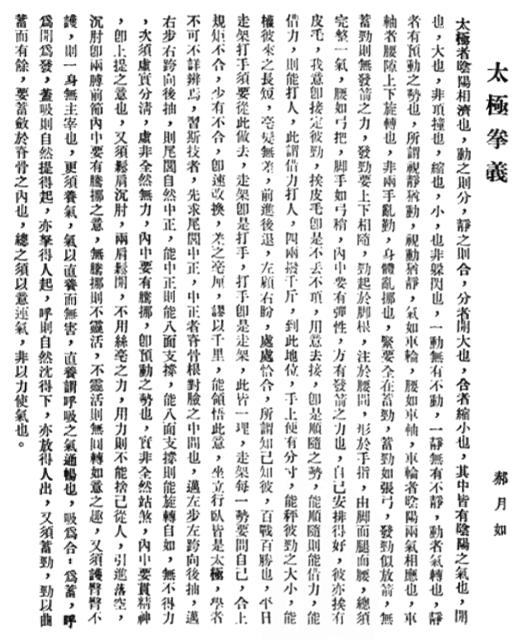
太極拳義 郝月如
THE MEANING OF TAIJI BOXING (by Hao Yueru)
太極者陰陽相濟也,動之則分,靜之則合,分者開大也,合者縮小也,其中皆有陰陽之氣也,開也,大也,非頂撞也,縮也,小,也非躱閃也,一動無有不動,一靜無有不靜,動者氣轉也,靜者有預動之勢也,所謂視靜猶動,視動猶靜,氣如車輪,腰如車軸,車輪者陰陽兩氣相應也,車軸者腰隙上下旋轉也,非兩手亂勤,身體亂挪也,緊要全在蓄勁,蓄勁如張弓,發勁似放箭,無蓄勁則無發箭之力,發勁要上下相隨,勁起於脚根,注於腰間,形於手指,由脚而腿而腰,總須完整一氣,腰如弓把,脚手如弓稍,內中要有彈性,方有發箭之力也,自己安排得好,彼亦挨有皮毛,我意卽接定彼勁,挨皮毛卽是不丢不頂,用意去接,卽是順隨之勢,能順隨則能借力,能借力,則能打人,此謂借力打人,四兩撥千斤,到此地位,手上便有分寸,能秤彼勁之大小,能權彼來之長短,毫髮無差,前進後退,左顧右盼,處處恰合,所謂知己知彼,百戰百勝也,平日走架打手須要從此做去,走架卽是打手,打手卽是走架,此皆一理,走架每一勢要問自己,合上規矩不合,少有不合,卽速改換,差之毫厘,謬以千里,能領悟此意,坐立行臥皆是太極,學者不可不詳辨焉,習斯技者,先求尾閭中正,中正者脊骨根對臉之中間也,邁左步左跨向後抽,邁右步右跨向後抽,則尾閭自然中正,能中正則能八面支撐,能八面支撐則能旋轉自如,無不得力,次須虛實分淸,虛非全然無力,內中要有騰挪,卽預動之勢也,實非全然站煞,內中要貫精神,卽上提之意也,又須鬆肩沉肘,兩肩鬆開,不用絲毫之力,用力則不能捨己從人,引進落空,沉肘卽兩膊前節內中要有騰挪之意,無騰挪則不靈活,不靈活則無圓轉如意之趣,又須護臀臀不護,則一身無主宰也,更須養氣,氣以直養而無害,直養謂呼吸之氣通暢也,吸為合,為蓄,呼為開為發,蓋吸則自然提得起,亦拏得人起,呼則自然沈得下,亦放得人出,又須蓄勁,勁以曲蓄而有餘,要蓄斂於脊骨之內也,總之須以意運氣,非以力使氣也。
By “taiji” is meant passive and active exchanging roles. “When there is movement, they become distinct from each other. When there is stillness, they return to being indistinguishable.” They become distinct while expanding and enlarging. They return to being indistinguishable while contracting and shrinking. Within it, it is always the two energies of passive and active. Expansion is enlarging but not colliding. Contraction is shrinking but not running away. “If one part moves, every part moves, and if one part is still, every part is still.” In movement, the energy transfers, and in stillness, there is a dynamic of being prepared to move again. And so it is said: “Regard movement as stillness and stillness as movement.” And also: “The energy is like a wheel. The waist is like an axle.” The wheel indicates passive and active responding to each other. The axle indicates the rotation occurring above and below your waist.
There is to be no random movement of your hands, nor any random shifting of your body. It is crucial to always be storing power. “Store power like drawing a bow. Issue power like loosing an arrow.” Without storing power, you will not have the power of an arrow being loosed. When issuing power, your upper body and lower have to be coordinated with each other. Power initiates from your heel, gets directed at your waist, and is expressed at your fingers. “From foot through leg through waist, it must be a fully continuous process.” Your waist is like a bow handle, and your feet and hands are like the bow tips. Within there should be a springy quality, and then you will have the power of an arrow being loosed.
If I am in good order myself, then when the opponent nears even the hairs on my skin, my intention connects firmly to his power. When he nears the hairs on my skin, I neither come away nor crash in, but use intention to reach out and connect, which is the energy of following. If you can follow an opponent, then you can borrow his power. If you can borrow his power, then you can attack him with it. This is what is meant by “borrowing his force to hit him with” and “using four ounces to move a thousand pounds”.
When you reach this state, “your hands on him will detect in finer detail, weighing the size of his power, assessing the length of his attack and not being off by the slightest bit, and you will advance and retreat (or move to either side), always at the right moment.” And so it is said: “Knowing both self and opponent, in a hundred battles you will have a hundred victories.”
In your daily practice of the solo set and playing hands, you must work from this precept: the solo set is the playing hands and the playing hands is the solo set, for they both follow the same principle. With every movement in the solo set, check on yourself to see if you are conforming to the rules as given above, and if you are even slightly off, immediately adjust. “Miss by an inch, lose by a mile.” When you can grasp these concepts, then whether sitting, standing, walking, or lying down – all will be Taiji. You must understand all this clearly.
In practicing this art, you must first seek to get your tailbone centered. When it is centered, your tailbone and the base of your spine are facing each other inwardly. When stepping with your left foot, your left hip shrinks back. When stepping with your right foot, your right hip shrinks back. In both cases your tailbone will then naturally be centered. If you can get it centered, then you can brace in every direction. If you can brace in every direction, then “you can turn smoothly and will be strong everywhere”.
Next you must distinguish emptiness and fullness. “Empty does not mean you are in that area completely weak”, for within there should be a readiness to move, a dynamic of being primed to act. “Full does not mean you are in that area completely stuck”, for within there should be a concentration of spirit, an intention of lifting upward.
You also must loosen your shoulders and sink your elbows. Your shoulders are to loosen and not use the slightest bit of effort. If they use effort, then you will not be able to let go of yourself and follow the opponent to thereby draw him into emptiness. By sinking your elbows, there will be within your forearms an intention of being ready to move. If there is no readiness to move, there will be no nimbleness, and if there is no nimbleness, there will be no quality of roundness and spontaneity.
It is also necessary to shield your belly. If your belly is not shielded, then your whole body will be without a commander.
It is also necessary to nurture energy. “By nurturing energy with integrity, it will not be corrupted.” To nurture energy with integrity means that you are not holding your breath. “Inhaling is contracting and storing. Exhaling is expanding and releasing. Since with inhaling there is a natural rising, take the opponent up. Since with exhaling there is a natural sinking, send the opponent away.” It is furthermore also necessary to store power. “By storing power in crooked parts, it will be in abundant supply.” Power must be collected within your spine. Always you must use intention to move energy, not use exertion to force energy.]
–
關於教法和練法的一些體會 郝少如
SOME THINGS I HAVE REALIZED REGARDING TEACHING AND PRACTICE (by Hao Shaoru)
我根據三十多年來練拳和教拳的經驗,認為無論是教或練,都必須首先從身法(武禹襄的八條身法)著眼,並且要由內及外。
身法是太極拳理論的主要內容之一。身法在教或練的過程中,既是最基本的,也始終是最重要的。因此,對身法必須要求嚴格。
練習太極拳,不要說達到精湛的功夫,即使是基本功夫,也不可能一蹴即得。所以在教或練的過程中,必須大致上分為兩個階段。
第一階段是練外形,就是學習拳架,注重身法。但是八條身法不是一下子就可以掌握的。要先選擇一、二條作為重點,練熟之後,再逐步增加。上下肢與身法的配合也極重要,因為配合得不好,會直接影響身法。上肢的配合還比較容易掌握,而下肢因為既要支持著身體的穩定,又要顧及分清虛實,對初學者來講,就更覺困難些。練成這八條身法之後,全身的肌肉骨骼才能靈活、協調,動作一致,才能達到隨心所欲的地步。
第二階段是練內形,亦稱內勁。先要以意識作指導,漸漸練成意、氣、拳架三者合一。由外形至內形,由氣粗到氣精。然後無外無內,無粗無精,渾然皆忘。練到這種境界,才能在不斷前進的道路上攀登太極拳藝高峰。對於淺嘗即止和憑空立異的人,是不足為訓的。
On the basis of my more than thirty years of experience in practicing and teaching this martial art, I believe that regardless of teaching or practicing, they both first must come from a focus on the body standards (Wu Yuxiang’s eight) and should happen internally to affect externally.
The body standards are a fundamental part of Taiji Boxing theory. In the course of either teaching or practicing, the body standards are the primary basics, of the highest importance from beginning to end. Therefore it is necessary to be strict about the body standards.
In practicing Taiji Boxing, you should never proclaim that you have achieved a great level of skill when what you are working on is only the basics. Nor will you be able to attain a skill after going through the motions only once. In fact the process, whether teaching or practicing, must be divide it into two phases:
The first phase is to train the external form, meaning learning the solo set, laying particular stress on the body standards. However, you cannot simply grasp the eight body standards all at once. You should first select a pair to emphasize, and after you have practiced them until they have become ingrained, then you may progressively add more. It is extremely important for your upper and lower limbs to cooperate with the body standards, because if they are not cooperating well, it will immediately affect the body standards. The cooperating of the upper limbs is comparatively easy to grasp, but the lower limbs, because they are already busy with being in charge of the body’s stability, as well as having the additional task of distinguishing empty and full, are, when explained to a beginner, simply going to be felt to be more difficult. After you have practiced the eight body standards to perfection, your whole body, flesh and bone, can be nimble and coordinated, moving as one unit, and you will be able to reach the condition in which you can do as you please.
The second phase is to train the internal form, namely the internal power. First you should consciously direct movement, but gradually through practice, the intention, energy, and solo set will merge into one. Go from external form to internal form, from coarse energy to refined energy. Then there will be no outside, no inside, no coarse, no refined – all these distinctions will become completely forgotten. Practicing until you reach such a state, you will be able to unceasingly advance as you climb to the peak of the art of Taiji Boxing. As regards those who dabble in it and then quit, and those who come up with their own groundless interpretations, they are not to be taken seriously.
–
節序圖說明
EXPLANATION OF THE CYCLE-OF-FOUR DIAGRAMS
武式太極拳的所有動作都是按起、承、開、合的節序來編排的。以四個動作結為一個起、承、開、合的節序。如第二式“左懶扎衣”的四動,也就是節序圖中的四圖,圖1是“起”,圖2是“承”,圖3是“開”,圖4是“合”,結為一個節序。整個拳套都是一個個節序銜接編排而成的。在一個個節序之間,雖有稍頓的現象,但要保持勁斷意不斷,內部仍要綿綿不斷地銜接起來,所以在練習時不可因節序而中斷。
一個節序大都是由一個拳式構成的,如上面所舉的“左懶扎衣”有四動,成一個節序。但也有兩個,甚至四或五個拳式結成一個節序,例如拳套中的第四式“單鞭”和第五式“提手上勢”,兩式合併在一起編為四動,結為一個節序。
All the movements in Wu Yuxiang Style Taiji Boxing are arranged according to the “cycle of four” – begin, develop, express, and finish – four movements making one cycle of four. In the case of the four movements of LAZILY PULLING BACK THE ROBE – LEFT, which follow in the drawings below, Drawing 1 is “begin”, Drawing 2 is “develop”, Drawing 3 is “express”, and Drawing 4 is “finish”, making one cycle of four.
The whole solo set is made by linking up the cycles of four. Within each cycle of four, although there appear to be slight pauses, the principle of the power finishing but the intention continuing should be maintained, internally connecting the movements together without a break, so that when practicing, a cycle of four must not be caused to have an interrupted flow.
For the most part, one posture makes one cycle of four, as in the case of the four movements of LAZILY PULLING BACK THE ROBE – LEFT, but sometimes two postures, or even four or five, make a cycle of four, as in the case of SINGLE WHIP and RAISE THE HAND, two postures which when joined together make four movements, making one cycle of four.
–
節序圖舉例
CYCLE-OF-FOUR ILLUSTRATED EXAMPLE:
第二式 左懶扎衣
Posture 2: LAZILY PULLING BACK THE ROBE – LEFT
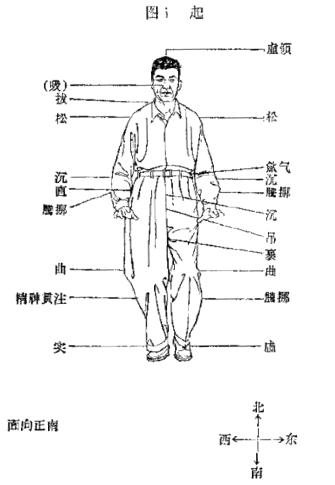
圖1 起
Diagram 1 – Begin
虛領 Forcelessly rouse [your headtop].
(吸)(inhale [through your nose])
拔 Pluck up [your back].
鬆 [Your right shoulder is] relaxed.
鬆 [Your left shoulder is] relaxed.
斂氣 Collect energy [in your lower back].
沉 [Your right elbow is] heavy.
沉 [Your left elbow is] heavy.
直 Straighten [your right hip].
騰挪 There is readiness to move [in your right arm].
騰挪 There is readiness to move [in your left arm].
沉 Sink [energy to your elixir field].
吊 Suspend [your crotch].
裹 Wrap [your crotch].
曲 [Your right knee is] bent.
曲 [Your left knee is] bent.
精神貫注 Spirit is concentrated [in the full leg].
騰挪 There is readiness to move [in the empty leg].
實 [Your right foot is] full.
虛 [Your left foot is] empty.
面向正南
You are facing south. [This does not mean you must literally face south, merely that “south” is whatever direction you happen to be facing in the initial posture, and the orientations of the rest of the postures are then in accordance with the initial imaginary direction marker of “south”.]
北
↑
西←—│—→東
↓
南
N
W + E
S
–

圖2 承
Diagram 2 – Develop
虛領 Forcelessly rouse [your headtop].
(吸)(inhale)
拔 Pluck up [your back].
鬆 [Your right shoulder is] relaxed.
鬆 [Your left shoulder is] relaxed.
意向上升 [Your left hand] inclines upward.
騰挪 There is readiness to move [in your right arm].
騰挪 There is readiness to move [in your left arm].
沉 [Your right elbow is] heavy.
沉 [Your left elbow is] heavy.
意向上升 [Your right hand] inclines upward.
斂氣 Collect energy [in your lower back].
直 Straighten [your right hip].
沉 Sink [energy to your elixir field].
吊 Suspend [your crotch].
裹 Wrap [your crotch].
曲 [Your right knee is] bent.
曲 [Your left knee is] bent.
精神貫注 Spirit is concentrated [in the full leg].
騰挪 There is readiness to move [in the empty leg].
實 [Your right foot is] full.
虛 [Your left foot is] empty.
面向東南 左腳向東南放出 左胯向回抽 要尾閭正中
Face to the southeast. Your left foot steps to the southeast. Your left hip shrinks in. Your tailbone should be centered.
–

圖3 開
Diagram 3 – Express
虛領 Forcelessly rouse [your headtop].
(呼)(exhale [through your nose])
拔 Pluck up [your back].
鬆 [Your right shoulder is] relaxed.
鬆 [Your left shoulder is] relaxed.
意向上升 [Your left hand] inclines upward.
騰挪 There is readiness to move [in your right arm].
騰挪 There is readiness to move [in your left arm].
沉 [Your right elbow is] heavy.
沉 [Your left elbow is] heavy.
意向上升 [Your right hand] inclines upward.
斂氣 Collect energy [in your lower back].
沉 Sink [energy to your elixir field].
直 Straighten [your right hip].
裹 Wrap [your crotch].
曲 [Your right knee is] bent.
曲 [Your left knee is] bent.
騰挪 There is readiness to move [in the empty leg].
精神貫注 Spirit is concentrated [in the full leg].
虛 [Your right foot is] empty.
實 [Your left foot is] full.
面向東南 左腿弓 右腿蹬
Facing to the southeast, your left leg bends and your right leg presses.
–
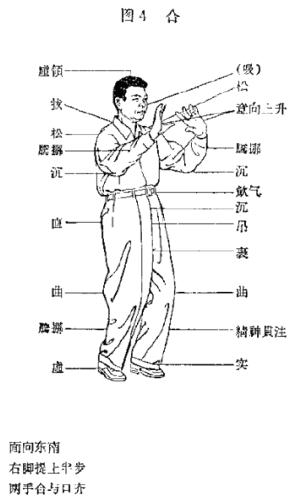
圖4 合
Diagram 4 – Finish
虛領 Forcelessly rouse [your headtop].
(吸)(inhale)
拔 Pluck up [your back].
鬆 [Your right shoulder is] relaxed.
鬆 [Your left shoulder is] relaxed.
意向上升 [Your hands] incline upward.
騰挪 There is readiness to move [in right your arm].
騰挪 There is readiness to move [in your left arm].
沉 [Your right elbow is] heavy.
沉 [Your left elbow is] heavy.
斂氣 Collect energy [in your lower back].
沉 Sink [energy to your elixir field].
直 Straighten [your right hip].
吊 Suspend [your crotch].
裹 Wrap [your crotch].
曲 [Your right knee is] bent.
曲 [Your left knee is] bent.
騰挪 There is readiness to move [in the empty leg].
精神貫注 Spirit is concentrated [in the full leg].
虛 [Your right foot is] empty.
實 [Your left foot is] full.
面向東南 右腳提上半步 兩手合與口齊
Facing southeast, your right foot lifts and goes forward a half step, your hands coming together at mouth level.
–
第二章 武式太極拳圖解
CHAPTER TWO: WU YUXIANG STYLE TAIJI BOXING ILLUSTRATED
武式太極拳拳式名稱順序
WU YUXIANG STYLE TAIJI BOXING POSTURE NAMES IN SEQUENCE
第一式 預備式
Posture 1: PREPARATION POSTURE
第二式 左懶扎衣
Posture 2: LAZILY PULLING BACK THE ROBE – LEFT
第三式 右懶扎衣
Posture 3: LAZILY PULLING BACK THE ROBE – RIGHT
第四式 單鞭
Posture 4: SINGLE WHIP
第五式 提手上勢
Posture 5: RAISE THE HAND
第六式 白鵝亮翅
Posture 6: WHITE GOOSE SHOWS ITS WINGS
第七式 摟膝拗步
Posture 7: BRUSH KNEE IN A CROSSED STANCE
第八式 手揮琵琶勢
Posture 8: PLAY THE LUTE
第九式 摟膝拗步
Posture 9: BRUSH KNEE IN A CROSSED STANCE
第十式 手揮琵琶勢
Posture 10: PLAY THE LUTE
第十一式 上步搬攬捶
Posture 11: STEP FORWARD, PARRY, TAKE IN, PUNCH
第十二式 如封似閉
Posture 12: SEALING SHUT
第十三式 抱虎推山
Posture 3: CAPTURE THE TIGER AND PUSH IT BACK TO ITS MOUNTAIN
第十四式 手揮琵琶勢
Posture 14: PLAY THE LUTE
第十五式 右懶扎衣
Posture 15: LAZILY PULLING BACK THE ROBE – RIGHT
第十六式 單鞭
Posture 16: SINGLE WHIP
第十七式 提手上勢
Posture 17: RAISE THE HAND
第十八式 肘底看捶
Posture 18: GUARDING PUNCH UNDER THE ELBOW
第十九式 左倒攆猴
Posture 19: TURN LEFT TO DRIVE AWAY THE MONKEY
第二十式 右倒攆猴
Posture 20: TURN RIGHT TO DRIVE AWAY THE MONKEY
第二十一式 左倒攆猴
Posture 21: TURN LEFT TO DRIVE AWAY THE MONKEY
第二十二式 右倒攆猴
Posture 22: TURN RIGHT TO DRIVE AWAY THE MONKEY
第二十三式 手揮琵琶勢
Posture 23: PLAY THE LUTE
第二十四式 白鵝亮翅
Posture 24: WHITE GOOSE SHOWS ITS WINGS
第二十五式 摟膝拗步
Posture 25: BRUSH KNEE IN A CROSSED STANCE
第二十六式 手揮琵琶勢
Posture 26: PLAY THE LUTE
第二十七式 按勢
Posture 27: PUSHING DOWN
第二十八式 青龍出水
Posture 28: BLUE DRAGON LEAVES THE WATER
第二十九式 翻身
Posture 29: TURN AROUND
第三十式 三甬背
Posture 30: THREE THROUGH THE BACK
第三十一式 單鞭
Posture 31: SINGLE WHIP
第三十二式 下勢
Posture 32: LOWERING
第三十三式 紜手
Posture 33: TANGLING HANDS
第三十四式 單鞭
Posture 34: SINGLE WHIP
第三十五式 提手上勢
Posture 35: RAISE THE HAND
第三十六式 高探馬
Posture 36: RISING UP AND REACHING OUT TO THE HORSE
第三十七式 左伏虎勢
Posture 37: SUBDUE THE TIGER – LEFT
第三十八式 右起腳
Posture 38: RIGHT LIFTING KICK
第三十九式 右伏虎勢
Posture 39: SUBDUE THE TIGER – RIGHT
第四十式 左起腳
Posture 40: LEFT LIFTING KICK
第四十一式 轉身蹬腳
Posture 41: TURN AROUND, PRESSING KICK
第四十二式 單鞭
Posture 42: SINGLE WHIP
第四十三式 踐步打捶
Posture 43: STEP SUCCESSIVELY, PUNCH
第四十四式 翻身二起
Posture 44: TURN AROUND, DOUBLE KICK
第四十五式 披身
Posture 45: DRAPE THE BODY
第四十六式 退步踢腳
Posture 46: STEP BACK, SNAPPING KICK
第四十七式 轉身蹬腳
Posture 47: TURN AROUND, PRESSING KICK
第四十八式 上步搬攬捶
Posture 48: STEP FORWARD, PARRY, TAKE IN, PUNCH
第四十九式 如封似閉
Posture 49: SEALING SHUT
第五十式 抱虎推山
Posture 50: CAPTURE THE TIGER AND PUSH IT BACK TO ITS MOUNTAIN
第五十一式 手揮琵琶勢
Posture 51: PLAY THE LUTE
第五十二式 右懶扎衣
Posture 52: LAZILY PULLING BACK THE ROBE – RIGHT
第五十三式 斜單鞭
Posture 53: DIAGONAL SINGLE WHIP
第五十四式 下勢
Posture 54: LOWERING
第五十五式 野馬分鬃
Posture 55: WILD HORSE PARTS ITS MANE
第五十六式 單鞭
Posture 56: SINGLE WHIP
第五十七式 玉女穿梭
Posture 57: MAIDEN WORKS THE SHUTTLE
第五十八式 手揮琵琶勢
Posture 58: PLAY THE LUTE
第五十九式 右懶扎衣
Posture 59: LAZILY PULLING BACK THE ROBE – RIGHT
第六十式 單鞭
Posture 60: SINGLE WHIP
第六十一式 下勢
Posture 61: LOWERING
第六十二式 紜手
Posture 62: TANGLING HANDS
第六十三式 單鞭
Posture 63: SINGLE WHIP
第六十四式 下勢
Posture 64: LOWERING
第六十五式 更雞獨立
Posture 65: ROOSTER STANDS ON ONE LEG
第六十六式 左倒攆猴
Posture 66: TURN LEFT TO DRIVE AWAY THE MONKEY
第六十七式 右倒攆猴
Posture 67: TURN RIGHT TO DRIVE AWAY THE MONKEY
第六十八式 左倒攆猴
Posture 68: TURN LEFT TO DRIVE AWAY THE MONKEY
第六十九式 右倒攆猴
Posture 69: TURN RIGHT TO DRIVE AWAY THE MONKEY
第七十式 手揮琵琶勢
Posture 70: PLAY THE LUTE
第七十一式 白鵝亮翅
Posture 71: WHITE GOOSE SHOWS ITS WINGS
第七十二式 摟膝拗步
Posture 72: BRUSH KNEE IN A CROSSED STANCE
第七十三式 手揮琵琶勢
Posture 73: PLAY THE LUTE
第七十四式 按勢
Posture 74: PUSHING DOWN
第七十五式 青龍出水
Posture 75: BLUE DRAGON LEAVES THE WATER
第七十六式 翻身
Posture 76: TURN AROUND
第七十七式 三甬背
Posture 77: THREE THROUGH THE BACK
第七十八式 單鞭
Posture 78: SINGLE WHIP
第七十九式 下勢
Posture 79: LOWERING
第八十式 紜手
Posture 80: TANGLING HANDS
第八十一式 單鞭
Posture 81: SINGLE WHIP
第八十二式 提手上勢
Posture 82: RAISE THE HAND
第八十三式 高探馬
Posture 83: RISING UP AND REACHING OUT TO THE HORSE
第八十四式 對心掌
Posture 84: PALM TO THE SOLAR PLEXUS
第八十五式 轉身十字擺連
Posture 85: TURN AROUND, CROSSED-BODY SWINGING LOTUS KICK
第八十六式 上步指襠捶
Posture 86: STEP FORWARD, PUNCH TO THE CROTCH
第八十七式 右懶扎衣
Posture 87: LAZILY PULLING BACK THE ROBE – RIGHT
第八十八式 單鞭
Posture 88: SINGLE WHIP
第八十九式 下勢
Posture 89: LOWERING
第九十式 上步七星
Posture 90: STEP FORWARD WITH THE BIG DIPPER
第九十一式 退步跨虎
Posture 91: RETREAT TO SITTING TIGER POSTURE
第九十二式 轉腳擺連
Posture 92: REVOLVING-BASE SWINGING LOTUS KICK
第九十三式 彎弓射虎
Posture 93: BEND THE BOW TO SHOOT THE TIGER
第九十四式 雙抱捶
Posture 94: DOUBLE PUNCH
第九十五式 手揮琵琶勢
Posture 95: PLAY THE LUTE
第九十六式 收勢
Posture 96: CLOSING POSTURE
–
關於圖解的幾點說明
EXPLAINING A FEW FEATURES OF THE DRAWINGS
1.本圖解的圖照是按作者拳照摹繪的。
These drawings are modeled upon photos of the author.
2.為了便於讀者查對拳式的方向,把圖照中預備式(圖1)姿勢的方向假定為:面向讀者等於向南,背後等於向北,面向讀者右面等於向東,面向讀者左面等於向西。當讀者練習純熟後,可以根據場地形狀任選方向,預備式不一定從面向南開始。
To make it easier for you to check the orientation of the postures, grant the PREPARATION POSTURE (drawing 1) to be thus: before you is “south”, behind you is “north”, to your right [left] is “east”, to your left [right] is “west”. Once you have gotten used to it, you can practice according to any orientation and need not begin by facing “south”.
3.圖中所有的實線或虛線,均表示手或腳的動作趨向。所有圖中的箭頭,均表示由本圖過渡到下一圖的動作趨向。凡動作較簡單,通過文子即可說明的,就不再在圖中表示其動作趨向,可參看文字和後一圖。
Within these drawings, the full lines and dotted lines show the movement of hands and feet. The arrows show the direction of movement from the original drawing to the following drawing. Every movement is quite simple and can be explained through the text, so when a drawing is insufficient to indicate a movement, the text can be referred to and then combined with the drawing.
4.帶有實線的箭頭表示右手或右腳的動作趨向,帶有虛線的箭頭表示左手或左腳的動作趨向。
The arrow on a full line shows the direction for your right hand or right foot’s movement, and the arrow on a dotted line shows the direction for your left hand or left foot’s movement.
5.由於太極拳中腳的動作甚為細緻,為了表明腳與地面的角度,在腳旁繪上陰影,以資區別。
The footwork in Taiji Boxing is quite meticulous, therefore in order to show an angle between the foot and the ground, shadowing has been drawn beside the foot as a means of distinguishing:
表示全腳著地
This indicates the whole foot is touching the ground:

腳旁無陰影者,表示全腳離地
When there is no shadow beside the foot, it indicates the whole foot is off of the ground:

表示腳跟著地
This indicates the heel is touching the ground:

表示腳尖著地
This indicates the toes are touching the ground:

–
武式太極拳圖解
WU YUXIANG STYLE TAIJI BOXING ILLUSTRATED
第一式 預備式(圖1)
Posture 1: PREPARATION POSTURE
兩足並立(中間距離一拳左右),兩膝微彎勿挺;兩臂自然下垂;兩眼向前平視。(圖1)
Your feet are standing next to each other (with one fist’s distance between your heels), and your knees are slightly bent but not sticking out. Your arms are hanging down naturally. Your eyes are looking straight ahead. See drawing 1:

要求在兩足並立站定時,要做到體態自然安靜;要提起全副精神,排除雜念;意含頂勁,所以頭宜正直,頦微內收;兩肩放鬆;腹部鬆弛,氣沉丹田;涵胸,拔背,裹襠,護肫。
While your feet are standing next to each other, seek to attain an easy and tranquil manner. Fully rouse your spirit and be rid of random thoughts. Confine your intention to pressing up your headtop, so that your head will be appropriately upright and your chin slightly drawn in. Loosen your shoulders. Loosen your abdomen and sink energy to your elixir field. Contain your chest, pluck up your back, wrap your crotch, and shield your belly.
第二式 左懶扎衣(圖2─5)
Posture 2: LAZILY PULLING BACK THE ROBE – LEFT
動作一:兩腿屈膝微蹲,體重漸漸移至右腿,右腿變實,左足跟提起,足尖點地,左腿變虛;同時兩臂稍彎,兩手前移,置於胯旁,手背向上,手指朝前,微屈分開。(圖2)
Movement 1:
Your legs bend at the knees and slightly squat, the weight gradually shifts to your right leg, which becomes full, your left heel lifts, toes touching down, and your left leg becomes empty. At the same time, your arms slightly bend, and your hands shift forward to be placed beside your hips, the backs of the hands up, fingers pointing forward, slightly bent and spread. See drawing 2:
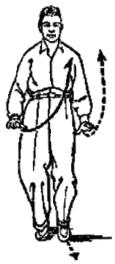
在武式太極拳的拳套中,所有動作和姿勢的兩臂和兩腿始終不可伸直,要保持一定的彎度;身體轉動時,都必須以實腿足跟為軸;並且所有動作的頭、軀幹、胸、背等部分,都須符合預備式的要求,後文不再贅述。
Within the Wu Yuxiang Style Taiji Boxing solo set, in every movement and posture, your arms and legs must never stretch straight, but instead must always maintain a definite bend. During turns, you must always use the heel of the full leg as a pivot. The movements of your head, trunk, chest, and so on, must always conform to the requirements of the PREPARATION posture, which from this point will not be necessary to repeat.
動作二:身體微向左轉,左足隨著提起,向左斜角(45度斜角,以後所指斜角皆為45度)邁出,足尖上翹,以足跟著地,左腿微屈(兩腿仍為左虛右實);同時兩手向胸前舉起,手指朝上成立掌,左手在外,高與口平;右手在裡,與心相齊,手心均稍朝前(兩肘須下沉);面對東南斜方。(圖3)
Movement 2:
Your body slightly turns to the left, your left foot then lifts and steps out to the left corner (all mentions of corner to be taken as orientations of forty-five degrees), toes up, heel touching down, leg slightly bent (your legs still left empty, right full). At the same time, your hands raise in front of your chest, fingers pointing up to make the palms upright, left hand outside at mouth level, right hand inside at solar plexus level, both palms slightly facing forward (and your elbows must be sinking down). You are facing to the southeast corner. See drawing 3:

動作三:右足跟蹬,左腿前弓,左足掌落平,體重移至左腿,右腿微屈,兩腿變為左實右虛;同時兩手向前徐徐推出(上身不可前俯後仰;要求鬆肩,沉肘),手心仍稍向前,左手齊目,右手與胸平。(圖4)
Movement 3:
Your right heel presses, your left leg bends forward, sole flattening, the weight shifts to your left leg, right leg slightly bent, and your legs have become left full, right empty. At the same time, your hands slowly push out forward (but your upper body must not lean forward or back, and you should loosen your shoulders and sink your elbows), palms still slightly forward, left hand at eye level, right hand at chest level. See drawing 4:

動作四:兩手同時下落,當兩手與胯相平時(在兩手下落時,兩肘不可向後超出背部)即左右分開,向上划弧,立掌合於胸前,有捧球之意,兩手高與口平,手心稍朝前;右足在兩手左右分開的同時,往前跟步至左足跟旁,以足尖點地。(圖5)
Movement 4:
Your hands lower in unison, and once they are at hip level (When your hands come down, your elbows must not go beyond your back.), they separate to the sides, arc upward, and come together as upright palms in front of your chest with an intention of holding a ball, your hands at mouth level, palms slightly facing forward. While your hands are spreading apart, your right foot is doing a follow step to be beside your left heel, toes touching down. See drawing 5:

要求鬆肩,沉肘;手與胸臂之間有圓活之趣;兩腿仍為左實右虛。
Seek to loosen your shoulders and sink your elbows. There should be a quality of roundness and liveliness between your hands, chest, and arms. Your legs are still left full, right empty.
第三式 右懶扎衣(圖6─9)
Posture 3: LAZILY PULLING BACK THE ROBE – RIGHT
動作一:以左足跟為軸(右足尖仍點地),身體微向右轉,面對正南方向,兩腿仍為左實右虛。(圖6)
Movement 1:
Using your left heel as a pivot (right toes still touching down), your body slightly turns to the right to be facing to the south. Your legs are still left full, right empty. See drawing 6:

動作二:腰微右旋,右足隨著向右斜角邁出,足尖上翹,以足跟著地,右腿微屈(兩腿仍為左實右虛);同時左手由上而下,右手由下而上划一小圈,仍為立掌(手指朝上),右手在外,高與口平、左手在裡,與心相齊,手心均稍朝前(兩肘須下沉);面對西南斜方。(圖7)
Movement 2:
Your waist slightly turns to the right, your right foot then steps out to the right corner, toes up, heel touching down, leg slightly bent (your legs still left full, right empty). At the same time, your left hand goes down from above as your right hand goes up from below in a small circle, still as upright palms (fingers upward), right hand outside at mouth level, left hand inside at solar plexus level, palms slightly facing forward (elbows down). You are facing to the southwest corner. See drawing 7:

動作三、四與第二式“左懶扎衣”動作三、四相同,惟左右相反,方向不同。本式方向是向西南斜方。(圖8─9)
Movement 3 and 4 are the same as in Posture 2, except that left and right are reversed and the orientation is different, this time to the southwest corner. See drawings 8&9:


第四式 單鞭(圖10─12)
Posture 4: SINGLE WHIP
第五式 提手上勢(圖13)
Posture 5: RAISE THE HAND
兩式合併為一個節序(什麼叫節序,請參看節序圖說明)。動作一、二、三為“單鞭”,動作四為“提手上勢”。
These two postures combine to form a cycle of four (For what a “cycle of four” is, consult the Explanation of the Cycle-of-Four Diagrams above.): movements 1-3 are SINGLE WHIP, and movement 4 is RAISE THE HAND.
動作一:以右足跟為軸(左足尖仍點地),身體左轉90度,面對東南斜方,仍為右腿實、左腿虛。(圖10)
Movement 1:
Using your right heel as a pivot (left toes still touching down), your body turns ninety degrees to the left to be facing to the southeast corner, your legs still right full, left empty. See drawing 10:
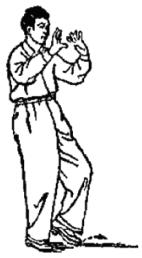
動作二:左足邁出,足尖上翹,以足跟著地,兩腿仍為左虛右實。(圖11)
Movement 2:
Your left foot steps out, toes up, heel touching down, your legs still left empty, right full. See drawing 11:

動作三:右足跟蹬,左腿前弓,左足掌落平,右腿微屈,兩腿變為左實右虛;同時兩手向左右順腿分開,手指朝上,掌心朝外,仍為立掌,左手齊目,右手齊口(兩肘須下沉);面對東稍偏於南的斜方。(圖12)
Movement 3:
Your right heel presses, your left leg bends forward, sole flattening, right leg slightly bent, and your legs have become left full, right empty. At the same time, your hands separate to the sides over your legs, fingers up, palms facing out, palms still upright, left hand at eye level, right hand at mouth level (elbows down). You are facing to the east and slightly south. See drawing 12:

動作四:右腿向左靠攏,以右足尖點於左足旁(兩腿仍為左實右虛);同時身體微向右轉,面對正南方向;兩手隨動,右手朝下向左划弧,從下抄起,置於腹前,手指向前;左手向上舉,手心朝上,有上托之意,高與頂齊(須鬆肩,沉肘)。(圖13)
Movement 4:
Your right leg closes to the left, toes touching down beside your left foot (your legs still left full, right empty). At the same time, your body slightly turns to the right to be facing to the south. Your hands go along with the movement, your right hand facing down and arcing to the left, scooping up from below to be placed in front of your belly, fingers forward, as your left hand raises, palm facing up, with an intention of propping up, to headtop level (and you must be loosening your shoulders and sinking your elbows). See drawing 13:

第六式 白鵝亮翅(圖14─17)
Posture 6: WHITE GOOSE SHOWS ITS WINGS
動作一:右足尖仍點地,以左腳跟為軸,身體微向右轉,面對西南斜方,兩腿仍為左實右虛。(圖14)
Movement 1:
With your right toes still touching down, and using your left heel as a pivot, your body slightly turns to the right to be facing to the southwest corner, your legs still left full, right empty. See drawing 14:

動作二:右足前邁,足尖上翹,以足跟著地,右腿微屈(兩腿仍為左實右虛);同時右手自外提起,橫掌舉至額前上方,手心朝前;左手由裡面經臉前立掌下落,高與心齊(須鬆肩,沉肘)。(圖15)
Movement 2:
Your right foot steps forward, toes up, heel touching down, leg slightly bent (your legs still left full, right empty). At the same time, your right hand lifts up outward, raising as a sideways palm to arrive in front of and above your forehead, palm facing forward, as your left hand lowers inward, passing in front of your face as an upright palm, to solar plexus level (shoulders loosening, elbows sinking). See drawing 15:

動作三:左足跟蹬,右腿前弓,右足掌落平,兩腿變為右實左虛;同時左手向前徐徐推出(上身不可前俯後仰),左手高與胸齊,手心稍朝前(右手須有上翻之意,要求鬆肩,沉肘)。(圖16)
Movement 3:
Your left heel presses, your right leg bends forward, sole flattening, and your legs have become right full, left empty. At the same time, your left hand slowly pushes out forward (without your upper body leaning forward or back) at chest level, palm slightly facing forward. (Your right hand has an intention of turning upward. Loosen your shoulders and sink your elbows.) See drawing 16:
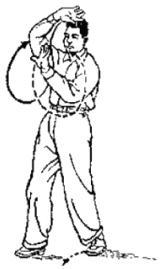
動作四:右手微向前伸,肘下垂,兩手同時下落,當兩手與胯相平時(在兩手下落時,兩肘不可向後超出背部)即左右分開,向上划弧,立掌合於胸前,有捧球之意,兩手高與口平,手心稍朝前;左足在兩手左右分開的同時,往前跟步至右足跟旁,以足尖點地;面對右前斜角。(圖17)
Movement 4:
Your right hand slightly extends forward, elbow hanging down, and your hands lower in unison, then once they are level with your hips (When your hands come down, the elbows must not go past your back.), they separate to the sides, arc upward, and come together as upright palms in front of your chest with an intention of holding a ball. Your hands are at mouth level, palms slightly facing forward. As your hands separate to the sides, your left foot does a follow step to be beside your right heel, toes touching down. You are facing to the right corner. See drawing 17:

要求手與胸臂之間有圓活之趣;兩腿仍為右實左虛。
練習太極拳時,所有動作都始終要求鬆肩、沉肘,希讀者切記,後文不再贅述。
There should be a quality of roundness and liveliness between your hands, chest, and arms. Your legs are still right full, left empty.
When practicing Taiji Boxing, seek to loosen your shoulders and sink your elbows throughout every movement, and since I hope you will be keeping this in mind, it will from this point not be repeated unnecessarily.
第七式 摟膝拗步(圖18─21)
Posture 7: BRUSH KNEE IN A CROSSED STANCE
動作一:左足尖微移向左後點地,以右足跟為軸,身體向左轉135度,面對正東方向,兩腿仍為右實左虛。(圖18)
Movement 1:
Your left toes slightly shift to the left rear, and using your right heel as a pivot, your body turns a hundred and thirty-five degrees to the left to be facing to the east. Your legs are still right full, left empty. See drawing 18:

動作二:身體微向左轉,面對東北斜方;手足隨動,左足向左斜方邁出,足尖上翹,以足跟著地,左腿微屈,兩腿仍為右實左虛;左手落至腹前;右手向右面頰旁舉起,高與耳平,手指朝上,手心朝前;面對東北斜角。(圖19)
Movement 2:
Your body slightly turns to the left to be facing to the northeast corner. Your hands and feet go along with the movement, your left foot stepping to the left corner, toes up, heel touching down, leg slightly bent, your legs still right full, left empty. Your left hand lowers to be in front of your belly and your right hand raises beside your right cheek to ear level, fingers up, palm facing forward. You are facing to the northeast corner. See drawing 19:
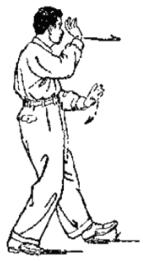
動作三:右足跟蹬,左腿前弓,左足掌落平,右腿微屈,兩腿變為左實右虛;同時左手向下摟過左膝,置於左腿旁,手指朝前;右手向前徐徐推出(上身不可前俯後仰),手指仍向上,高與目平;面仍對東北斜角。(圖20)
Movement 3:
Your right heel presses, your left leg bends forward, sole flattening, your right leg slightly bent, and your legs have become left full, right empty. At the same time, your left hand brushes downward past your left knee to be placed beside your left leg, fingers pointing forward, as your right hand slowly pushes out forward (without your upper body leaning forward or back), fingers still up, at mouth level. You are facing still to the northeast corner. See drawing 20:

動作四:右手下落經左腿旁(手指朝前)與左手相齊時,兩手左右分開向上划弧,立掌合於胸前,有捧球之意,兩手高與口平,手心稍朝前;在兩手左右分開的同時,右足往前跟步至左足跟旁,以足尖點地,兩腿仍為左實右虛。(圖21)
Movement 4:
Your right hand lowers, passing beside your left leg (fingers pointing forward), and when it is level with your left hand, both hands separate to the sides and arc upward to come together as upright palms in front of your chest with an intention of holding a ball, your hands at mouth level, palms slightly facing forward. While your hands separate to the sides, your right foot does a follow step to be beside your left heel, toes touching down, your legs still left full, right empty. See drawing 21:

第八式 手揮琵琶勢(圖22)
Posture 8: PLAY THE LUTE
第九式 摟膝拗步(圖23─26)
Posture 9: BRUSH KNEE IN A CROSSED STANCE
兩式合併為一個節序,動作一為“手揮琵琶勢”,動作二、三、四為“摟膝拗步”。
These two postures combine to form a cycle of four: movement 1 is PLAY THE LUTE, and movements 2-4 are BRUSH KNEE IN A CROSSED STANCE.
動作一:右足後退踏實,足尖對正東方向,左足收至右足前,以足尖點地,變為右腿實、左腿虛;同時兩手隨身收回,仍為立掌,左手仍與口平,右手落至腹前,兩手心均稍向前;面對東北斜方。(圖22)
Movement 1:
Your right foot steps back and flattens, toes pointing to the east, your left foot withdraws to be in front of your right foot, toes touching down, and your legs have become right full, left empty. At the same time, your hands follow your body and withdraw, palms still upright, left hand still at mouth level, right hand lowering to be in front of your belly, palms slightly facing forward. You are facing to the northeast corner. See drawing 22:

要求手與胸臂之間有圓活之趣。
There should be a quality of roundness and liveliness between your hands, chest, and arms.
動作二:左足向前邁出,足尖上翹,以足跟著地;兩手隨動,左手落至腹前,右手向右面頰旁舉起(如圖19姿勢)。接著右足跟蹬,右腿微屈,左足掌隨著落平,左腿前弓,變為左腿實、右腿虛;同時左手向下摟過左膝,置於左腿旁,手指朝前;右手向前徐徐推出(上身不可前俯後仰),手指仍朝上,高與目平;面對東北斜方。(圖23)
Movement 2:
Your left foot steps forward, toes up, heel touching down. Your hands go along with the movement, left hand lowering to be in front of your belly, right hand raising to be beside your right cheek (as in drawing 19). Then your right heel presses, the leg slightly bent, your left sole flattens, the leg bending forward, and your legs have become left full, right empty. At the same time, your left hand brushes downward past your left knee to be placed beside your left leg, fingers pointing forward, as your right hand slowly pushes out forward (without your upper body leaning forward or back), fingers still upward, at eye level. You are facing to the northeast corner. See drawing 23:

(附拗步)接著右足跨過左足,在左足外側平落踏實,兩腿變為右實左虛;同時左手上舉與口相平,右手下落置於胸前,兩手手指皆朝上,手心稍向前;面仍對東北斜方。(圖24)
(Add a twist step, as follows.) Your right foot steps past your left foot, flattening when it comes down to the outside of your left foot, and your legs have become right full, left empty. At the same time, your left hand raises up to mouth level and your right hand lowers to be placed in front of your chest, the fingers of both hands pointing upward, palms slightly facing forward. You are facing still to the northeast corner. See drawing 24:

動作三與本式動作二內“附拗步”之前的圖23說明相同。(圖25)
Movement 3 is the same as in drawing 23. See drawing 25:
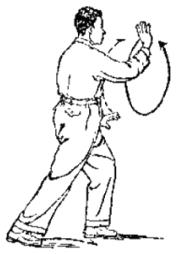
動作四與第七式“摟膝拗步”動作四圖21說明相同。(圖26)
Movement 4 is the same as in Posture 7. See drawing 26:

第十式 手揮琵琶勢(圖27)
Posture 10: PLAY THE LUTE
第十一式 上步搬攬垂(圖28─30)
Posture 11: STEP FORWARD, PARRY, TAKE IN, PUNCH
兩式合併為一個節序,動作一為“手揮琵琶勢”,動作二、三、四為“上步搬攬捶”。
These two postures combine to form a cycle of four: movement 1 is PLAY THE LUTE, and movements 2-4 are STEP FORWARD, PARRY, TAKE IN, PUNCH.
動作一與第八式“手揮琵琶勢”動作說明相同。(圖27)
Movement 1 is the same as in Posture 8. See drawing 27:

動作二:(左上步)左足仍向左前斜方邁出,足尖上翹,以足跟著地;兩手隨動,右手向右上方高舉過頂,手心朝左,五指稍舒,手指朝前;左手落至腹前,手指朝上,手心朝右。隨即右足跟蹬,左腿前弓,左足掌落平,右腿微屈,變為左腿實、右腿虛;同時兩手向前伸出(上身不可前俯後仰);面仍對東北斜方。(圖28)
Movement 2: (LEFT STEP FORWARD)
Your left foot again steps out to the left corner, toes up, heel touching down. Your hands go along with the movement, your right hand raising past your headtop, palm facing to the left, fingers slightly opened and pointing forward, as your left hand lowers to be in front of your belly, fingers pointing up, palm facing to the right. Then your right heel presses, your left leg bends forward, sole flattening, right leg slightly bent, and your legs have become left full, right empty. At the same time, your hands extend forward (without your upper body leaning forward or back). You are facing still to the northeast corner. See drawing 28:
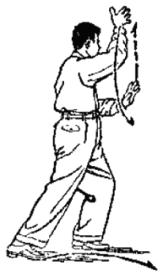
動作三:(右上步)以左足跟為軸,身體右轉;右足隨之提起經左足旁向右前斜方邁出,足尖上翹,以足跟著地;同時兩手隨動,左手向左上方高舉過頂,手心朝右,五指稍舒,手指朝上;右手向下經臉前直落至腹前,手指朝上,手心朝左。隨即左足跟蹬,右腿前弓,右足掌落平,左腿微屈,兩腿變為左虛右實;同時兩手向前伸出(上身不可前俯後仰);面對東南斜方。(圖29)
Movement 3:
(RIGHT STEP FORWARD)
Using your left heel as a pivot, your body turns to the right. Your right foot lifts, passes beside your left foot, and steps out to the right forward corner, toes up, heel touching down. At the same time, your hands go along with the movement, your left hand raising past your headtop, palm facing to the right, fingers slightly opened and pointing forward, your right hand lowering past your face to be in front of your belly, fingers pointing up, palm facing to the left. Then your left heel presses, your right leg bends forward, sole flattening, left leg slightly bent, and your legs have become left empty, right full. At the same time, your hands extend forward (without your upper body leaning forward or back). You are facing to the southeast corner. See drawing 29:

動作四:(搬攬捶)左手經臉前下落向左划弧,從下抄起,又向上向前落至腹前,手指朝上;左足隨著提起經右足旁向正東方向邁出,先以足跟著地;右手落至右胯旁握拳。隨即左足掌落平,左腿前弓,右足往前跟步,以足尖點於左足跟旁,變為左腿實、右腿虛;同時右拳沿左手手背上向前慢慢擊出(上身不可前俯後仰),拳眼朝上,高與心平;面對正東方向。(圖30)
Movement 4: (PARRY, TAKE IN, PUNCH)
Your left hand lowers past your face, arcs to the left, scoops up from below, going again up, forward, and down to be in front of your belly, fingers pointing up. At the same time, your left foot lifts, passes beside your right foot, and steps out to the east, your heel first touching down. Your right hand lowers to be beside your right hip and makes a fist. Then your left sole flattens, leg bending forward, your right foot does a follow step, toes touching down beside your left heel, and your legs have become left full, right empty. At the same time, your right fist slowly strikes forward over the back of your left hand (without your upper body leaning forward or back), the fist eye facing upward, at solar plexus level. You are facing to the east. See drawing 30:
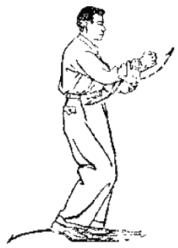
第十二式 如封似閉(圖31─34)
Posture 12: SEALING SHUT
動作一:左腿不動,右足右拳同時後移,右足退至左足後,足尖對右前斜方,右腿微屈,兩腿仍為左實右虛;右拳置於右胯旁,拳眼仍朝上;同時左手立掌上移至胸前,手心朝右;面仍對正東方向。(圖31)
Movement 1:
Your left leg does not move, but your right foot and right fist at the same time shift back, your right foot retreating behind your left foot, toes pointing to the right corner, leg slightly bent, your legs still left full, right empty. Your right fist is placed beside your right hip, the fist eye still upward. At the same time, your left hand as an upright palm shifts up to chest level, palm facing to the right. You are facing still to the east. See drawing 31:
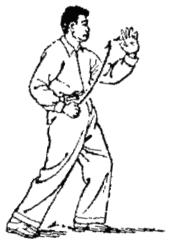
動作二:身體後移,右腿變實,左腿收回以足尖點於右足前,左腿變虛;同時右拳變掌上移與左手相並,成為立掌收至胸前,兩手心朝前。(圖32)
Movement 2:
Your torso shifts back, your right leg becomes full, your left leg withdraws, toes touching down in front of your right foot, becoming empty. At the same time, your right fist becomes a palm and shifts up to be beside your left hand, and as upright palms they withdraw in front of your chest, palms facing forward. See drawing 32:

動作三:左腿向前邁出,足尖上翹,以足跟著地,左腿微屈,仍為右腿實、左腿虛。(圖33)
Movement 3:
Your left leg steps out forward, toes up, heel touching down, leg slightly bent, your legs still right full, left empty. See drawing 33:

動作四:兩手向前徐徐平行推出,高與胸齊(上身不可前俯後仰);同時左腿前弓,左足掌落平,左腿變實,右足往前跟步,以足尖點於左足旁,右腿變虛(左足跟要有蹬出之意);面對正東方向。(圖34)
Movement 4:
Your hands slowly and equally push out forward at chest level (without your upper body leaning forward or back). At the same time, your left leg bends forward, sole flattening, becoming full, and your right foot does a follow step, toes touching down beside your left foot, becoming empty (and your left heel should have an intention of pressing). You are facing to the east. See drawing 34:

第十三式 抱虎推山(圖35─38)
Posture 13: CAPTURE THE TIGER AND PUSH IT BACK TO ITS MOUNTAIN
動作一:右足經左足跟後移至左足後面的左側點地,以左足跟為軸,身體向右後轉180度,面對正西方向,兩腿仍為左實右虛。(圖35)
Movement 1:
Your right foot passes your left heel to touch down behind and to the left side of your left foot, and using your left heel as a pivot, your body turns a hundred and eighty degrees to the right rear to be facing to the west. Your legs are still left full, right empty. See drawing 35:

動作二:身體微向右轉;手足隨動,右足向右前斜方邁出,足尖上翹,以足跟著地,右腿微屈,兩腿仍為左實右虛;右手落至腹前;左手向左面頰旁舉起,高與耳平,手指朝上,手心朝前;面對西北斜方。(圖36)
Movement 2:
Your body turns slightly to the right. Your hands and feet go along with the movement, your right foot stepping out to the right corner, toes up, heel touching down, leg slightly bent, your legs still left full, right empty, as your right hand lowers to be in front of your belly and your left hand raises beside your left cheek to ear level, fingers up, palm facing forward. You are facing to the northwest corner. See drawing 36:

動作三:左足跟蹬,右腿前弓、右足掌落平,變為右腿實、左腿虛;同時右手在腹前向左朝外平移划圈,至右邊腹前握拳,拳心朝胸部,右臂有抱虎之勢;左手立掌向前徐徐推出(上身不可前俯後仰),左手高與目平;面對西北斜方。(圖37)
Movement 3:
Your left heel presses, your right leg bends forward, sole flattening, and your legs have become right full, left empty. At the same time, your right hand at belly level goes to the left, facing outward, draws a flat circle to the right and makes a fist, the fist center facing your chest, your arm in a posture of embracing a tiger, and your left hand slowly pushes out forward as an upright palm (without your upper body leaning forward or back) at eye level. You are facing to the northwest corner. See drawing 37:

動作四:右拳拳心朝下下移,經右腿旁變掌,左手也隨著掌心朝下下落,當兩手下移相平時,兩手同時左右分開向上划弧,立掌合於胸前,有捧球之意,兩手高與口平,兩掌心稍朝前;左足在兩手左右分開的同時,往前跟步,至右足跟旁,以足尖點地,兩腿仍為右實左虛。(圖38)
Movement 4:
Your right fist turns so the center of the fist is facing down, shifts down beside your right leg, becoming a palm, as your left hand lowers, palm facing down, and when your hands are level, they separate to the sides and arc upward to come together as upright palms in front of your chest with an intention of holding a ball, the hands at mouth level, palms slightly facing forward. When your hands separate to the sides, your left foot does a follow step to be beside your right heel, toes touching down, your legs still right full, left empty. See drawing 38:

要求手與胸臂之間要有圓活之趣。
There should be a quality of roundness and liveliness between your hands, chest, and arms.
第十四式 手揮琵琶勢(圖39─40)
Posture 14: PLAY THE LUTE
第十五式 右懶扎衣(圖41─42)
Posture 15: LAZILY PULLING BACK THE ROBE – RIGHT
兩式合併為一個節序,動作一、二為“手揮琵琶勢”,動作三、四為“右懶扎衣”。
These two postures combine to form a cycle of four: movements 1 and 2 are PLAY THE LUTE and movements 3 and 4 are LAZILY PULLING BACK THE ROBE – RIGHT.
動作一:左足後退踏實,足尖朝西南斜方,右足收至左足前,以足尖點地,兩腿變為左實右虛;兩手隨身左轉,立掌收回至胸前,右手仍與口平,左手落至腹前,兩手心均稍朝前;面對正西方向。(圖39)
Movement 1:
Your left foot steps back and flattens, toes pointing to the southwest corner, your right foot withdraws to be in front of your left foot, toes touching down, and your legs have become left full, right empty. Your hands follow your body’s turn as upright palms withdrawing to be in front of your chest, right hand still at mouth level, left hand lowering to be in front of your belly, palms slightly facing forward. You are facing to the west. See drawing 39:

要求手與胸臂之間有圓活之趣。
There should be a quality of roundness and liveliness between your hands, chest, and arms.
動作二:右足向前邁出,足尖上翹,以足跟著地,右腿微屈,兩腿仍為左實右虛。(圖40)
Movement 2:
Your right foot steps out forward, toes up, heel touching down, leg slightly bent, your legs still left full, right empty. See drawing 40:
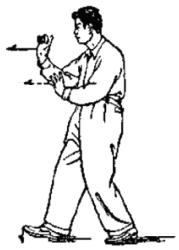
動作三、四與第三式“右懶扎衣”動作三、四相同,惟方向略異,本式是面對正西方向。(圖41─42)
Movement 3 and 4 are the same as in Posture 3, except the orientation is slightly different, this time facing west. See drawings 41&42:


第十六式 單鞭(圖43─45)
Posture 16: SINGLE WHIP
第十七式 提手上勢(圖46)
Posture 17: RAISE THE HAND
兩式合併為一個節序,動作一、二、三為“單鞭”,動作四為“提手上勢”。
These two postures combine to form a cycle of four: movements 1-3 are SINGLE WHIP and movement 4 is RAISE THE HAND.
動作一:左足提起,移至右足後面的左側點地,以右足跟為軸,身體向左後轉135度,面對東稍偏於南的斜方,兩腿仍為右實左虛。(圖43)
Movement 1:
Your left foot lifts, touches down to your right foot’s left rear, and using your right heel as a pivot, your body turns a hundred and thirty-five degrees to the left rear. You are facing to the east and slightly south. Your legs are still right full, left empty. See drawing 43:
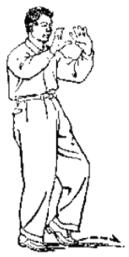
動作二、三與第四式“單鞭”動作二、三同。(圖44─45)
Movements 2 and 3 are the same as in Posture 4. See drawings 44&45:


動作四與第五式“提手上勢”動作相同,即與第四式和第五式合併的動作四相同。(圖46)
Movement 4 is the same as in Posture 5, as is the combining of Posture 4 with Posture 5. See drawing 46:

第十八式 肘底看捶(圖47─50)
Posture 18: GUARDING PUNCH UNDER THE ELBOW
動作一:右足向前邁出,足尖上翹,以足跟著地,仍為左腿實、右腿虛;同時右手舉至胸前,手指朝上,手心稍朝前。(圖47)
Movement 1:
Your right foot steps out forward, toes up, heel touching down, your legs still left full, right empty. At the same time, your right hand raises to be in front of your chest, fingers up, palm slightly facing forward. See drawing 47:

動作二:左足跟蹬,右腿前弓,右足掌落平,左腿微屈,變為右腿實、左腿虛;同時右手自胸前慢慢推出(上身不可前俯後仰);面對正南方向。(圖48)
Movements 2:
Your left heel presses, your right leg bends forward, sole flattening, left leg slightly bent, and your legs have become right full, left empty. At the same time, your right hand slowly pushes out forward from your chest (without your upper body leaning forward or back). You are facing to the south. See drawing 48:
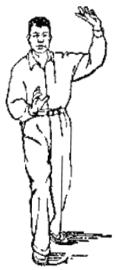
動作三:左腿不動,右足尖左轉90度,腰微左旋,對正東方向,兩腿仍為右實左虛。(圖49)
Movement 3:
Your left leg not moving, your right toes turn ninety degrees to the left, and your waist slightly turns to the left so you are facing to the east. Your legs are still right full, left empty. See drawing 49:

動作四:兩手握拳,身體向左轉朝正東方向;同時右拳置於左肘下,拳眼朝裡;左前臂隨著豎直,拳與頂齊,拳眼朝左(兩臂成直角之形);左足在身體左轉的同時,靠攏於右足跟旁,足跟提起,以足尖點地,兩腿仍為右實左虛。(圖50)
Movement 4:
Your hands make fists and your body turns to be facing squarely east. At the same time, your right fist is placed below your left elbow, fist eye facing inward, while your left forearm becomes vertical, fist at headtop level, fist eye facing to the left (your arms making the shape of a right triangle [the hypotenuse going from left fist to right elbow]). When your body turns to the left, your left foot draws beside your right heel, heel up, toes touching down, your legs still right full, left empty. See drawing 50:

第十九式 左倒攆猴(圖51─54)
Posture 19: TURN LEFT TO DRIVE AWAY THE MONKEY
動作一:兩拳變為立掌,手指朝上,手心朝外,左右分開,高與肩齊,左足微向後移點地,以右足跟為軸,身體左轉90度,右腿坐實,兩腿仍為右實左虛;面對正北方向;同時兩手相對合於胸前,兩手有捧球之意,高與口平。(圖51)
Movement 1:
Your fists become upright palms, fingers up, palms facing outward, separating to the sides to come up to shoulder level, as your left foot slightly shifts, touching down to the rear, and using your right heel as a pivot, your body turns ninety degrees, sitting full on your right leg, your legs still right full, left empty. You are facing to the north. When your hands come together in front of your chest, they have an intention of holding a ball, your hands at mouth level. See drawing 51:

要求手與胸臂之間要有圓活之趣。
There should be a quality of roundness and liveliness between your hands, chest, and arms.
動作二、三、四與第七式“摟膝拗步”動作二、三、四相同,惟方向角度不同,本式為正西方向。(圖52─54)
Movements 2-4 are the same as in Posture 7, except the orientation is different, this time to the west [northwest]. See drawings 52-54:
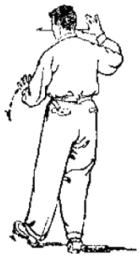


第二十式 右倒攆猴(圖55─58)
Posture 20: TURN RIGHT TO DRIVE AWAY THE MONKEY
動作一:右足提起,經左足後移至左足跟左側足尖點地,以左足跟為軸,身體向右後轉225度,面對正南方向,兩腿仍為左實右虛。(圖55)
Movement 1:
Your right foot lifts, and passes behind your left foot, toes touching down to the left side of your left heel, and using your left heel as a pivot, your body turns two hundred and twenty-five degrees to your right rear. You are facing to the south. Your legs are still left full, right empty. See drawing 55:

動作二:身體微向右轉,手足隨動,右足向右前斜方邁出,足尖上翹,以足跟著地,右腿微屈,兩腿仍為左實右虛;右手落至腹前;左手向左面頰旁舉起,高與耳平,手指朝上,手心朝外;面對西南斜方。(圖56)
Movement 2:
Your body slightly turns to the right, your hands and feet go along with the movement, your right foot stepping out to the right front corner, toes up, heel touching down, leg slightly bent, your legs still left full, right empty, as your right hand lowers to be in front of your belly and your left hand raises beside your left cheek to ear level, fingers up, palm facing outward [forward]. You are facing to the southwest corner. See drawing 56:

動作三:左足跟蹬,右腿前弓,右足掌落平,左腿微屈,變為右實左虛;同時右手向下摟過右膝,置於右腿旁;手指朝前;左手向前徐徐推出(上身不可前俯後仰),手指仍朝上,高與目平。(圖57)
Movement 3:
Your left heel presses, your right leg bends forward, sole flattening, left leg slightly bent, and your legs have become right full, left empty. At the same time, your right hand brushes downward past your right knee to be placed beside your right leg, fingers pointing forward, as your left hand slowly pushes out forward (without your upper body leaning forward or back), fingers still pointing up, at eye level. See drawing 57:

動作四:左手下落經右腿旁(手指朝前)與右手相齊時,兩手左右分開向上划弧,立掌合於胸前,有捧球之意,兩手高與口平,手心稍朝前;在兩手左右分開的同時,左足往前跟步至右足跟旁,以足尖點地,兩腿仍為右實左虛。(圖58)
Movement 4:
Your left hand lowers to pass beside your right leg (fingers pointing forward), and when it is level with your right hand, both hands separate to the sides and arc upward, coming together as upright palms in front of your chest with an intention of holding a ball, your hands at mouth level, palms slightly facing forward. As your hands separate to the sides, your left foot does a follow step to be beside your right heel, toes touching down, your legs still right full, left empty. See drawing 58:

第二十一式 左倒攆猴(圖59─62)
Posture 21: TURN LEFT TO DRIVE AWAY THE MONKEY
動作一:左足提起,經右足後移至右足跟右側,足尖點地,以右足跟為軸,身體向左後轉225度,面對正北方向,兩腿仍為右實左虛。(圖59)
Movement 1:
Your left foot lifts and passes behind your right foot, toes touching down to the right side of your right heel, and using your right heel as a pivot, your body turns two hundred twenty-five degrees to your right rear. You are facing to the north. Your legs are still left full, right empty. See drawing 59:

動作二、三、四與第七式、“摟膝拗步”動作二、三、四相同,惟方向角度不同,本式為西北方向。(圖60─62)
Movement 2-4 are the same as in Posture 7, except the orientation is different, this time to the northwest. See drawing 60-62:



第二十二式 右倒攆猴(圖63─66)
Posture 22: TURN RIGHT TO DRIVE AWAY THE MONKEY
動作一、二、三、四與第二十式“右倒攆猴”四動相同。(圖63─66)
Same as in Posture 20. See drawing 63-66:

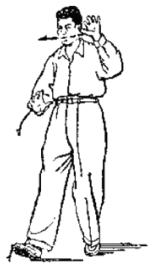


第二十三式 手揮琵琶勢(圖67)
Posture 23: PLAY THE LUTE
第二十四式 白鵝亮翅(圖68─70)
Posture 24: WHITE GOOSE SHOWS ITS WINGS
兩式合併為一個節序,動作一為“手揮琵琶勢”,動作二、三、四為“白鵝亮翅”。
These two postures combine to form a cycle of four: movement 1 is PLAY THE LUTE and movements 2-4 are WHITE GOOSE SHOWS ITS WINGS.
動作一:左足後退踏實,足尖對正南方向;右足收至左足前,以足尖點地,變為左腿實、右腿虛;同時兩手立掌隨身體收回,右手收至胸前,與口相平,左手落至腹前,兩手心均稍朝前;面對西南斜方。(圖67)
Movement 1:
Your left foot steps back and flattens, toes pointing to the south. Your right foot withdraws in front of your left foot, toes touching down, and your legs have become left full, right empty. At the same time, your hands follow your body’s withdraw, your right hand withdrawing to be in front of your chest at mouth level, your left hand lowering to be in front of your belly, palms slightly facing forward. You are facing to the southwest corner. See drawing 67:
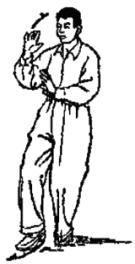
要求手與胸臂之間有圓活之趣。
There should be a quality of roundness and liveliness between your hands, chest, and arms.
動作二:右足向前邁出,足尖上翹,以足跟著地,右腿微屈,兩腿仍為左實右虛;同時右手舉至額前上方,橫掌,手心朝前;左手移至心前,手指朝上。(圖68)
Movement 2:
Your right foot steps out forward, toes up, heel touching down, leg slightly bent, your legs still left full, right empty. At the same time, your right hand raises as a sideways palm to be above and in front of your forehead, palm facing forward [and with an intention of turning upward]. Your left hand shifts to be in front of your solar plexus, fingers pointing up. See drawing 68:

動作三、四與第六式“白鵝亮翅”動作三、四相同。(圖69─70)
Movement 3 and 4 are the same as in Posture 6. See drawings 69&70:


第二十五式 摟膝拗步(圖71─74)
Posture 25: BRUSH KNEE IN A CROSSED STANCE
動作一、二、三、四與第七式“摟膝拗步”四動相同。(圖71─74)
Same as in Posture 7. See drawings 71-74:

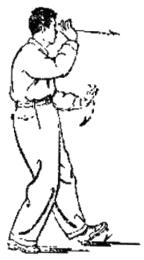


第二十六式 手揮琵琶勢(圖75)
Posture 26: PLAY THE LUTE
第二十七式 按勢(圖76)
Posture 27: PUSHING DOWN
第二十八式 青龍出水(圖77)
Posture 28: BLUE DRAGON LEAVES THE WATER
第二十九式 翻身(圖78)
Posture 29: TURN AROUND
四式合併為一個節序,動作一為“手揮琵琶勢”,動作二為“按勢”,動作三為“青龍出水”,動作四為“翻身”。
These four postures combine to form a cycle of four: movement 1 is PLAY THE LUTE, movement 2 is PUSHING DOWN, movement 3 is BLUE DRAGON LEAVES THE WATER, and movement 4 is TURN AROUND.
動作一:右足後退踏實,足尖對東南斜方,左足收至右足前,以足尖點地,兩腿變為右實左虛;同時兩手立掌隨身體右轉收回至胸前,左手仍與口平,右手落至腹前,兩手心均稍朝前;面對正東方向。(圖75)
Movement 1:
Your right foot steps back and flattens, toes pointing to the southeast corner, your left foot withdraws in front of your right foot, toes touching down, and your legs have become right full, left empty. At the same time, your hands as upright palms go along with your body’s right turn, withdrawing in front of your chest, your left hand still at mouth level, your right hand lowering to be in front of your belly, your palms slightly facing forward. You are facing to the east. See drawing 75:

要求手與胸臂之間要有圓活之趣。
There should be a quality of roundness and liveliness between your hands, chest, and arms.
動作二:右手向上翻起,向右上划圓圈,至臉前時,手心朝下,同時左手(手心朝下)由胸前向左下划弧至左腿旁,隨即兩手往下直按;上身前俯,趁勢向下微蹲;左手手指朝前置於左小腿左側,右手手指朝左置於兩腿之前。(圖76)
Movement 2:
Your right hand turns upward, circles to the right and up, and once it is in front of your face, palm facing down, it goes in unison with your left hand (palm facing down), arcing down from in front of your chest to be beside your left leg, both hands pushing straight down. Your upper body is leaning forward, and going along with the downward momentum there is a slight squat. Your left fingers point forward beside your left calf and your right fingers point to the left in front of both legs. See drawing 76:
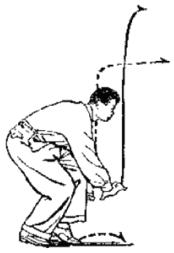
要求俯身時頭仍正直向前,兩臂微屈,兩腿仍須右實左虛。
While your body leans, your head stays upright and forward, your arms are slightly bent, and your legs are still right full, left empty.
動作三:上體直起;兩臂同時隨著向上提起,右手高與頭頂,手心稍朝前,手指朝左;左手立掌置於胸前,手指朝上,手心稍朝前;同時左足向前邁出,右足跟蹬,左腿前弓,左足掌落平,左足尖對正東方向,右腿微屈,兩腿變為左實右虛;左手隨著向前徐徐推出(上身不可前俯後仰),手與胸齊。(圖77)
Movement 3:
Your upper body straightens, your arms raising, your right hand raising to headtop level, palm slightly facing forward, fingers pointing to the left, as your left hand as an upright palm is placed in front of your chest, fingers up, palm slightly facing forward. At the same time, your left foot steps out forward, your right heel presses, your left leg bends forward, sole flattening, toes pointing to the east, your right leg slightly bent, and your legs have become left full, right empty. Your left hand slowly pushes out forward (without your upper body leaning forward or back) at chest level. See drawing 77:

動作四:以左足跟為軸,左足尖右轉135度踏實,身體向右後轉,右足尖隨著翹起;同時左手上舉,高與頭頂,手心稍朝前,手指朝右;右手隨著下落,成為立掌置於胸前,手指朝上,手心稍朝前,左足跟蹬,右腿前弓,右足掌落平,左腿微屈,兩腿變為右實左虛。右手隨即向前徐徐推出(上身不可前俯後仰),高與胸齊;面對正西方向。(圖78)
Movement 4:
Using your left heel as a pivot, your left toes turn a hundred and thirty-five degrees and the foot flattens, your body turning to the right rear, and your right toes then raise. At the same time, your left hand raises to headtop level, palm slightly facing forward, fingers pointing to the right. Your right hand then lowers, becoming an upright palm placed in front of your chest, fingers pointing up, palm slightly facing forward. Your left heel presses, your right leg bends forward, sole flattening, left leg slightly bent, and your legs have become right full, left empty, as your right hand slowly pushes out forward (without your upper body leaning forward or back) at chest level. You are facing to the west. See drawing 78:

第三十式 三甬背(圖79─82)
Posture 30: THREE THROUGH THE BACK
動作一:右足後退一大步踏實,足尖對右前斜方,左腿帶回,以足尖點於右足前,兩腿仍變為右實左虛;同時兩手立掌收至胸前,左高右低,左手高與口平,兩手心均稍朝前;面對正西方向。(圖79)
Movement 1:
Your right foot takes a large step back and flattens, toes pointing to the right forward corner, your left leg withdraws, toes touching down in front of your right foot, and your legs have become right full, left empty. At the same time, your hands as upright palms withdraw in front of your chest, left hand at mouth level, right hand lower, palms slightly facing forward. You are facing to the west. See drawing 79:

動作二:左足前邁,以足跟先著地,隨即右足跟蹬,左腿前弓,左足掌落平,右腿微屈,變為左腿實、右腿虛;同時兩手向前徐徐推出(上身不可前俯後仰),兩手心仍稍朝前,左手齊目,右手與胸平。(圖80)
Movement 2:
Your left foot steps forward, heel touching down first, then your right heel presses, your left leg bends forward, sole flattening, right leg slightly bent, and your legs have become left full, right empty. At the same time, your hands slowly push out forward (without your upper body leaning forward or back), palms still slightly facing forward, left hand at eye level, right hand at chest level. See drawing 80:

動作三:左足尖微向外撇,左腿坐實,右足前邁一大步,先以足跟著地,隨即左足跟蹬,右腿前弓,右足掌落平,右足尖正對前方,左腿微屈,變為右腿實、左腿虛;同時右手向上划弧,高與口齊;左手向下划弧,與心相平,兩手隨著右腿前弓時向前徐徐推出(上身不可前俯後仰),兩手心仍稍朝前,右手齊目,左手與胸相平。(圖81)
Movement 3:
Your left toes slightly swing outward, your left leg sits full, your right foot takes a large step forward, heel touching down first, then your left heel presses, your right leg bends forward, sole flattening, toes pointing forward, left leg slightly bent, and your legs have become right full, left empty. At the same time, your right hand arcs up to mouth level and your left hand arcs down to solar plexus level. When your right leg bends forward, your hands slowly push out forward (without your upper body leaning forward or back), palms still slightly facing forward, right hand at eye level, left hand at chest level. See drawing 81:

動作四與第三式“右懶扎衣”動作四相同,惟方向角度不同,本式是面對正西方向。(圖82)
Movement 4 is the same as in Posture 3, except the orientation is different, this time facing west. See drawing 82:
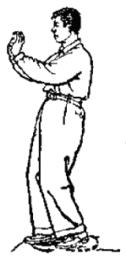
第三十一式 單鞭(圖83─85)
Posture 31: SINGLE WHIP
第三十二式 下勢(圖86)
Posture 32: LOWERING
兩式合併為一個節序,動作一、二、三為“單鞭”,動作四為“下勢”。
These two postures combine to form a cycle of four: movements 1-3 are SINGLE WHIP and movement 4 is LOWERING.
動作一與第十六式“單鞭”動作一相同。(圖83)
Movement 1 is the same as in Posture 16. See drawing 83:

動作二、三與第四式“單鞭”動作二、三相同。(圖84─85)
Movements 2 and 3 are the same as in Posture 4. See drawings 84&85:


動作四:身體向左微轉,左足隨著收至右足旁,以足尖點地,變為右腿實、左腿虛;同時左手下落至腹前,左臂微屈,手指朝前;右手上舉高與頂齊,手心朝上;面對正東方向,上體稍微斜偏朝南。(圖86)
Movement 4:
Your body slightly turns to the left, your left foot withdraws to be beside your right foot, toes touching down, and your legs have become right full, left empty. At the same time, your left hand lowers to be in front of your belly, arm slightly bent, fingers pointing forward. Your right hand raises to headtop level, palm facing up. You are facing to the east, your upper body slightly facing south. See drawing 86:
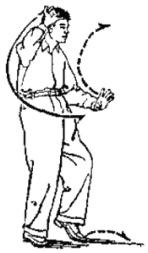
第三十三式 紜手(圖87─90)
Posture 33: TANGLING HANDS
動作一:左足向前邁出,足尖朝左角,以足跟著地,右足跟蹬,左腿前弓,左足掌落平,兩腿變為左實右虛;同時左手經腹部向上、右手自右向下划弧,左手舉至額前,與頭相平,手心稍朝前;右手下落向左抄起至腹前,手心稍朝下,兩手上下相對;面對東南斜方。(圖87)
Movement 1:
Your left foot steps forward, toes pointing to the left corner, heel touching down, your right heel presses, your left leg bends forward, sole flattening, and your legs have become left full, right empty. At the same time, your left hand goes up past your belly, your right hand arcing down from the right, and your left hand raises to be in front of your forehead, palm slightly facing forward, as your right hand lowers and scoops up to the left in front of your belly, palm slightly facing downward, your hands above and below each other. You are facing to the southeast corner. See drawing 87:
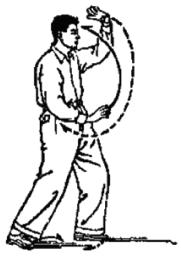
動作二:以左足跟為軸,身體右轉,左足尖也隨著裡扣90度,坐實左腿;右足提起,靠與左足跟前,以足跟著地,足尖上翹;兩腿仍為左實右虛;同時左手自左而下、右手從腹前向上划弧,右手舉至額前,與頭相平,手心朝外;左手下落後向右抄起至腹前,手心稍朝下,兩手上下相對;面對西南斜方。(圖88)
Movement 2:
Using your left heel as a pivot, your body turns to the right, your left toes twist inward ninety degrees, and your left leg sits full. Your right foot lifts and closes to be in front of your left heel, heel touching down, toes up, your legs still left full, right empty. At the same time, your left hand goes down from the left, your right hand arcing up from your belly, and your right hand raises to be in front of your forehead, palm facing out, as your left hand lowers behind and scoops up to the right in front of your belly, palm slightly facing down, your hands above and below each other. You are facing to the southwest corner. See drawing 88:

動作三:右足尖裡扣約90度踏實,坐實右腿,同時身體左轉,左足向左跨出,足跟先著地,隨即右足跟蹬,左腿前弓,左足掌落平,足尖朝左角,兩腿仍變為左實右虛;同時左手經腹部向上、右手自右而下划弧,左手舉至額前,與頭相平,手心稍朝前,右手下落向左抄起至腹前,手心稍朝下,兩手上下相對;面對東南斜方。(圖89)
Movement 3:
Your right toes twist in ninety degrees, the foot flattens, and your right leg sits full. At the same time, your body turns to the left and your left foot steps to the left, heel first touching down. Then your right heel presses, your left leg bends forward, sole flattening, toes pointing to the left corner, and your legs have become left full, right empty. At the same time, your left hand goes up past your belly, your right hand arcing down from the right, and your left hand raises to be in front of your forehead, palm slightly facing forward, as your right hand lowers and scoops up to the left in front of your belly, palm slightly facing down, your hands above and below each other. You are facing to the southeast corner. See drawing 89:
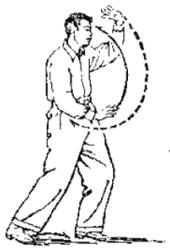
動作四:與本式動作二相同。(圖90)
Movement 4:
Same as in movement 2. See drawing 90:

第三十四式 單鞭(圖91)
Posture 34: SINGLE WHIP
第三十五式 提手上勢(圖92─93)
Posture 35: RAISE THE HAND
第三十六式 高探馬(圖94)
Posture 36: RISING UP AND REACHING OUT TO THE HORSE
三式合併為一個節序,動作一為“單鞭”,動作二、三為“提手上勢”,動作作四為“高探馬”。
These three postures combine to form a cycle of four: movement 1 is SINGLE WHIP, movements 2 and 3 are RAISE THE HAND, and movement 4 is RISING UP AND REACHING OUT TO THE HORSE.
動作一:右足尖裡扣約90度踏實,坐實右腿,同時身體左轉,左足向左跨出,足跟先著地,隨即右足跟蹬,左腿前弓,左足掌落平,足尖朝左角,兩腿仍變為左實右虛;同時左手上舉、右手下落,均變為立掌,當兩手與口相平時隨向左右順腿分開,左手齊目,右手齊口;面對東、稍偏於南的斜方。(圖91)
Movement 1:
Your right toes twist in ninety degrees, the foot flattens, and your right leg sits full. At the same time, your body turns to the left, your left foot steps out to the left, heel touching down, then your right heel presses, your left leg bends forward, sole flattening, toes pointing to the left corner, and your legs have become left full, right empty. At the same time, your left hand raises and your right hand lowers, both becoming upright palms, and once they are at mouth level they separate to the sides, left hand at eye level, right hand at mouth level. You are facing to the east and slightly south. See drawing 91:

動作二:右足提起經左足內側向前邁出,先以足跟著地,隨即左足跟蹬,右腿前弓,右足掌落平,足尖朝前,左腿微屈,變為右實左虛;身體同時微右轉;兩手隨動,右手自右而下向左抄至腹前,手指朝前;左手上舉,手心朝上,有上托之意,高與頂齊;在右腿前弓的同時,右手向前徐徐推出(上身不可前俯後仰),右手高與胸齊;面對正南方向。(圖92)
Movement 2:
Your right foot lifts, passes the inside of your left foot, and steps out forward, heel first touching down, then your left heel presses, your right leg bends forward, sole flattening, toes pointing forward, left leg slightly bent, and your legs have become right full, left empty. At the same time, your body slightly turns to the right. Your hands go along with the movement, your right hand going down from the right and scooping to the left to be in front of your belly, fingers pointing forward, as your left hand raises, palm facing up, with an intention of propping up, to headtop level. When your right leg bends forward, your right hand slowly pushes out forward (without your upper body leaning forward or back) at chest level. You are facing to the south. See drawing 92:

動作三:右足尖裡扣約45度,斜對東南方,同時腰微左旋,坐實右腿,兩腿仍為右實左虛。(圖93)
Movement 3:
Your right toes twist in forty-five degrees to point to the southeast corner. At the same time, your waist slightly turns to the left and your right leg sits full, your legs still right full, left empty. See drawing 93:

動作四:左手自前而下向裡划弧至腹前,手心朝上,手指朝右;右手隨著收近右脅旁,即向胸前搓按,手心朝下,高與胸平,與左手上下相對(兩臂均成半圓形);同時身體繼續左轉,面對正東方向;左足同時移至右足旁,以足尖點地,兩腿仍為右實左虛。(圖94)
Movement 4:
Your left hand arcs downward and inward to be in front of your belly, palm facing up, fingers pointing to the right, as your right hand withdraws beside your right flank to do a rubbing push in front of your chest, palm facing down, your hands above and below each other (each arm making a semicircle). At the same time, your body continues to turn to the left to be facing to the east, your left foot shifting to be beside your right foot, toes touching down, your legs still right full, left empty. See drawing 94:
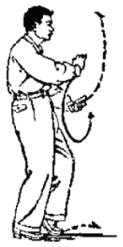
第三十七式 左伏虎勢(圖95─96)
Posture 37: SUBDUE THE TIGER – LEFT
第三十八式 右起腳(圖97─98)
Posture 38: RIGHT LIFTING KICK
兩式合併為一個節序,動作一、二為“左伏虎勢”,動作三、四為“右起腳”。
These two postures combine to form a cycle of four: movements 1 and 2 are SUBDUE THE TIGER – LEFT, and movements 3 and 4 are RIGHT LIFTING KICK.
動作一:身體微向左轉,左足向左前斜角邁出,以足跟先著地,右足跟蹬,左腿前弓,左足掌落平,變為左腿實、右腿虛;在左腿前弓時兩手隨動,左手順左腿向前向上經臉前撩起,高與頭頂;右手由胸前向外下落,前臂外旋,置於腹前;兩手同時握拳,上下拳心相對,在握拳的同時,面向右轉。(圖95)
Movement 1:
Your body slightly turns to the left, your left foot steps out to the left forward corner, heel first touching down, your right heel presses, your left leg bends forward, sole flattening, and your legs have become left full, right empty. When your left leg bends forward, your hands go along with the movement, your left hand in line with your left leg, raising forward and up, passing in front of your face to headtop level, your right hand going outward and down from in front of your chest, the forearm turning out, to be placed in front of your belly. Your hands make fists in unison, the fist centers facing each other, and when they make fists, your face turns to the right. See drawing 95:

動作二:體重全部移於左腿,右足提起,向前以足尖點與左足旁。(圖96)
Movement 2:
Your body weight shifts completely to your left leg, your right leg lifts and goes forward, toes touching down beside your left foot. See drawing 96:

動作三:右腿提起,以右腳尖向右踢出,高與膝齊;同時右拳舉起、左拳下落,當兩拳與肩相平時均變為立掌,向左右分開,右高左稍低,右手高與肩齊,右臂與右腿方向一致;左腿微屈。(圖97)
Movement 3:
Your right foot lifts and the toes kick to the right corner at knee level. At the same time, your right fist raises, your left fist lowers, and when they are at shoulder level, they become upright palms and separate to the sides, right hand at shoulder level, left hand slightly lower, your right arm and right leg oriented in the same direction, left leg slightly bent. See drawing 97:
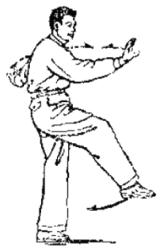
動作四:左右手合於胸前;同時右股不動,右小腿下垂,足尖朝下,足跟靠近左膝;面對右前斜方。(圖98)
Movement 4:
Your hands come together in front of your chest. At the same time, your right thigh does not move, but your lower leg droops, toes pointing down, heel near your left knee. You are facing to the right forward corner. See drawing 98:
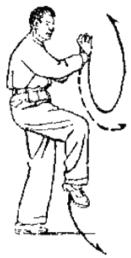
第三十九式 右伏虎勢(圖99─100)
Posture 39: SUBDUE THE TIGER – RIGHT
第四十式 左起腳(圖101─102)
Posture 40: LEFT LIFTING KICK
兩式合併為一個節序,動作一、二為“右伏虎勢”,動作三、四為“左起腳”。
These two postures combine to form a cycle of four: movements 1 and 2 are SUBDUE THE TIGER – RIGHT, and movements 3 and 4 are LEFT LIFTING KICK.
動作一、二、三、四與第三十七式“左伏虎勢”和第三十八式“右起腳”兩式合併的四個動作說明相同,惟左右相反,方向略異,本式踢腳是向東北斜方。(圖99─102)
Same as in Postures 37 and 38, except left and right are reversed and the orientation is slightly different, this time kicking to the northeast. See drawing 99-102:




第四十一式 轉身蹬腳(圖103─104)
Posture 41: TURN AROUND, PRESSING KICK
第四十二式 單鞭(圖105)
Posture 42: SINGLE WHIP
第四十三式 踐步打捶(圖106)
Posture 43: STEP SUCCESSIVELY, PUNCH
三式合併為一個節序,動作一、二為“轉身蹬腳”,動作三為“單鞭”,動作四為“踐步打捶”。
These three postures combine to form a cycle of four: movements 1 and 2 are TURN AROUND, PRESSING KICK, movement 3 is SINGLE WHIP, and movement 4 is STEP SUCCESSIVELY, PUNCH.
動作一:以右足跟為軸,身體向左後轉180度;面對正西方向。(圖103)
Movement 1:
Using your right heel as a pivot, your body turns a hundred and eighty degrees to the left rear. You are facing to the west. See drawing 103:

動作二:左足尖翹起,以足跟向前蹬出,高與膝齊,右腿微屈;同時兩手立掌向左右分開,左高右稍低,左手高與肩平,左臂與左腿方向一致;面仍對正西方向;體重仍在右腿,右腿微屈。(圖104)
Movement 2:
Your left toes raise, the heel presses out forward at knee level, your right leg slightly bent. At the same time, your hands as upright palms separate to the sides, left hand at shoulder level, right hand slightly lower, your left arm and left leg oriented in the same direction. You are facing to the west. The weight is still on your right leg, which is slightly bent. See drawing 104:

動作三:左腿向前落下,先以足跟著地,同時兩手合於胸前;隨即右足跟蹬,左腿前弓,左足掌落平變實;在左腿前弓的同時,兩手向左右順腿分開,成單鞭式。(圖105)
Movement 3:
Your left leg lowers in front, heel first touching down, your hands coming together in front of your chest. Then your right heel presses, your left leg bends forward, sole flattening. When your left leg bends forward, your hands separate to the sides over your legs, making the SINGLE WHIP posture. See drawing 105:
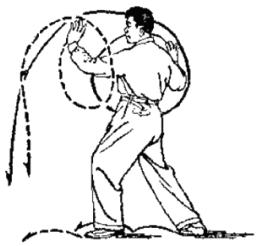
動作四:左手下落經左胯旁向左而上向前下落划圈,仍收至胯旁(不停),手心朝下;同時右手舉經右耳旁向前而下向後划圈,仍收回至右耳旁(不停)變拳,拳眼朝左;在兩手划圈的同時,右足上步,足掌平落與左足旁,隨即左足向前邁出踏實,足尖朝西;右足往前跟步,以足尖點於左足後,變為左腿實、右腿虛;上身前俯,趁勢向下微蹲;隨身體前俯、下蹲的同時,右拳從耳旁循胸前向前下方栽擊,拳心朝裡,置於兩腿之前,同時左掌從胯旁下按,手指朝前,置於小腿左側。(圖106)
Movement 4:
Your left hand lowers, passing beside your left hip, and circles to the left, up, forward, down, to again be beside the hip (all without pause), palm facing down. At the same time, your right hand raises, passing beside your right ear, and circles forward, down, behind, to again be beside your right ear (without pause) and makes a fist, the fist eye facing to the left. While your hands circle, your right foot steps forward, the sole flattens beside your left foot, then your left foot steps forward and flattens, toes pointing to the west, and then your right foot does a follow step, toes touching down behind your left foot, and your legs have become left full, right empty. Your upper body leans forward, and going along with the momentum there is a slight squat. When your body leans forward and squats, your right fist goes from beside your right ear, past your chest, forward and down, to do a planting strike, the center of the fist facing in, to be placed in front of your legs. At the same time, your left palm goes from beside the hip to push down, fingers pointing forward, to be placed beside your left calf. See drawing 106:

要求在身體前俯、下蹲時,頭仍須正直,眼向前視。兩臂須微屈。
When your body leans forward and squats, your head stays upright, eyes forward, and your arms must be slightly bent.
第四十四式 翻身二起(圖107─108)
Posture 44: TURN AROUND, DOUBLE KICK
第四十五式 披身(圖109─110)
Posture 45: DRAPE THE BODY
兩式合併為一個節序,動作一、二為“翻身二起”,動作三、四為“披身”。
These two postures combine to form a cycle of four: movements 1 and 2 are TURN AROUND, DOUBLE KICK, and movements 3 and 4 are DRAPE THE BODY.
動作一:以左足跟為軸,身體向右後翻轉,左足尖也隨著右轉135度,坐實左腿;同時右拳隨翻身上提經臉前向右後下落,至胸前變為立掌;左手也同時立掌舉至胸前,兩手右高左低;右腿隨體轉向正東方,右足前邁,先以足跟著地(如右懶扎衣勢)。左足跟蹬,右腿前弓,右足掌落平,左腿微屈,變為右腿實、左腿虛;兩掌向前徐徐推出(上身不可前俯後仰);面對正東方向。(圖107)
Movement 1:
Using your left heel as a pivot, your body turns around to the right rear, your left toes turning a hundred and thirty-five degrees to the right, and your left leg sits full. At the same time, your right fist goes along with your body’s turn, lifting past your face to come down to the right rear, and once in front of your chest, becomes an upright palm. At the same time, your left hand as an upright palm raises to be in front of your chest, lower than your right hand, and your right leg follows your body’s turn, the foot stepping forward to the east, the heel first touching (as in LAZILY PULLING BACK THE ROBE – RIGHT). Your left heel presses, your right leg bends forward, sole flattening, left leg slightly bent, your legs becoming right full, left empty, as your palms slowly push out forward (without your upper body leaning forward or back). You are facing to the east. See drawing 107:

動作二:右足尖稍外撇踏實,左足前邁一大步,先以足跟著地,隨即右足跟蹬,左腿前弓,左足掌落平變實;同時兩手在胸前左手向上、右手向下划弧,至左手與口相平,右手與胸相齊時隨著左腿前弓向前徐徐推出(上身不可前俯後仰)。(圖108甲)
Movement 2:
Your right toes slightly swing outward, the foot flattens, your left foot takes a large step forward, heel first touching down, then your right heel presses, your left leg bends forward, sole flattening. At the same time, your hands arc in front of your chest, left hand going up, right hand going down, and when your left hand is at mouth level and your right hand at chest level, as your left leg is bending forward, they slowly push out forward (without your upper body leaning forward or back). See drawing 108a:
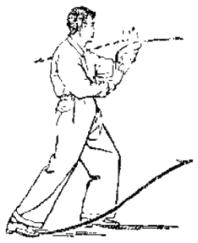
接著左足尖稍外撇踏實,體重全部移於左腿,右腿提起,以右足尖向前踢出,高與膝齊,左腿微屈;同時兩手向左右分開,右高左稍低,右手高與肩平,右臂與右腿方向一致,右手要有拍打右足面之意;面對正東方向。(圖108乙)
Then your left toes slightly swing out, the foot flattens, the weight completely shifts to your left leg, your right leg lifts, and the toes kick forward at knee level, your left leg slightly bent. At the same time, your hands separate to the sides, right hand at shoulder level, left hand slightly lower, your right arm and right leg oriented in the same direction, and your right hand should have an intention of slapping the top of your right foot. You are facing to the east. See drawing 108b:

動作三:右腿下落,右足經左足跟後平落於左足跟左側後方,兩腿為右實左虛;同時兩手收至胸前,右手與口相平,左手齊胸。(圖109甲)
Movement 3:
Your right leg lowers, the foot passing behind your left heel to flatten behind and beside it, and your legs have become right full, left empty. At the same time, your hands withdraw in front of your chest, right hand at mouth level, left hand at chest level. See drawing 109a:
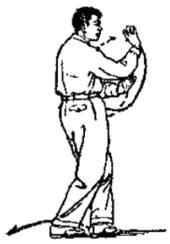
接著左足後退一步,足尖斜對左前斜方,左腿微屈,仍為左虛右實;同時兩手隨退步後移。體重後移,坐實左腿,右足尖翹起,變為左實右虛;同時兩手隨著自前而下,弧形收至胸前。隨即左足跟蹬,右腿前弓,右足掌落平,仍變為右腿實、左腿虛;同時兩手徐徐向前推出(上身不可前俯後仰),右手齊目,左手與胸平;面對正東方向。(圖109乙)
Then your left foot takes a step back, toes pointing to the left forward corner, leg slightly bent, your legs still left empty, right full, your hands shifting back along with the retreat. The weight shifts back, your left leg sits full, your right toes raise, and your legs have become left full, right empty. At the same time, your hands go down from in front and arc to withdraw in front of your chest. Then your left heel presses, your right leg bends forward, sole flattening, and your legs have become right full, left empty. At the same time, your hands slowly push out forward (without your upper body leaning forward or back), right hand at eye level, left hand at chest level. You are facing to the east. See drawing 109b:
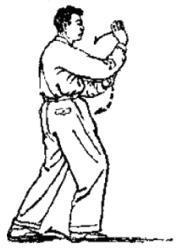
動作四:右腿收回,以足尖點於左足前,身體後移,變為左腿實、右腿虛;兩手隨身後移握拳,左拳置於腹前,右拳於胸平,拳心上下相對,兩臂均呈半圓形;面對正東方向。(圖110)
Movement 4:
Your right leg withdraws, toes touching down in front of your left foot, your body shifts back, and your legs have become left full, right empty. Your hands follow your body’s shifting back and make fists, left fist placed in front of your belly, right fist at chest level, the fist centers facing each other above and below, each arm making a semicircle. You are facing to the east. See drawing 110:

第四十六式 退步踢腳(圖111─112)
Posture 46: STEP BACK, SNAPPING KICK
第四十七式 轉身蹬腳(圖113─114)
Posture 47: TURN AROUND, PRESSING KICK
第四十八式 上步搬攬捶(圖115)
Posture 48: STEP FORWARD, PARRY, TAKE IN, PUNCH
三式合併為一個節序,動作一、二為“退步踢腳”,動作三為“轉身蹬腳”,動作四為“上步搬攬捶”。
These three postures combine to form a cycle of four: movements 1 and 2 are STEP BACK, SNAPPING KICK, movement 3 is TURN AROUND, PRESSING KICK, and movement 4 is STEP FORWARD, PARRY, TAKE IN, PUNCH.
動作一:右足退至左足後踏實,足尖對右前斜方,體重後移,左腿收回,以足尖點於右足前,變為右腿實、左腿虛;同時兩拳隨身後移,左向上右向下划弧,左拳與胸平,右拳置於腹前,拳心上下相對,兩臂均呈半圓形;面對正東方向。(圖111)
Movement 1:
Your right foot steps back to be behind your left foot and flattens, toes pointing to the right forward corner, the weight shifts back, your left leg withdraws, toes touching down in front of your right foot, and your legs have become right full, left empty. At the same time, your fists follow your body, shifting back, left fist arcing up to be at chest level, right fist arcing down to be placed in front of your belly, the fist centers facing each other above and below, each arm making a semicircle. You are facing to the east. See drawing 111:

動作二:體重全部移於右腿,右腿微屈,左腿提起,以足尖向前踢出,高與膝齊;同時兩拳變為立掌向左右分開,左高右稍低,左手高與肩齊,左臂與左腿方向一致;面對正東方向。(圖112)
Movement 2:
The weight completely shifts to your right leg, which is slightly bent, and your left leg lifts, toes kicking forward at knee level. At the same time, your fists become upright palms and separate to the sides, left hand at shoulder level, right hand slightly lower, your left arm and left leg oriented in the same direction. You are facing to the east. See drawing 112:

動作三:左股不動,小腿下垂,足尖朝下,以右足跟為軸,身體與右足尖向右後轉約270度,隨即左足向北方(稍偏東)平落踏實,右腿微屈變虛;在轉動前,兩手立掌收至胸前在左腿之上隨身旋轉,在左足落地時,左右手心朝下,兩手有下按之意,手指朝前,兩臂微彎;面對東北斜方。(圖113)
Movement 3:
Your left thigh does not move, but the lower leg droops, toes pointing down, and using your right heel as a pivot, your body and right toes turn two hundred and seventy degrees to the right rear, then your left foot steps to the north (and slightly inclining to the east) and flattens, and your right leg, slightly bent, becomes empty. Before the turn, your hands as upright palms withdraw in front of your chest while your left leg is up and then they go along with your body’s turn. When your left foot comes down, the palms face down with an intention of pushing down, fingers pointing forward, arms slightly bent. You are facing to the northeast corner. See drawing 113:

接著體重全部移於左腿,兩手與右腿提起,右足尖翹起,以腳跟向前蹬出,高與襠齊,兩腿微屈;同時兩手立掌向左右分開,右高左稍低,右手高與肩平,右臂與右腿方向一致;面對正東方向。(圖114)
Then the weight completely shifts to your left leg, your hands and right leg lift, toes raised, and the heel presses out forward at crotch level, both legs slightly bent. At the same time, your hands as upright palms separate to the sides, your right hand at shoulder level, your left hand slightly lower, your right arm and right leg oriented in the same direction. You are facing to the east. See drawing 114:

動作四:右腿向前下落,右足踏實於左足跟旁,左足向前上步,左腿隨即前弓變實、右足隨著往前跟步,以足尖點於左足跟旁,仍變為左腿實、右腿虛;在右足上步的同時,左手向上向前划弧落至胸前,右手落至胯旁握拳;在右足跟步時,右拳沿左手手背上向前慢慢擊出(上身不可前俯後仰),拳眼朝上,高與心平;面對正東方向。(圖115)
Movement 4:
Your right leg lowers in front, the foot flattens beside your left heel, your left foot steps forward, the leg then bends forward and becomes full, your right foot then does a follow step, toes touching down beside your left heel, and your legs again become left full, right empty. When your right foot steps forward, your left hand arcs up, forward, and lowers in front of your chest, as your right hand lowers to be beside the hip and makes a fist. When your right foot does the follow step, your right fist slowly strikes forward over the back of your left hand (without your upper body leaning forward or back), fist eye facing up, at solar plexus level. You are facing to the east. See drawing 115:

第四十九式 如封似閉(圖116─119)
Posture 49: SEALING SHUT
動作一、二、三、四與第十二式“如封似閉”四動相同。(圖116─119)
Same as in Posture 12. See drawings 116-119:

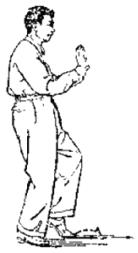
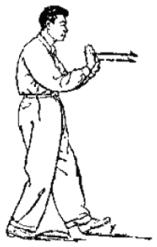

第五十式 抱虎推山(圖120─123)
Posture 50: CAPTURE THE TIGER AND PUSH IT BACK TO ITS MOUNTAIN
動作一、二、三、四與第十三式“抱虎推山”四動相同。(圖120─123)
Same as in Posture 13. See drawings 120-123:



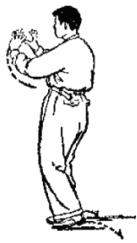
第五十一式 手揮琵琶勢(圖124─125)
Posture 51: PLAY THE LUTE
第五十二式 右懶扎衣(圖126─127)
Posture 52: LAZILY PULLING BACK THE ROBE – RIGHT
兩式合併為一個節序,動作一、二為“手揮琵琶勢”,動作三、四為“右懶扎衣”。
These two postures combine to form a cycle of four: movements 1 and 2 are PLAY THE LUTE, and movements 3 and 4 are LAZILY PULLING BACK THE ROBE – RIGHT.
動作一、二與第十四式“手揮琵琶勢”動作一、二相同,惟方向不同,本式是面對西北斜方。(圖124─125)
Movements 1 and 2 are the same as in Posture 14, except the orientation is different, this time facing to the northwest corner. See drawings 124&125:


動作三、四與第三式“右懶扎衣”動作三、四相同,惟方向不同,本式是面對西北斜方。(圖126─127)
Movements 3 and 4 are the same as in Posture 13, except the orientation is different, this time facing to the northwest corner. See drawings 126&127:


第五十三式 斜單鞭(圖128─130)
Posture 53: DIAGONAL SINGLE WHIP
第五十四式 下勢(圖131)
Posture 54: LOWERING
兩式合併為一個節序,動作一、二、三為“斜單鞭”,動作四為“下勢”。
These two postures combine to form a cycle of four: movements 1-3 are DIAGONAL SINGLE WHIP and movement 4 is LOWERING.
動作一、二、三與第四式“單鞭”動作一、二、三相同,惟方向角度不同,本式為面對正南方向,胸部對南稍偏於西的斜方。(圖128─130)
Movements 1-3 are the same as in Posture 4, except the orientation is different, this time facing to the south, your chest facing south and slightly west. See drawings 128-130:

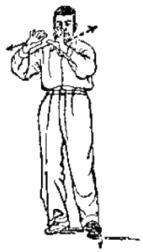

動作四與第三十二式“下勢”動作四相同,惟方向角度不同。(圖131)
Movement 4 is the same as in Posture 32, except the orientation is different. See drawing 131:

第五十五式 野馬分鬃(圖132─135)
Posture 55: WILD HORSE PARTS ITS MANE
動作一:左足向西南斜方向上步;同時左手由腹前向右上划弧,舉至額前,與頂相齊,手心朝外;右手弧形下落向左抄起至腹前,手指朝上;在兩手划弧的同時,右足往前跟步,以足尖點於左足跟旁,兩腿變為左實右虛;面對西南斜方。(圖132)
Movement 1:
Your left foot steps forward to the southwest corner. At the same time, your left hand arcs from in front of your belly to the right and up, raising to be in front of your forehead at headtop level, palm facing outward. Your right hand arcs down and scoops up to the left to be in front of your belly, fingers pointing up. When your hands arc, your right foot does a follow step, toes touching down beside your left heel, and your legs have become left full, right empty. You are facing to the southwest corner. See drawing 132:

動作二:右足向西北斜方向上步,身體右轉;同時右手由腹前向左上划弧,舉至額前,與頂相齊,手心朝外;左手弧形下落向右抄起至腹前,手指朝上;在兩手划弧的同時,左足往前跟步,以足尖點於右足跟旁,兩腿變為右實左虛;面對西北斜方。(圖133)
Movement 2:
Your right foot steps forward to the northwest corner, your body turning to the right. At the same time, your right hand arcs from in front of your belly to the left and up, raising to be in front of your forehead at headtop level, palm facing out. Your right hand arcs down and scoops up to the left to be in front of your belly, fingers pointing up. When your hands arc, your left foot does a follow step, toes touching down beside your right heel, and your legs have become right full, left empty. You are facing to the northwest corner. See drawing 133:

動作三:與本式動作一說明相同,惟在左足上步後,身體微向左轉。(圖134)
Movement 3:
Same as in movement 1, except that after your left foot steps forward, your body slightly turns to the left. See drawing 134:

動作四:右足向正西方向上步;同時左手弧形下落,右手由腹前上舉,兩手變為立掌,如右懶扎衣式。隨即兩手向前徐徐推出,左手在內高與胸平,右手在外高與目齊;左足也隨著往前跟步,以足尖點與右足跟後,兩腿變為右實左虛;面對正西方向。(圖135)
Movement 4:
Your right foot steps forward to the west. At the same time, your left hand arcs down, your right hand raises from in front of your belly, both hands become upright palms, and the posture is like TUCK IN YOUR ROBE – RIGHT. Then your hands slowly push out forward, left hand inside at chest level, right hand outside at eye level, left foot at the same time doing a follow step, toes touching down behind your right heel, and your legs have become right full, left empty. You are facing to the west. See drawing 135:

第五十六式 單鞭(圖136─139)
Posture 56: SINGLE WHIP
動作一:左足尖向左後移點地,以右足跟為軸,身體與右足尖向左轉135度,面對東南斜方,仍為右腿實、左腿虛;同時左手向下、向左、向上划圈,與右手合於胸前,兩手仍為立掌,高與口平。(圖136)
Movement 1:
Your left toes shift to the left rear, and using your right heel as a pivot, your body and right toes turn a hundred and thirty-five degrees to the left. You are facing to the southwest corner. Your legs are still right full, left empty. At the same time, your left hand arcs down, left, up, and joins your right hand in front of your chest, both hands still upright palms, at mouth level. See drawing 136:
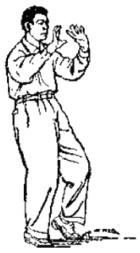
動作二、三與第四式“單鞭”動作二、三相同。(圖137─138)
Movements 2 and 3 are the same as in Posture 4. See drawings 137&138:


動作四:左足尖裡扣約90度,坐實左腿,身體隨著右轉;右足跟著地,足尖翹起隨體轉向,右腿微屈,仍為左腿實、右腿虛;同時左手上舉,高與頭齊,手心朝上;右手立掌下落於胸前;面對正西方向。(圖139)
Movement 4:
Your left toes twist in about ninety degrees, your left leg sits full, and your body then turns to the right. Your right heel touches down, your toes raise with your body’s turn, leg slightly bent, your legs still left full, right empty. At the same time, your left hand raises to head level, palm facing upward, and your right hand as an upright palm lowers in front of your chest. You are facing to the west. See drawing 139:
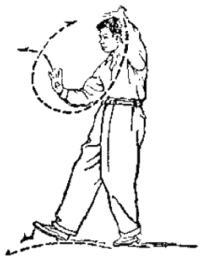
第五十七式 玉女穿梭(圖140─143)
Posture 57: MAIDEN WORKS THE SHUTTLE
動作一:右腿前弓,體重移於右腿,左足隨即向西南斜方上步,右足即往前跟步,以足尖點於左足跟旁,變為左腿實、右腿虛;同時左手下落向前向上划圈,經臉前撩起置於額前上方,手指朝右;右手稍上舉,隨身體前移、右足跟步時向前徐徐推出(上身不可前俯後仰);面對西南斜方。(圖140)
Movement 1:
Your right leg bends forward, the weight completely shifts to your right leg, your left foot then steps forward to the southwest corner, your right foot then does a follow step, toes touching down beside your left heel, and your legs have become left full, right empty. At the same time, your left hand arcs down, forward, up, passing in front of your face, lifting up to be placed in front of and above your forehead, fingers pointing to the right, as your right hand slightly raises and, while your body shifts forward and your right foot does the follow step, slowly pushes out forward (without your upper body leaning forward or back). You are facing to the southwest corner. See drawing 140:

動作二:右足提起,經左足後移至左足跟左側,以足尖點地,以左足跟為軸,身體與左足尖同時向右後轉,隨即右足向東南斜方上步踏實,左足往前跟步,以足尖點於右足跟旁,變為右腿實、左腿虛;在轉身上步的同時,左手向下、右手向上划弧,右手經臉前撩起,置於額前上方,手指朝左,左手落至胸前,隨身體前移、左足跟步時向前徐徐推出(上身不可前俯後仰);面對東南斜方。(圖141)
Movement 2:
Your right foot lifts, passes behind your left foot to be to the left side of your left heel, toes touching down, and using your left heel as a pivot, your body and left toes at the same time turn to the right rear. Then your right foot steps forward to the southeast corner, the foot flattens, your left foot does a follow step, toes touching down beside your right heel, and your legs have become right full, left empty. During your body’s turn and the step forward, your left hand arcs down and your right hand arcs up, your right hand passing in front of your face, lifting up to be placed in front of and above your forehead, fingers pointing to the left, your left hand lowering to be in front of your chest and, while your body shifts forward and your left foot does the follow step, slowly pushes out forward (without your upper body leaning forward or back). You are facing to the southeast corner. See drawing 141:
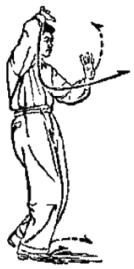
動作三:左足向東北斜方上步踏實,右足往前跟步,以足尖點於左足跟旁,兩腿變為左實右虛;同時左手向上划弧,經臉前撩起,置於額前上方,手指朝右,右手下落至胸前,隨身體前移、右足跟步時向前徐徐推出(上身不可前俯後仰);面對東北斜方。(圖142)
Movement 3:
Your left foot steps forward to the northeast corner and flattens, your right foot then does a follow step, toes touching down beside your left heel, and your legs have become left full, right empty. At the same time, your left hand arcs up, passing in front of your face, lifting up to be placed in front of and above your forehead, fingers pointing to the right, your right hand lowering to be in front of your chest and, while your body shifts forward and your right foot does the follow step, slowly pushes out forward (without your upper body leaning forward or back). You are facing to the northeast corner. See drawing 142:
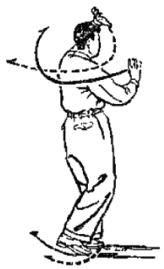
動作四與本式動作二相同,惟方向角度不同,本式右足是向西北斜方上步。(圖143)
Movement 4 is the same as movement 2, except the orientation is different, this time your right foot stepping forward to the northwest corner. See drawing 143:

第五十八式 手揮琵琶勢(圖144─145)
Posture 58: PLAY THE LUTE
第五十九式 右懶扎衣(圖146─147)
Posture 59: LAZILY PULLING BACK THE ROBE – RIGHT
兩式合併為一個節序,動作一、二為“手揮琵琶勢”,動作三、四為“右懶扎衣”。
These two postures combine to form a cycle of four: movements 1 and 2 are PLAY THE LUTE, and movements 3 and 4 are LAZILY PULLING BACK THE ROBE – RIGHT.
動作一、二與第十四式“手揮琵琶勢”動作一、二相同。(圖144─145)
Movements 1 and 2 are the same as in Posture 14. See drawings 144&145:


動作三、四與第十五式“右懶扎衣”動作三、四相同。(圖146─147)
Movements 3 and 4 are the same as in Posture 15. See drawings 146&147:


第六十式 單鞭(圖148─150)
Posture 60: SINGLE WHIP
第六十一式 下勢(圖151)
Posture 61: LOWERING
兩式合併為一個節序,動作一、二、三為“單鞭”,動作四為“下勢”。
These two postures combine to form a cycle of four: movements 1-3 are SINGLE WHIP, and movement 4 is LOWERING.
動作一與第六十式“單鞭”動作一相同。(圖148)
Movement 1 is the same as in Posture 16. See drawing 148:

動作二、三與第四式“單鞭”動作二、三相同。(圖149─150)
Movements 2 and 3 are the same as in Posture 4. See drawings 149&150:


動作四與第三十一式“單鞭”和第三十二式“下勢”合併為一個節序的動作四相同。(圖151)
Movement 4 is the same as in Posture 32. See drawing 151:

第六十二式 紜手(圖152─155)
Posture 62: TANGLING HANDS
動作一、二、三、四與第三十三式“紜手”四動相同。(圖152─155)
Same as in Posture 33. See drawings 152-155:
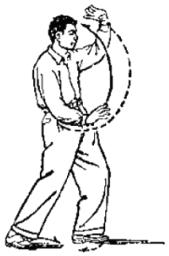


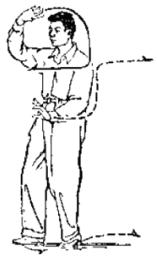
第六十三式 單鞭(圖156)
Posture 63: SINGLE WHIP
第六十四式 下勢(圖157)
Posture 64: LOWERING
第六十五式 更雞獨立(圖158─159)
Posture 65: ROOSTER STANDS ON ONE LEG
三式合併為一個節序,動作一為“單鞭”,動作二為“下勢”,動作三、四為“更雞獨立”。
These three postures combine to form a cycle of four: movement 1 is SINGLE WHIP, movement 2 is LOWERING, and movements 3 and 4 are ROOSTER STANDS ON ONE LEG.
動作一與第三十四式“單鞭”動作一相同。(圖156)
Movement 1 is the same as in Posture 34. See drawing 156:

動作二與第三十一式“單鞭”和第三十二式“下勢”合併為一個節序的動作四相同。(圖157)
Movement 2 is the same as in Posture 31. See drawing 157:

動作三:左足前邁,足尖正對正東方向踏實;體重漸漸全部移於左腿,身體隨著向左微轉;右腿隨著向前提起,屈膝、股平,小腿下垂,足尖朝下,左腿成獨立步;在提腿的同時,右手向右下落經右胯旁握拳上舉,高與頂齊,拳心朝裡,前臂豎直,在右股之上;左手同時向上微舉,隨即向左胯旁下按,與右股相平,手指朝前,左臂微屈;面對正東方向。(圖158)
Movement 3:
Your left foot steps forward, toes pointing to the east, and flattens. The weight gradually shifts completely to your left leg, and your body at the same time turns slightly to the left. Your right leg then lifts forward, knee bent, thigh flat, lower leg drooping, toes pointing down, your left leg making a one-legged stance. While the leg lifts, your right hand lowers, passes your right hip, makes a fist, raises to headtop level, the fist center facing in, forearm vertical above your right thigh. At the same time, your left hand slightly raises, then pushes down beside your left hip, level with your right thigh, fingers pointing forward, arm slightly bent. You are facing to the east. See drawing 158:
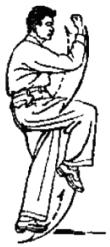
動作四:右足掌平落於左足旁踏實,左腿隨即提起,屈膝、股平,小腿下垂,足尖朝下,右腿成獨立步;同時右拳變掌向右胯旁下按,與左股相平,手指朝前,右臂微屈;左手同時在左胯旁握拳上舉,高與頂齊,拳心朝裡,前臂豎直,於左股之上。(圖159)
Movement 4:
Your right sole lowers and flattens beside your left foot, your left leg then lifts, knee bent, thigh flat, lower leg drooping, toes pointing down, your right leg making a one-legged stance. At the same time, your right fist becomes a palm and pushes down beside your right hip, level with your left thigh, fingers pointing forward, arm slightly bent. At the same time, your left hand makes a fist and raises from beside your left hip to headtop level, the fist center facing in, forearm vertical above your left thigh. See drawing 159:

第六十六式 左倒攆猴(圖160─163)
Posture 66: TURN LEFT TO DRIVE AWAY THE MONKEY
動作一:左足下落,以足尖點於右足跟後;兩手變為立掌向左右分開,高與肩齊;以右足跟為軸,身體與右足尖向左轉90度,坐實右腿;隨轉體兩手相對,合於胸前,有捧球之意,高與口平。(圖160)
Movement 1:
Your left foot lowers, toes touching down behind your right heel, your hands becoming upright palms which separate to the sides to be at shoulder level. Using your right heel as a pivot, your body and right toes turn ninety degrees to the left, and your right leg sits full. Following your body’s turn, your hands come together in front of your chest with an intention of holding a ball, your hands at mouth level. See drawing 160:

要求鬆肩、沉肘,手與胸臂之間有圓活之趣,兩腿須左虛右實。
You should be loosening your shoulders and sinking your elbows, and there should be a quality of roundness and liveliness between your hands, chest, and arms. Your legs are left empty, right full.
動作二、三、四與第十九式“左倒攆猴”動作二、三、四相同。(圖161─163)
Movements 2-4 are the same as is Posture 19. See drawing 161-163:

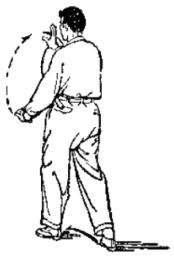

第六十七式 右倒攆猴(圖164─167)
Posture 67: TURN RIGHT TO DRIVE AWAY THE MONKEY
動作一、二、三、四與第二十式“右倒攆猴”四動相同。(圖164─167)
Same as in Posture 20. See drawings 164-167:




第六十八式 左倒攆猴(圖168─171)
Posture 68: TURN LEFT TO DRIVE AWAY THE MONKEY
動作一、二、三、四與第二十一式“左倒攆猴”四動相同。(圖168─171)
Same as in Posture 21. See drawings 168-171:




第六十九式 右倒攆猴(圖172─175)
Posture 69: TURN RIGHT TO DRIVE AWAY THE MONKEY
動作一、二、三、四與第二十式“右倒攆猴”四動相同。(圖172─175)
Same as in Posture 20. See drawings 172-175:
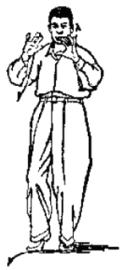
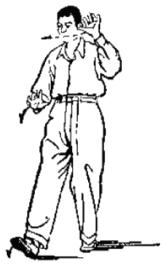

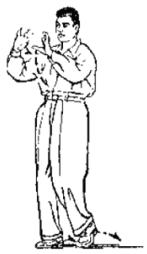
第七十式 手揮琵琶勢(圖176)
Posture 70: PLAY THE LUTE
第七十一式 白鵝亮翅(圖177─179)
Posture 71: WHITE GOOSE SHOWS ITS WINGS
兩式合併為一個節序,與第二十三式“手揮琵琶勢”和第二十四式“白鵝亮翅”所合併的一個節序的四個動作說明相同。(圖176─179)
Same as in Postures 23&24. See drawings 176-179:




第七十二式 摟膝拗步(圖180─183)
Posture 72: BRUSH KNEE IN A CROSSED STANCE
動作一、二、三、四與第七式“摟膝拗步”四動相同。(圖180─183)
Same as in Posture 7. See drawings 180-183:

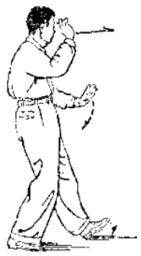
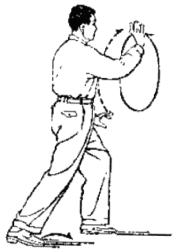

第七十三式 手揮琵琶勢(圖184)
Posture 73: PLAY THE LUTE
第七十四式 按勢(圖185)
Posture 74: PUSHING DOWN
第七十五式 青龍出水(圖186)
Posture 75: BLUE DRAGON LEAVES THE WATER
第七十六式 翻身(圖187)
Posture 76: TURN AROUND
四式合併為一個節序,與第二十六式“手揮琵琶勢”、第二十七式“按勢”、第二十八式“青龍出水”和第二十九式“翻身”所合併的一個節序的動作說明相同。(圖184─187)
Same as in Postures 26-29. See drawings 184-187:


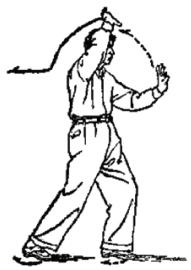

第七十七式 三甬背(圖188─191)
Posture 77: THREE THROUGH THE BACK
動作一、二、三、四與第三十式“三甬背”四動相同。(圖188─191)
Same as in Posture 30. See drawings 188-191:



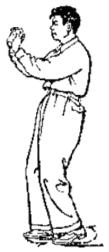
第七十八式 單鞭(圖192─194)
Posture 78: SINGLE WHIP
第七十九式 下勢(圖195)
Posture 79: LOWERING
兩式合併為一個節序,與第三十一式“單鞭”與第三十二式“下勢”所合併的一個節序的動作說明相同。(圖192─195)
Same as in Postures 31&32. See drawings 192-195:




第八十式 紜手(圖196─199)
Posture 80: TANGLING HANDS
動作一、二、三、四與第三十三式“紜手”四動作相同。(圖196─199)
Same as in Posture 33. See drawings 196-199:
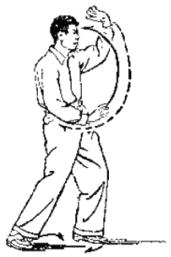


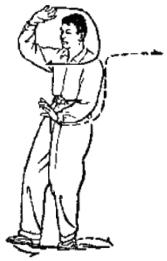
第八十一式 單鞭(圖200)
Posture 81: SINGLE WHIP
第八十二式 提手上勢(圖201─202)
Posture 82: RAISE THE HAND
第八十三式 高探馬(圖203)
Posture 83: RISING UP AND REACHING OUT TO THE HORSE
三式合併為一個節序,與第三十四式“單鞭”、第三十五式“提手上勢”和第三十六式“高探馬”所合併的一個節序的動作說明相同。(圖200─203)
Same as in Postures 34-36. See drawings 200-203:




第八十四式 對心掌(圖204)
Posture 84: PALM TO THE SOLAR PLEXUS
第八十五式 轉身十字擺連(圖205)
Posture 85: TURN AROUND, CROSSED-BODY SWINGING LOTUS KICK
第八十六式 上步指襠捶(圖206)
Posture 86: STEP FORWARD, PUNCH TO THE CROTCH
第八十七式 右懶扎衣(圖207)
Posture 87: LAZILY PULLING BACK THE ROBE – RIGHT
四式合併為一個節序,動作一為“對心掌”,動作二為“轉身十字擺連”,動作三為“上步指襠捶”,動作四為“右懶扎衣”。
These four postures combine to form a cycle of four: movement 1 is PALM TO THE SOLAR PLEXUS, movement 2 is TURN AROUND, CROSSED-BODY SWINGING LOTUS KICK, movement 3 is STEP FORWARD, PUNCH TO THE CROTCH, and movement 4 is LAZILY PULLING BACK THE ROBE – RIGHT.
動作一:左足向正東方向邁出,先以腳跟著地,右足跟蹬,左腿前弓,左足掌落平,右腿微屈,兩腿變為左實右虛;左手經右手前(手心翻朝下)向上經臉前撩起(隨撩手心隨翻朝上),置於額前上方,手指朝右;右肘下垂,右手變為立掌隨左腿前弓向前徐徐推出(上身不可前俯後仰),右手高與胸齊;面對正東方向。(圖204)
Movement 1:
Your left foot steps out to the east, heel first touching down, your right heel presses, your left leg bends forward, sole flattening, right leg slightly bent, and your legs have become left full, right empty. Your left hand meanwhile raises, passing in front of your right hand (palm turning to face down), then passing in front of your face (palm turning to face up), lifting up to be placed in front of and above your forehead, fingers pointing to the right. Your right elbow hanging down, your hand becomes an upright palm and goes along with your left leg’s forward bend by slowly pushing out forward (without your upper body leaning forward or back) at chest level. You are facing to the east. See drawing 204:

動作二:以左足跟為軸,身體向右後轉,左足尖右轉135度踏實,體重全部移於左腿;右足尖上翹,右腿提起隨轉體自左而上向前划弧,足掌朝前,高與膝齊,兩腿微屈;隨著轉身的同時,左手自前下落於右手外,在胸前與右手交叉,成十字手形,在右腿提起划弧時,兩手立掌向左右分開,手指朝上,高與肩平;面對正西方向。(圖205)
Movement 2:
Using your left heel as a pivot, your body turns to the right rear, your toes turning a hundred and thirty-five degrees to the right, the foot flattens, and the weight completely shifts to your left leg. Your right toes raise, your leg lifts, arcs up and forward from the left, sole facing forward, at knee level, both legs slightly bent. When your body turns, your left hand lowers from in front to be outside your right hand, overlapping your right hand at chest level, making an X shape, and when your right leg lifts and arcs, your hands as upright palms separate to the sides, fingers pointing up, at shoulder level. You are facing to the west. See drawing 205:
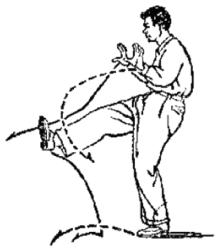
動作三:右足掌平落於左足旁踏實,左足向前上步,足尖對左前斜方,左腿前弓,右足隨即往前跟步,以足尖點於左足旁,兩腿仍變為左實右虛;隨左足上步的同時,左手經胸前向下摟過左膝,置於左腿旁,手指朝前,右手同時落至右胯旁握拳,拳心朝下,即在右足跟步時,向前下方徐徐擊出,右拳高與襠齊,兩臂微屈;身體同時微向前俯;面對正西方向。(圖206)
Movement 3:
Your right sole lowers beside your left foot and flattens, your left foot steps forward, toes pointing to the left forward corner, and the leg bends forward, your right foot then does a follow step, toes touching down beside your left foot, and your legs have become left full, right empty. When your left foot steps forward, your left hand passes in front of your chest and brushes downward past your left knee to be placed beside your left leg, fingers pointing forward. Your right hand at the same time lowers to your right hip and makes a fist, the fist center facing down, then when your right foot does the follow step, slowly strikes forward and down to crotch level, both arms slightly bent, your body slightly leaning forward. You are facing to the west. See drawing 206:

動作四:右足向前上步;同時右拳鬆開,兩手隨上體豎直變為立掌,舉至胸前,右手高、左手低,向前徐徐推出(上身不可前俯後仰),手心稍朝前,右手齊目,左手與胸平;左足隨兩手前推時往前跟步,以足尖點於右足跟後,兩腿變為右實左虛;面仍對正西方向。(圖207)
Movement 4:
Your right foot steps forward. At the same time, your right fist loosens open, both hands go along with your upper body as it straightens and become upright palms, raising to be in front of your chest, right hand above, left hand below, and slowly push out forward (without your upper body leaning forward or back), palms slightly facing forward, right hand at eye level, left hand at chest level. When your hands push forward, your left foot does a follow step, toes touching down behind your right heel, and your legs have become right full, left empty. You are facing to the west. See drawing 207:

第八十八式 單鞭(圖208─210)
Posture 88: SINGLE WHIP
第八十九式 下勢(圖211)
Posture 89: LOWERING
兩式合併為一個節序,動作一、二、三為“單鞭”,動作四為“下勢”。
These two postures combine to form a cycle of four: movements 1-3 are SINGLE WHIP, and movement 4 is LOWERING.
動作一與第五十六式“單鞭”動作一相同。(圖208)
Movement 1 is the same as in Posture 56. See drawing 208:

動作二、三、四與第三十一式“單鞭”和第三十二式“下勢”所合併的一個節序的動作二、三、四相同。(圖209─211)
Movements 2-4 are the same as in Postures 31&32. See drawing 209-211:



第九十式 上步七星(圖212)
Posture 90: STEP FORWARD WITH THE BIG DIPPER
第九十一式 退步跨虎(圖213)
Posture 91: RETREAT TO SITTING TIGER POSTURE
第九十二式 轉腳擺連(圖214)
Posture 92: REVOLVING-BASE SWINGING LOTUS KICK
第九十三式 彎弓射虎(圖215)
Posture 93: BEND THE BOW TO SHOOT THE TIGER
第九十四式 雙抱捶(圖216)
Posture 94: DOUBLE PUNCH
五式合併為一個節序,動作一為“上步七星”,動作二為“退步跨虎”,動作三為“轉腳擺連”和“彎弓射虎”,動作四為“雙抱垂”。
These five postures combine to form a cycle of four: movement 1 is STEP FORWARD WITH THE BIG DIPPER, movement 2 is RETREAT TO SITTING TIGER POSTURE, movement 3 is REVOLVING-BASE SWINGING LOTUS KICK and BEND THE BOW TO SHOOT THE TIGER, and movement 4 is DOUBLE PUNCH.
動作一:左足前邁,足尖正對前方,坐實左腿;身體向右微轉;右足往前跟步,以足尖點於左足跟旁,兩腿變為左實右虛;同時右手向右而下經胯旁向前抄起,與左手一同舉至胸前,兩手交叉,高與口齊,手指朝上,右手在外,手背相對;面朝正東方向(圖212)
Movement 1:
Your left foot steps forward, toes pointing forward, and your left leg sits full, your body slightly turning to the right [left]. Your right foot does a follow step, toes touching down beside your left heel, and your legs have become left full, right empty. At the same time, your right hand goes to the right, then down past the hip, and scoops forward, raising up together with your left hand to be in front of your chest, your hands overlapping at mouth level, fingers pointing up, right hand outside, backs of the hands facing each other. You are facing to the east. See drawing 212:
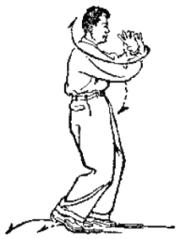
動作二:右足後退踏實,足尖對右前斜方,左足帶回,以足尖點於右足前,兩腿變為右實左虛;同時兩手隨動,右手向右上、左手向左下分開,右手立掌置於頭右前方,高與頂齊,左手手心朝下、手指朝前置於左胯前,兩臂彎曲;面對正東方向。(圖213)
Movement 2:
Your right foot steps back and flattens, toes pointing to the right forward corner, your left foot withdraws, toes touching down in front of your right foot, and your legs have become right full, left empty. At the same time, your hands go along with the movement, your right hand spreading away to the upper right, your left hand to the lower left, your right hand as an upright palm placed to the right and in front of your head at headtop level, your left palm facing down, fingers pointing forward, to be placed in front of your left hip, both arms bent. You are facing to the east. See drawing 213:

動作三:(轉腳擺連)左足提起(高與膝齊,足尖朝下)向右擺出,乘勢以右足掌為軸,身體向右後轉,左足向東北斜角落地踏實,右足隨即提起,經左腿前向上向右橫擺;兩手在轉身時仍如原狀,當右足提起時左手向右上角舉起與右手相齊,隨即兩手(先左後右)從右上而下迎拍向右擺出的右足面(圖214為轉腳擺連將要拍腳的姿勢)。
Movement 3: (REVOLVING-BASE SWINGING LOTUS KICK)
Your left foot lifts (knee level, toes pointing down), swings to the right, and riding the momentum by using your right sole as a pivot, your body turns to the right rear, your left foot comes down to the northeast corner and flattens, your right foot then lifts, passes in front of your left leg, and swings up and across to the right. While your body turns, your hands stay as they were positioned in the previous movement, then once your right foot lifts, your left hand raises to the upper right corner, level with your right hand, and then your hands (first left, then right) come down from the upper right to slap the top of your right foot as it swings out. See drawing 214 (which shows the position when your foot is about to be slapped):
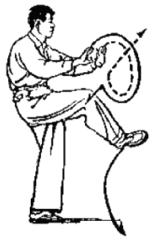
(彎弓射虎)接著右足向東南斜方落下,先以足跟著地,隨即左足跟蹬,右腿前弓,右足落平踏實,兩腿變為右實左虛;同時兩手向上而前向下划弧經右膝收回,經小腹前向上至胸前握拳,體重後移,隨著右腿再度前弓時左拳向左上斜方、右拳向右下斜方同時分開,成為拉弓式形,左拳拳心朝前,高與口平,右拳拳心朝下置於右胯前;面對東北斜方。(圖215)
(BEND THE BOW TO SHOOT THE TIGER)
Then your right foot comes down to the southeast corner, your heel first touching down, then your left heel presses, your right leg bends forward, sole flattening, and your legs have become right full, left empty. At the same time, your hands circle up, forward, down past your knee, withdrawing past your belly, and up to your chest, making fists, the weight shifting back, then when your right leg bends forward again, your left fist goes to the upper left corner, your right fist goes to the lower right corner, both spreading apart in unison, making a shape of drawing a bow. Your left fist center is facing forward at mouth level, and your right fist center is facing down, placed in front of your right hip. You are facing to the northeast corner. See drawing 215:
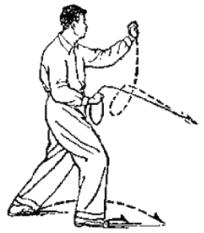
動作四:左腿提起,前邁一大步,先以足跟落地,隨即弓腿變實,右足往前跟步,以足尖點於左足跟後,兩腿變為右虛左實;兩拳在左足上步時分別落至左右胯旁,在右足跟步的同時,兩拳向上微提,隨即向前下方徐徐擊出,拳眼相對,高與腹齊,兩臂微屈,面對正東方向。(圖216)
Movement 4:
Your left foot lifts and takes a large step forward, heel first touching down, then your leg bends and becomes full, your right foot does a follow step, toes touching down behind your left heel, and your legs have become right empty, left full. When your left foot steps forward, your fists separate, lowering to be beside their respective hips, and when your right foot does the follow step, your fists slightly raise, then slowly strike forward and down, fist eyes facing each other, at belly level, both arms slightly bent. You are facing to the east. See drawing 216:
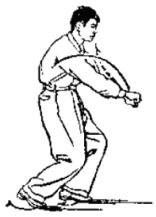
第九十五式 手揮琵琶勢(圖217)
Posture 95: PLAY THE LUTE
動作:右足提起,移至左足後,足尖正對南方踏實,左足收回,以左足尖點於右足前,兩腿變為右實左虛;同時身體右轉,兩拳提起變為立掌,在胸前各繞一小圈,成手揮琵琶勢,左手高與口平,右手落至腹前;面對南稍偏於東的斜方。(圖217)
Movement:
Your right foot lifts and shifts back behind your left foot, toes pointing to the south, the foot flattens, and your left foot retracts, the toes touching down in front of your right foot, and your legs have become right full, left empty. At the same time, your body turns to the right, your fists lift and become upright palms, winding a small circle in front of your chest to make the PLAY THE LUTE posture, left hand at mouth level, right hand at belly level. You are facing to the southeast corner. See drawing 217:

第九十六式 收勢(圖218─219)
Posture 96: CLOSING POSTURE
動作:左足向右併步,身體轉正,兩手分向左右下按,置於胯旁(圖218)。
Movement:
Your left foot goes to stand next to your right foot, your torso turns to be squarely forward, and your hands separate to the sides and push down to be placed beside your hips. See drawing 218:
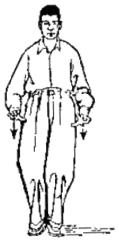
接著兩手自然下垂,身體正立,仍復為預備式姿勢。(圖219)
Then your hands hang down naturally, your body straightens, and there is return to the PREPARATION POSTURE. See drawing 219:

–
武式太極拳路線示意圖
MAP OF THE ROUTE THROUGH THE WU YUXIANG STYLE TAIJI BOXING SOLO SET
說明
Explanations:
1.本圖大致上標示出整套拳式所進行的路線和方向,可能與圖解裡的個別拳式的立身方向有大同小異的地方。
This map gives a rough indication of the route and orientations for the entire set of boxing postures. It for the most part conforms to the orientations of the body in the illustrations.
2.拳式從右到左和從左返右大都是在一條路線上來回進行的,但製圖時無法把上述情況標示出來。
Although there is no way to show it when drawing the map, the set travels back and forth from right to left then left to right.
3.在長方格內橫寫名稱者,如
![]()
是標示該式向南;直寫名稱者,如
![]()
是標示該式向西,其餘可據路線圖類推。
A posture name written horizontally within a box indicates the posture faces south. A posture name written vertically within a box indicates the posture faces west. From this you can reason out the rest. [Instead of turning the English text every which way, I simply indicate the compass directions throughout the accompanying lists of posture names below. Somewhat confusingly, the orientations according to the map are based on the direction your body is facing, which is not always the same as where your eyes are looking.]
4.兩方格相連接,如
![]()
和
![]()
,以及兩方格有一直角相連接者,都標示後一式是在前一式的原位進行的,其中偶有加箭號者,是標示後一式的轉身方向。後一式在前一式的原位內略有移動者,則以
![]()
等形式標示之。
When two boxes are connected by being stacked right on top of each other, placed directly next to each other, or are at right angles to each other, this indicates in each case that the next posture happens in the same place as the original posture. When the next posture shifts only slightly from the original posture’s position, this is indicated by boxes being placed in irregular alignments. When boxes are occasionally wrapped around by arrows, this indicates that in the next posture your body turns around.
5.拳式的進行方向,除兩方格相連接者外,都用箭號標示。
The direction a posture progresses toward, except in the cases when boxes are connected to each other, is always indicated by an arrow.
6.兩方格間有空檔者是標示後一式要上步,空檔較小者,上步亦較小。
Where there is space between two boxes [occupied only by arrows], this indicates advancing into the next posture. The smaller the space, the smaller the advance.
7.用虛線畫的方格標示與後一式的適當銜接,並非重複式子。
A box drawn with a dotted line indicates going on to the next posture, not repeating the same one over again.
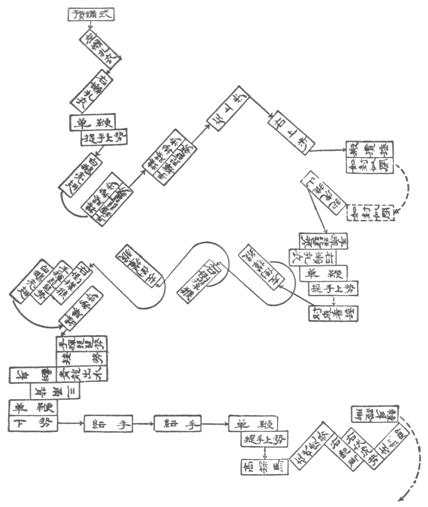
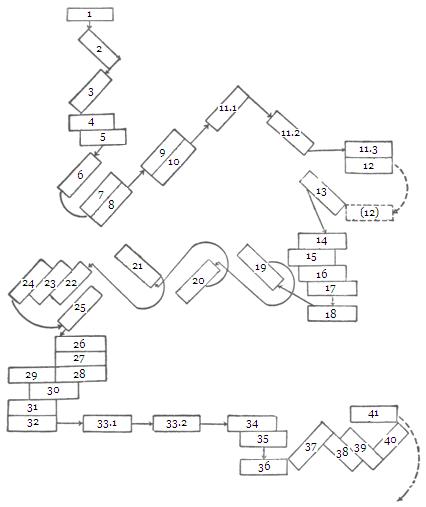
[1] 預備式 PREPARATION POSTURE [S]
[2] 左懶扎衣 LAZILY PULLING BACK THE ROBE – LEFT [SE]
[3] 右懶扎衣 LAZILY PULLING BACK THE ROBE – RIGHT [SW]
[4] 單鞭 SINGLE WHIP [S]
[5] 提手上勢 RAISE THE HAND [S]
[6] 白鵝亮翅 WHITE GOOSE SHOWS ITS WINGS [SW]
[7] 摟膝拗步 BRUSH KNEE IN A CROSSED STANCE [NE]
[8] 手揮琵琶勢 PLAY THE LUTE [NE]
[9] 摟膝拗步 BRUSH KNEE IN A CROSSED STANCE [NE]
[10] 手揮琵琶勢 PLAY THE LUTE [NE]
[11.1] 左上步 LEFT STEP FORWARD [NE]
[11.2] 右上步 RIGHT STEP FORWARD [SE]
[11.3] 搬攬捶 PARRY, TAKE IN, PUNCH [E]
[12] 如封似閉 SEALING SHUT [E]
[13] 抱虎推山 CAPTURE THE TIGER AND PUSH IT BACK TO ITS MOUNTAIN [NW]
[14] 手揮琵琶勢 PLAY THE LUTE [W]
[15] 右懶扎衣 LAZILY PULLING BACK THE ROBE – RIGHT [W]
[16] 單鞭 SINGLE WHIP [S]
[17] 提手上勢 RAISE THE HAND [S]
[18] 肘底看捶 GUARDING PUNCH UNDER THE ELBOW [E]
[19] 左倒攆猴 TURN LEFT TO DRIVE AWAY THE MONKEY [NW]
[20] 右倒攆猴 TURN RIGHT TO DRIVE AWAY THE MONKEY [SW]
[21] 左倒攆猴 TURN LEFT TO DRIVE AWAY THE MONKEY [NW]
[22] 右倒攆猴 TURN RIGHT TO DRIVE AWAY THE MONKEY [SW]
[23] 手揮琵琶勢 PLAY THE LUTE [SW]
[24] 白鵝亮翅 WHITE GOOSE SHOWS ITS WINGS [SW]
[25] 摟膝拗步 BRUSH KNEE IN A CROSSED STANCE [NE]
[26] 手揮琵琶勢 PLAY THE LUTE [E]
[27] 按勢 PUSHING DOWN [E]
[28] 青龍出水 BLUE DRAGON LEAVES THE WATER [E]
[29] 翻身 TURN AROUND [W]
[30] 三甬背 THREE THROUGH THE BACK [W]
[31] 單鞭 SINGLE WHIP [S]
[32] 下勢 LOWERING [S]
[33.1] 紜手 TANGLING HANDS (1) [S]
[33.2] 紜手 TANGLING HANDS (2) [S]
[34] 單鞭 SINGLE WHIP [S]
[35] 提手上勢 RAISE THE HAND [S]
[36] 高探馬 RISING UP AND REACHING OUT TO THE HORSE [E]
[37] 左伏虎勢 SUBDUE THE TIGER – LEFT [NE]
[38] 右起腳 RIGHT LIFTING KICK [SW]
[39] 右伏虎勢 SUBDUE THE TIGER – RIGHT [SW]
[40] 左起腳 LEFT LIFTING KICK [NE]
[41] 轉身蹬腳 TURN AROUND, PRESSING KICK [W]


[41] 轉身蹬腳 TURN AROUND, PRESSING KICK [W]
[42] 單鞭 SINGLE WHIP [N]
[43] 踐步打捶 STEP SUCCESSIVELY, PUNCH [W]
[44.1] 翻身二起 TURN AROUND, DOUBLE KICK (1) [E]
[44.2] 翻身二起 TURN AROUND, DOUBLE KICK (2) [E]
[45] 披身 DRAPE THE BODY [E]
[46] 退步踢腳 STEP BACK, SNAPPING KICK [E]
[47] 轉身蹬腳 TURN AROUND, PRESSING KICK [E]
[48] 上步搬攬捶 STEP FORWARD, PARRY, TAKE IN, PUNCH [E]
[49] 如封似閉 SEALING SHUT [E]
[50] 抱虎推山 CAPTURE THE TIGER AND PUSH IT BACK TO ITS MOUNTAIN [NW]
[51] 手揮琵琶勢 PLAY THE LUTE [NW]
[52] 右懶扎衣 LAZILY PULLING BACK THE ROBE – RIGHT [NW]
[53] 斜單鞭 DIAGONAL SINGLE WHIP [SW]
[54] 下勢 LOWERING [S]
[55.1] 野馬分鬃 WILD HORSE PARTS ITS MANE (1) [SW]
[55.2] 野馬分鬃 WILD HORSE PARTS ITS MANE (2) [NW]
[55.3] 野馬分鬃 WILD HORSE PARTS ITS MANE (3) [SW]
[55.4] 野馬分鬃 WILD HORSE PARTS ITS MANE (4) [W]
[56] 單鞭 SINGLE WHIP [S]
[57.1] 玉女穿梭 MAIDEN WORKS THE SHUTTLE (1) [SW]
[57.2] 玉女穿梭 MAIDEN WORKS THE SHUTTLE (2) [SE]
[57.3] 玉女穿梭 MAIDEN WORKS THE SHUTTLE (3) [NE]
[57.4] 玉女穿梭 MAIDEN WORKS THE SHUTTLE (4) [NW]
[58] 手揮琵琶勢 PLAY THE LUTE [W]
[59] 右懶扎衣 LAZILY PULLING BACK THE ROBE – RIGHT [W]
[60] 單鞭 SINGLE WHIP [S]


[60] 單鞭 SINGLE WHIP [S]
[61] 下勢 LOWERING [S]
[62.1] 紜手 TANGLING HANDS (1) [S]
[62.2] 紜手 TANGLING HANDS (2) [S]
[63] 單鞭 SINGLE WHIP [S]
[64] 下勢 LOWERING [S]
[65] 更雞獨立 ROOSTER STANDS ON ONE LEG [E]
[66] 左倒攆猴 TURN LEFT TO DRIVE AWAY THE MONKEY [NW]
[67] 右倒攆猴 TURN RIGHT TO DRIVE AWAY THE MONKEY [SW]
[68] 左倒攆猴 TURN LEFT TO DRIVE AWAY THE MONKEY [NW]
[69] 右倒攆猴 TURN RIGHT TO DRIVE AWAY THE MONKEY [SW]
[70] 手揮琵琶勢 PLAY THE LUTE [SW]
[71] 白鵝亮翅 WHITE GOOSE SHOWS ITS WINGS [SW]
[72] 摟膝拗步 BRUSH KNEE IN A CROSSED STANCE [NE]
[73] 手揮琵琶勢 PLAY THE LUTE [E]
[74] 按勢 PUSHING DOWN [E]
[75] 青龍出水 BLUE DRAGON LEAVES THE WATER [E]
[76] 翻身 TURN AROUND [W]
[77] 三甬背 THREE THROUGH THE BACK [W]
[78] 單鞭 SINGLE WHIP [S]
[79] 下勢 LOWERING [S]
[80.1] 紜手 TANGLING HANDS (1) [S]
[80.2] 紜手 TANGLING HANDS (2) [S]
[81] 單鞭 SINGLE WHIP [S]
[82] 提手上勢 RAISE THE HAND [S]
[83] 高探馬 RISING UP AND REACHING OUT TO THE HORSE [E]
[84] 對心掌 PALM TO THE SOLAR PLEXUS [E]
[85] 轉身十字擺連 TURN AROUND, CROSSED-BODY SWINGING LOTUS KICK [W]
[86] 上步指襠捶 STEP FORWARD, PUNCH TO THE CROTCH [W]
[87] 右懶扎衣 LAZILY PULLING BACK THE ROBE – RIGHT [W]
[88] 單鞭 SINGLE WHIP [S]
[89] 下勢 LOWERING [S]
[90] 上步七星 STEP FORWARD WITH THE BIG DIPPER [E]
[91] 退步跨虎 RETREAT TO SITTING TIGER POSTURE [E]
[92] 轉腳擺連 REVOLVING-BASE SWINGING LOTUS KICK [E]
[93] 彎弓射虎 BEND THE BOW TO SHOOT THE TIGER [E]
[94] 雙抱捶 DOUBLE PUNCH [E]
[95] 手揮琵琶勢 PLAY THE LUTE [S]
[96] 收勢 CLOSING POSTURE [S]
–
武式太極拳推手圖解
WU YUXIANG STYLE TAIJI BOXING PUSHING HANDS WITH DIAGRAMS
太極拳推手,原名打手。武禹襄、李亦畬二人所傳授下來的,僅有活步推手一種。為什麼只采取活步推手,而不用定步呢?原因是活步推手可以靈活運用,沒有呆滯之弊,既可鍛煉步法和身法,同時又可練習“沾、連、粘、隨”;且在運動之時,經常得以保持中正穩定的姿勢,動中仍可發勁。練熟之後,可以達到古人所說:“行、止、坐、臥”都是練拳的境界。
武式推手的步法是進步三步半,退步三步半:第一步、第二步前進時,進步的一足都是踏在對方前足的外側,第三步前進時,一足踏在對方襠步中間,第四步則後足移至前足邊,足尖虛點地,稱為半步。無論踏在對方外側或襠步中間,都應該稍為貼近對方前足。在一條直線上我進彼退,彼進我退,上邊運用“掤、捋、擠、按”四手,和其它各式推手相同,故不再繪圖說明,僅將其中幾個發勁的姿勢,列在後面作參考。(圖220─225)
Taiji Boxing’s pushing hands was originally called “playing hands”. What Wu Yuxiang and Li Yiyu passed down was only the moving step pushing hands. Why did they adopt the moving step pushing hands and not use the fixed step version? Because the moving step pushing hands can be nimbly applied and does not have the drawback of being stagnant. It can also develop the footwork and the body standards, as well as training “sticking, connecting, adhering, and following”.
When doing the exercise, constantly be able to maintain a balanced and stable posture, so that during the movement you can still issue power. Once you have trained it until it is part of you, then you can achieve what the earlier generations talked about: the condition in which you are always practicing the boxing, whether “walking, standing, sitting, or lying down”.
The footwork of Wu Yuxiang Style pushing hands is: advance three and a half steps, retreat three and a half steps. When advancing with the first two steps, they each step down to the outside of the opponent’s front foot. When advancing with the third step, step between his legs. For the fourth step, your rear foot shifts to be beside your front foot, toes lightly touching down, and is considered a half step. Whether stepping to the opponent’s outside or inside, in either case it should slightly close in toward his front foot.
As we go along a straight line, I advancing and he retreating, then he advancing and I retreating, our upper bodies are performing the four techniques of “ward-off, rollback, press, and push”. Since this is the same as in the pushing hands of the other styles, we will not add more pictures to explain it, and here only present a few postures for issuing power during the exercise, exhibited here in the back of the book for the sake of reference. See drawings 220-225:
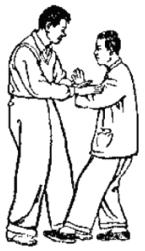


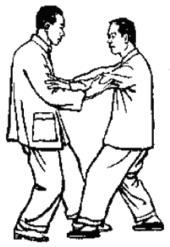


–
附錄 古典拳論
APPENDIX – CLASSIC BOXING TEXTS
太極拳論 山右王宗岳
THE TAIJI BOXING TREATISE (by Wang Zongyue of Shanxi)
太極者,無極而生,陰陽之母也。動之則分,靜之則合。無過不及,隨曲就伸。人剛我柔,謂之走;我順人背,謂之粘。動急則急應,動緩則緩隨。雖變化萬端,而理唯一貫。由著熟而漸悟懂勁,由懂勁而階及神明。然非用力之久,不能豁然貫通焉。虛領頂勁,氣沉丹田;不偏不倚,忽隱忽現;左重則左虛,右重則右杳。仰之則彌髙,俯之則彌深;進之則愈長,退之則愈促。一羽不能加,蠅蟲不能落;人不知我,我獨知人。英雄所向無敵,蓋皆由此而及也。斯技旁門甚多,雖勢有區別,概不外壯欺弱,慢讓快耳;有力打無力,手慢讓手快,是皆先天自然之能,非關學力而有也。察“四兩撥千斤”之句,顯非力勝;觀耄耋禦眾之形,快何能為?立如秤準,活似車輪;偏沉則隨,雙重則滯。每見數年純功,不能運化者,率皆自為人制,雙重之病未悟耳。欲避此病,須知陰陽;粘即是走,走即是粘;陽不離陰,陰不離陽;陰陽相濟,方為懂勁。懂勁後,愈練愈精,默識揣摩,漸至從心所欲。本是舍己從人,多誤舍近求遠。所謂“差之毫厘;謬之千里”,學者不可不詳辨焉。是為論。
Taiji [“grand polarity”] is born of wuji [“nonpolarity”], and is the mother of yin and yang [the passive and active aspects]. When there is movement, they [passive and active] become distinct from each other. When there is stillness, they return to being indistinguishable.
Neither going too far nor not far enough, comply and bend then engage and extend. He is hard while I am soft – this is yielding. My energy is smooth while his energy is coarse – this is sticking. If he moves fast, I quickly respond, and if his movement is slow, I leisurely follow. Although there is an endless variety of possible scenarios, there is only this single principle [of yielding and sticking] throughout.
Once you have ingrained these techniques, you will gradually come to identify energies, and then from there you will work your way toward something miraculous. But unless you practice a lot over a long time, you will never have a breakthrough.
With your headtop pressing up naturally and energy sinking down to your elixir field, there will be no leaning in any direction. Suddenly vanish then suddenly manifest. If he puts pressure on my left side, my left side empties, or if he puts pressure on my right side, my right side disappears. If he tries to find me above, he has to keep reaching higher, or if he tries to find me below, he has to keep reaching lower. When he advances, he cannot get to me, but once he retreats, he cannot get away from me. A feather cannot be added and a fly cannot land. He does not know me, only I know him. A hero is one who encounters no opposition, and it is through this kind of method that such a condition is achieved.
There are many other schools of martial arts besides this one. Although the postures are different between them, they generally do not go beyond the strong bullying the weak and the slow yielding to the fast. The strong beating the weak and the slow submitting to the fast are both a matter of inherent natural ability and bear no relation to skill that is learned. Examine the phrase “four ounces moves a thousand pounds”, which is clearly not a victory obtained through strength. Or consider the sight of an old man repelling a group, which could not come from an aggressive speed.
Standing like a scale, move like a wheel. If you drop one side, you can move, but if you have equal pressure on both sides, you will be stuck. We often see one who has practiced hard for many years yet is unable to perform any neutralizations and is generally under the opponent’s control, and the issue here is that this error of double pressure has not yet been understood.
If you want to avoid this error, you must understand passive and active. In sticking there is yielding and in yielding there is sticking. The active does not depart from the passive and the passive does not depart from the active, for the passive and active exchange roles. Once you have this understanding, you will be identifying energies. Once you are identifying energies, then the more you practice, the more efficient your skill will be, and by absorbing through experience and by constantly contemplating, gradually you will reach the point that you can do whatever you want.
The basic of basics is to forget about your plans and simply respond to the opponent. We often make the mistake of ignoring what is right in front of us in favor of something that has nothing to do with our immediate circumstances. For such situations it is said: “Miss by an inch, lose by a mile.” You must understand all this clearly. That is why it has been written down for you.
–
十三勢(一名長拳,一名十三勢) 山右王宗岳
THE THIRTEEN DYNAMICS – KNOWN AS LONG BOXING, ALSO KNOW THE THIRTEEN DYNAMICS (by Wang Zongyue of Shanxi)
長拳者:如長江大海,滔滔不絕也。
十三勢者:掤捋擠按採挒肘靠進退顧盼定也。掤捋擠按,即坎離震兌四正方也。採挒肘靠,即乾坤艮巽四斜角也。此八卦也。進步、退步、左顧、右盼、中定,即金木水火土也。此五行也。合而言之,曰十三勢。
Long Boxing: it is like a long river flowing into the wide ocean, on and on ceaselessly…
The thirteen dynamics are: warding off, rolling back, pressing, pushing, plucking, rending, elbowing, bumping, advancing, retreating, stepping to the left, stepping to the right, and staying in the center.
Warding off, rolling back, pressing, pushing, plucking, rending, elbowing, and bumping relate to the eight trigrams:
☴☲☷
☳ ☱
☶☵☰
Warding off, rolling back, pressing, and pushing correspond to ☵, ☲, ☳, and ☱ in the four principle compass directions [meaning simply that these are the primary techniques]. Plucking, rending, elbowing, and bumping correspond to ☰, ☷, ☶, and ☴ in the four corner directions [i.e. are the secondary techniques].
Advancing, retreating, stepping to the left, stepping to the right, and staying in the center relate to metal, wood, water, fire, and earth – the five elements.
These combined [8+5] are called the Thirteen Dynamics.
–
十三勢行工歌訣 (作者待考)
SONG OF PRACTICING THE THIRTEEN DYNAMICS (authorship awaiting verification)
十三總勢莫輕識,命意源頭在腰隙,
變轉虛實須留意,氣遍身軀不稍癡。
靜中觸動動猶靜,因敵變化是神奇,
勢勢存心揆用意,得來不覺費工夫。
刻刻留心在腰間,腹內鬆靜氣騰然,
尾閭正中神貫頂,滿身輕利頂頭懸。
仔細留心向推求,屈伸開合聽自由,
入門引路須口授,工用無息法自休。
若言體用何為準,意氣君來骨肉臣;
詳推用意終何在?益壽延年不老春。
歌兮歌兮百四十,字字真切義無疑,
若不向此推求去,枉費工夫遺歎惜!
Do not neglect any of the thirteen dynamics,
their command coming from your lower back.
You must pay attention to the alternation of empty and full,
then energy will flow through your whole body without getting stuck anywhere.
In stillness, movement stirs, and then once in motion, seem yet to be in stillness,
for the magic lies in making adjustments based on being receptive to the opponent.
In every movement, very deliberately control it by the use of intention,
for once you achieve that, it will all be effortless.
At every moment, pay attention to your waist,
for if there is relaxation and stillness within your belly, energy is primed.
Your tailbone is centered and spirit penetrates to your headtop,
thus your whole body will be nimble and your headtop will be pulled up as if suspended.
Pay careful attention in your practice that you are letting bending and extending, contracting and expanding, happen as the situation requires.
Beginning the training requires personal instruction,
but mastering the art depends on your own unceasing effort.
Whether we are discussing in terms of theory or function, what is the constant?
It is that mind is sovereign and body is subject.
If you think about it, what is emphasizing the use of intention going to lead you to?
To a longer life and a longer youth.
Repeatedly recite the words above,
all of which speak clearly and hence their ideas come through without confusion.
If you pay no heed to those ideas, you will go astray in your training,
and you will find you have wasted your time and be left with only sighs of regret.
–
打手歌 王宗岳修訂
PLAYING HANDS SONG (revised by Wang Zongyue)
掤捋擠按須認真,上下相隨人難進。
任他巨力來打我,牽動四兩撥千斤。
引進落空合即出,沾連粘隨不丟頂。
Ward-off, rollback, press, and push must be taken seriously.
With coordination between above and below, the opponent will hardly find a way in.
I will let him attack me with as much power as he likes,
for I will tug with four ounces of force to move his of a thousand pounds.
Guiding him in to land on nothing, I then close on him and send him away.
I stick to him and go along with his movement instead of coming away or crashing in.
–
身法 武禹襄
BODY STANDARDS (by Wu Yuxiang)
涵胸、拔背、裹襠、護肫、提頂、吊襠、騰挪、閃戰。
– Contain your chest.
– Pluck up your back.
– Wrap your crotch.
– Shield your belly.
– Lift your headtop.
– Suspend your crotch.
– Always be ready.
– Get it over with in a flash.
–
打手要言 武禹襄
ESSENTIALS OF PLAYING HANDS (by Wu Yuxiang)
解曰:
A commentary [to the Thirteen Dynamics Song]:
以心行氣,務沉著,乃能收斂入骨,所謂“命意源頭在腰隙”也。
Use your mind to move energy. You must get the energy to sink. It is then able to gather into your spine. The Song says [line 2]: “The command comes from your lower back.”
意氣須換得靈,乃有圓活之趣,所謂“變轉虛實須留意”也。
Your mind must perform alternations nimbly, and then you will possess the qualities of roundness and liveliness. The Song says [line 3]: “You must pay attention to the alternation of empty and full.”
立身中正安舒,支撐八面;行氣如九曲珠,無微不到,所謂“氣遍身軀不稍癡”也。
Your posture must be straight and comfortable, so as to brace in all directions. But move energy as though through a winding-path pearl, penetrating even the smallest nook. The Song says [line 4]: “Energy will flow through your whole body without getting stuck anywhere.”
發勁須沉著鬆靜,專注一方,所謂“靜中觸動動猶靜”也。
When issuing power, you must be calm, relaxed, and still, so as to concentrate it in one direction. The Song says [line 5]: “In stillness, movement stirs, and then once in motion, seem yet to be in stillness.”
往復須有摺叠,進退須有轉換,所謂“因敵變化是神奇”也。
In the back and forth [of the arms], there must be folding. In the advance and retreat [of the feet], there must be variation. The Song says [line 6]: “The magic lies in making adjustments based on being receptive to the opponent.” [The Song in this line is quoting from the Art of War, chapter 6: 能因敵變化而取勝者謂之神 “A general able to seize victory because of the enemy’s changes can deservedly be described a magician.”]
曲中求直,蓄而後發,所謂“勢勢存心揆用意,刻刻留心在腰間”也。
Within curving, seek to be straightening. Store and then issue. The Song says [line 7]: “In every movement, very deliberately control it by the use of intention.” And also [line 9]: “At every moment, pay attention to your waist.”
精神提得起,則無遲重之虞,所謂“腹內鬆靜氣騰然”也。
If you raise your spirit, then you will be free from any worry of being slow or weighed down. The Song says [line 10]: “If there is relaxation and stillness within your belly, energy is primed.”
虛領頂勁,氣沉丹田,不偏不倚,所謂“尾閭正中神貫頂,滿身輕利頂頭懸”也。
With your headtop pressing up naturally and energy sinking down to your elixir field, there will be no leaning in any direction. The Song says [lines 11 & 12]: “Your tailbone is centered and spirit penetrates to your headtop, thus your whole body will be nimble and your headtop will be pulled up as if suspended.”
以氣運身,務順遂,乃能便利從心,所謂“屈伸開合聽自由”也。
Use energy to move your body. You must get the energy to be smooth. Your body can then easily obey your mind. The Song says [line 14]: “Let bending and extending, contracting and expanding, happen as the situation requires.”
心為令,氣為旗,神為主帥,身為驅使,所謂“意氣君來骨肉臣”也。
Your mind makes the command and the energy is its signal flag. Your spirit is the general and your body is the army. The Song says [line 18]: “Mind is sovereign and body is subject.”
解曰:身雖動,心貴靜,氣須斂,神宜舒。心為令,氣為旗,神為主帥,身為驅使,刻刻留意,方有所得。先在心,後在身。在身則不知手之舞之,足之蹈之。所謂一氣呵成,舍己從人,引進落空,四兩撥千斤也。須知一動無有不動,一靜無有不靜,視動猶靜,視靜猶動,內固精神,外示安逸。須要從人,不要由己;從人則活,由己則滯。尚氣者無力,養氣者純剛。彼不動,己不動;彼微動,己先動。以己依人,務要知己,乃能隨轉隨接;以己粘人,必須知人,乃能不後不先。精神能提得起,則無遲重之虞;粘依能跟得靈,方見落空之妙。往復須分陰陽,進退須有轉合。機由己發,力從人借。發勁須上下相隨,乃一往無敵;立身須中正不偏,能八面支撐。靜如山岳,動若江河。邁步如臨淵,運勁如抽絲,蓄勁如張弓,發勁如放箭。行氣如九曲珠,無微不到;運勁如百煉鋼,何堅不摧。形如搏兔之鵠,神如捕鼠之貓。曲中求直,蓄而後發。收即是放,連而不斷。極柔軟,然後能極堅剛;能粘依,然後能靈活。氣以直養而無害,勁以曲蓄而有餘。漸至物來順應,是亦知止能得矣。
To further clarify:
Although your body moves, your mind should be still, energy must gather, and spirit should be at ease. Your mind makes the command and the energy is its signal flag. Your spirit is the general and your body is the army.
If you pay attention at every moment, there is always an advantage to be had.
First in your mind, then in your body. Once in your body, you will not be aware of the movements of your hands and feet.
It is said: “In an uninterrupted flow from beginning to end, let go of your plans and just respond to the opponent, draw him in to land on nothing, and with four ounces of force move his of a thousand pounds.”
You must keep in mind: if one part moves, every part moves, and if one part is still, every part is still. Regard movement as stillness and stillness as movement.
Inwardly bolster spirit. Outwardly show ease.
You must act according to your opponent, not try to do things from yourself, for if you go along with your opponent, you can act spontaneously, but if you act from yourself, you will get bogged down.
If you obsess over the energy, there will be no power, whereas if you ignore the energy and thereby nurture it, there will be pure strength.
If he takes no action, I take no action, but once he takes even the slightest action, I have already acted.
For you to follow him, you have to know yourself, and then you can adapt and connect to him. For you to stick to him, you have to know him, and then you will be neither too late nor too early.
If you can raise your spirit, then you will not have to worry about double pressure. If in sticking to the opponent you can follow him alertly, then you will find the ability to unbalance him.
In the back and forth [of the arms], there must be distinguishing between passive and active. In the advance and retreat [of the feet], there must be both variation and coherence.
If an opportunity comes from yourself, go ahead and shoot, but when force comes from your opponent, borrow it.
When you issue power, there must be coordination between above and below, and then directed at an undefended area. Your posture must be straight and not leaning in any direction, so as to be able to brace in all directions.
In stillness, be like a mountain. In movement, be like a river.
Step as if near a cliff edge. Move energy as if drawing silk.
Store power like drawing a bow. Issue power like loosing an arrow.
Move energy as though through a winding-path pearl, penetrating even the smallest nook. Wield power like tempered steel, so strong there is nothing tough enough to stand up against it.
The shape is like a falcon capturing a rabbit. The spirit is like a cat pouncing on a mouse.
Within curving, seek to be straightening. Store and then issue. To gather is to release, for there is no discontinuity between the two moments.
If you can be extremely soft, then you can be extremely hard. If you can stick and follow, then you can be nimble.
By nurturing energy with integrity, it will not be corrupted. By storing power in crooked parts, it will be in abundant supply.
Gradually you will reach a point in which everything you do is a response [rather than an initiation of attempt], and thus you will achieve the condition of dispensing with greed and thereby getting what you want.
又曰:先在心,後在身,腹鬆,氣斂入骨,神舒體靜,刻刻存心。切記一動無有不動,一靜無有不靜。視靜猶動,視動猶靜。動牽往來氣貼背,斂入脊骨,要靜。內固精神,外示安逸。邁步如貓行,運勁如抽絲。全身意在蓄神,不在氣,在氣則滯。有氣者無力,無氣者純剛。氣如車輪,腰如車軸。
In addition:
First in your mind, then in your body. With your abdomen relaxed, energy collects into your bones. Spirit comfortable, body calm – at every moment be mindful of this.
Always remember: if one part moves, every part moves, and if one part is still, every part is still. Regard stillness as movement and movement as stillness.
As the movement leads back and forth, energy sticks to your back, gathers in your spine, and there should be stillness.
Inwardly bolster spirit. Outwardly show ease.
Step like a cat. Move energy as if drawing silk.
Throughout your body, your mind should be on the spirit rather than on the energy, for if you are fixated on the energy, your movement will become sluggish. Whenever your mind is on the energy, there will be no power, whereas if you ignore the energy and let it take care of itself, there will be pure strength.
The energy is like a wheel. The waist is like an axle.
又曰:彼不動,己不動;彼微動,己先動。似鬆非鬆,將展未展。勁斷意不斷。
In addition:
If he takes no action, I take no action, but once he takes even the slightest action, I have already acted. It seems relaxed but not relaxed, about to express but not yet expressing. Although the power finishes, the intent of it continues.
又曰:每一動,惟手先著力,隨即鬆開。猶須貫串,不外起承轉合。始而意動,既而勁動,轉接要一線串成。氣宜鼓蕩,神宜內斂。無使有缺陷處,無使有凹凸處,無使有斷續處。其根在腳,發於腿,主宰於腰,形於手指。由腳而腿而腰,總須完整一氣。向前退後,乃得機得勢,有不得機勢處,身便散亂,必至偏倚,其病必於腰腿求之,上下前後左右皆然。凡此皆是意,不是外面,有上即有下,有前即有後,有左即有右,如意要向上,即寓下意,若物將掀起,而加以挫之之力,斯其根自斷,乃壞之速而無疑。虛實宜分清楚,一處自有一處虛實,處處總此一虛實;周身節節貫串,勿令絲毫間斷。
In addition:
Every movement is a technique of first putting forth strength and then immediately relaxing, yet always there must be continuity from one to other, and there is never to be a departure from the four stages of “begin, develop, transmit, and finish”. First the intention moves, then the power is moved, and the transition from one to the other should connect them together into a single action. Energy should be roused and spirit should be collected within. Do not allow there to be cracks or gaps anywhere, pits or protrusions anywhere, breaks in the flow anywhere.
Starting from your foot, issue through your leg, directing it at your waist, and expressing it at your fingers. From foot through leg through waist, it must be a fully continuous process, and whether advancing or retreating, you will then gain the opportunity and the position. If you do not gain the opportunity and the position, your body will be in disorder, inevitably causing you to lean all over the place. The problem must be in your waist and legs, so look for it there, for whatever the direction of the movement – up, down, front, back, left, right – that is where the problem lies.
All of these things are matters of intention, and are not external. With an upward comes a downward, with a forward comes a backward, and with a left comes a right. If your intention wants to go upward, then harbor a downward intention, like when you reach down to lift up an object. You thereby add a setback to the opponent’s own intention, thus he cuts his own root and is defeated quickly and certainly.
Empty and full must be distinguished clearly. In each part there is a part that is empty and a part that is full. Everywhere it is always like this, an emptiness and a fullness. Throughout your body, as the movement goes from one section to another there has to be connection. Do not allow the slightest break in the connection.
–
打手撒放
PLAYING HANDS RELEASINGS
掤上平 業入聲 噫上聲 咳入聲 呼上聲 吭 呵 哈
“Peng!” “Ye!” “Yi!” “Hai!” “Hu!” “Keng!” “He!” “Ha!”
–
五字訣 李亦畬
THE FIVE-WORD FORMULA (by Li Yiyu)
一曰心靜
1. The mind is CALM.
心不靜則不專,一舉手前後左右全無定向,故要心靜。起初舉動未能由己,要息心體認,隨人所動,隨屈就伸,不丟不頂,勿自伸縮。彼有力我亦有力,我力在先;彼無力我亦無力,我意仍在先。要刻刻留心,挨何處心要用在何處,須向不丟不頂中討消息。從此做去,一年半載便能施於身。此全是用意,不是用勁,久之則人為我制,我不為人制矣。
If your mind is not calm, it will not be focused, and each movement of your hands, be it forward or back, left or right, will not be in any definite direction. Therefore your mind should be calm. At first your movement will not yet be able to come from yourself, and so you should clear your mind and let your body intuit, going along with the opponent’s movements. Bend and then extend, neither coming away nor crashing in, and do not expand and contract on your own. When the opponent has power, I also have power, but my power beats him to the punch. When he has no power, I also have no power, for it is my intention that beats him to the decision. You should constantly pay attention. Wherever the opponent nears you, your mind should go there. You must neither come away nor crash in, and then you will be able to analyze what is going on. After doing this for about a year or so, it will become a natural part of you. This is entirely a matter of using intention and is not a matter of using strength. Over time, you will reach the point in which you can say “he is under my control and I am not under his”.
二曰身靈
2. The body is LIVELY.
身滯則進退不能自如,故要身靈。舉手不可有呆像,彼之力方礙我皮毛,我之意已入彼骨裡。兩手支撐,一氣貫穿。左重則左虛,而右已去;右重則右虛,而左已去。氣如車輪,周身俱要相隨,有不相隨處,身便散亂,便不得力,其病於腰腿求之。先以心使身,從人不從己。後身能從心,由己仍是從人。由己則滯,從人則活。能從人手上便有分寸。枰彼勁之大小,分厘不錯;權彼來之長短,毫髮無差。前進後退,處處恰合,工彌久而技彌精矣。
When your body is sluggish, advancing and retreating cannot be done smoothly. Therefore your body should be lively. When moving your hands, there must be nothing resembling hesitation. When the opponent’s force hinders even the hairs on my skin, my intention instantly enters his bones and my hands are bracing him, all as one event. If he puts pressure on my left side, I empty my left side and my right side goes forth, or if he puts pressure on my right side, I empty my right side and my left side goes forth, the energy like a wheel. Your whole body should be coordinated. If there is a lack of coordination anywhere, your body will then be disorganized, and you will then have no power. Seek for the problem in your hips. First use your mind to command your body, and follow the opponent rather than yourself. Later your body will be able to follow your mind, yet this moving from yourself will still depend on following the opponent. If you act from yourself, you will be sluggish. If you follow the opponent, you will be lively. If you can follow the opponent, your hands on him will detect in finer detail, weighing the size of his power and being accurate to the smallest measure, assessing the length of his attack and not being off by the slightest bit, and you will advance and retreat always at the right moment. The more you work at it, the more perfected your skill will be.
三曰氣斂
3. The energy is COLLECTED.
氣勢散漫,便無含蓄,身易散亂,務使氣斂入脊骨。呼吸通靈,周身罔間。吸為合為蓄,呼為開為發,蓋吸則自然提得起,亦拏得人起,呼則自然沉得下,亦放得人出。此是以意運氣,非以力使氣也。
If your energy is scattered, then it will not be stored, and your body will easily fall into disorder. You must cause the energy to collect into your spine. Inhaling and exhaling penetrates and enlivens, influencing every part of your body. Inhaling is contracting and storing. Exhaling is expanding and releasing. Since with inhaling there is a natural rising, take the opponent up. Since with exhaling there is a natural sinking, send the opponent away. This is the use of intention to move energy, not the use of exertion to force energy.
四曰勁整
4. The power is COMPLETE.
一身之勁,練成一家。分清虛實,發勁要有根源,勁起腳根,主於腰間,形於手指,發於脊背,又要提起全付精神,於彼勁將出未發之際,我勁已接入彼勁,恰好不後不先,如皮燃火,如泉湧出。前進後退,無絲毫散亂,曲中求直,蓄而後發,方能隨手奏效。此謂“借力打人,四兩撥千斤”也。
The power of your whole body is trained to become a single unit, distinguishing clearly between empty and full. To issue power, there should be a source of it. Power starts from your heel, it is directed at your waist, and expresses at your fingers, issuing from your spine. With it there should also be a rousing of all your spirit. When the opponent’s power is about to come out but has not yet issued, my power connects with and invades his instantly, neither late nor early, as if my skin is a burning fire or as if a spring is gushing forth. I advance and retreat without the slightest disorder, and seeking the straight within the curved, I store and then issue. Thus I am able to be effortlessly successful. This is called “borrowing his force to hit him with” or “using four ounces to move a thousand pounds”.
五曰神聚
5. The spirit is GATHERED.
上四者俱備,總歸神聚,神聚則一氣鼓鑄,煉氣歸神,氣勢騰挪。精神貫注,開合有致,虛實清楚。左虛則右實,右虛則左實。虛非全然無力,氣勢要有騰挪;實非全然占煞,精神要貴貫注。緊要全在胸中腰間運化,不在外面。力從人借,氣由脊發。胡能氣由脊發?氣向下沉,由兩肩收於脊骨,注於腰間,此氣之由上而下也,謂之合。由腰形於脊骨,布於兩膊,施於手指,此氣之由下而上也,謂之開。合便是收,開即是放。能懂得開合,便知陰陽。到此地位,工用一日,技精一日,漸至從心所欲,罔不如意矣。
With the four above prepared, finally spirit gathers. Once spirit is gathered, then energy is tempered, and this smelted energy then reinforces spirit. Energy is ready to move and spirit is concentrated. Expand and contract are decisive. Empty and full are distinct. When left is empty, right is full. When right is empty, left is full. Empty does not mean you are in that area completely weak, but that energy should there be ready to move. Full does not mean you are in that area completely stuck, but that spirit should there be concentrated. It is crucial that changes are within your chest and waist and are not external. Force is borrowed from the opponent. Energy is issued from your spine. How can energy issue from your spine? It sinks downward, going from your shoulders, gathering in your spine, and concentrates in your waist. This energy going from above to below is called “contracting”. Then it goes from your waist to your spine, spreading to your arms to be applied at your fingers. This energy going from below to above is called “expanding”. Contracting is gathering. Expanding is releasing. When you can understand expanding and contracting, then you will understand passive and active. When you reach this state, then daily work will yield daily refinement, and gradually you will reach the point that you can do whatever you want and everything will happen as you imagine.
–
撒放密訣 李亦畬
THE TRICK TO RELEASING (by Li Yiyu)
擎 引 鬆 放
Raise, draw in, relax, and release.
擎起彼身借彼力。中有靈字
引到身前勁始蓄。中有斂字
鬆開我勁勿使屈。中有靜字
放時腰腳認端的。中有整字
I get the opponent’s body to rise up and I borrow his force. (This has to do with “lively”.)
Once I have drawn him in front of me, my power begins to store. (This has to do with “collected”.)
I relax my power, but I do not allow it to collapse. (This has to do with “calm”.)
When I release, it comes from my waist and legs. (This has to do with “complete”.)
–
走架打手行工要言 李亦畬
ESSENTIALS IN PRACTICING THE SOLO SET & PLAYING HANDS (by Li Yiyu)
昔人云“能引進落空,能四兩撥千斤;不能引進落空,不能四兩撥千斤”。語甚該括,初學未由領悟,余加數語以解之,俾有志斯技者,得所從入,庶日進有功矣。欲要引進落空,四兩撥千斤,先要知己知彼。欲要知己知彼,先要舍己從人。欲要舍己從人,先要得機得勢。欲要得機得勢,先要周身一家。欲要周身一家,先要周身無有缺陷。欲要周身無有缺陷,先要神氣鼓蕩。欲要神氣鼓蕩,先要提起精神,神不能外散。欲要神不外散,先要神氣收斂入骨。欲要神氣收斂入骨,先要兩股前節有力。兩肩鬆開,氣向下沉,勁起於腳根,變換在腿,含蓄在胸,運動在兩肩,主宰在腰。上於兩膊相繫,下於兩腿相隨。勁由內換,收便是合,放即是開,靜則俱靜,靜是合,合中寓開;動則俱動,動是開,開中寓合。觸之則旋轉自如,無不得力。才能引進落空,四兩撥千斤。平日走架,是知己工夫,一動勢先問自己周身合上數項不合,少有不合,即速改換,走架所以要慢不要快。打手是知人工夫,動靜固是知人,仍是問己,自己安排得好,人一挨我,我不動彼絲毫,趁勢而入,接定彼勁,彼自跌出。如自己有不得力處,便是雙重未化,要於陰陽開合中求之。所謂“知己知彼,百戰百勝”也。
Someone long ago said: “If you can draw the opponent in to land on nothing, you can then use four ounces of force to move his of a thousand pounds. If you cannot draw the opponent in to land on nothing, you cannot use four ounces to move a thousand pounds.” These words are probably too vague for a beginner to understand. I will explain further so that those who want this skill are in a position to begin and then after much regular training get to possess it:
– If you want to [10] draw the opponent into emptiness and use four ounces to move a thousand pounds, you must first [9] know both yourself and the opponent.
– If you want to know both yourself and the opponent, you must first [8] let go of your plans and just respond to the opponent.
– If you want to let go of your plans and just respond to the opponent, you must first [7] be in the right place at the right time.
– If you want to be in the right place at the right time, you must first [6] get your whole body to behave as one unit.
– If you want to get your whole body to behave as one unit, you must first [5] get your whole body to be without cracks or gaps.
– If you want to get your whole body to be without cracks or gaps, you must first [4] get your spirit and energy to be ready.
– If you want your spirit and energy to be ready, you must first [3] rouse your spirit rather than letting it be distracted.
– If you want to keep your spirit from being distracted, you must first [2] get your spirit and energy to gather and collect in your spine.
– If you want to get your spirit and energy to gather and collect in your spine, you must first [1] get the front of your thighs to have strength, get your shoulders to loosen, and get your energy to sink downward.
Power starts from your heel, is transferred through your leg, stored in your chest, moved at your shoulders, and controlled at your waist. In your upper body, your arms are connected with each other. In your lower body, your legs are coordinated with each other. Power is transferred from within. Gathering is contracting. Releasing is expanding. When becoming still, everything becomes still. Stillness refers to contracting. When contraction finishes, there will be expansion. When there is movement, everything moves. Movement refers to expanding. When expansion finishes, there will be contraction. Then when there is contact, you can turn smoothly and will be strong everywhere. You will then be able to draw the opponent in to land on nothing and use four ounces of force to move his of a thousand pounds.
Whenever you practice the solo set, it is the practice of knowing yourself. Before moving through the postures, make sure your whole body is in accord with the principles as stated above. When the slightest part is off, immediately adjust it. To facilitate this, the set should be done slowly rather than quickly.
Playing hands is then the practice of knowing the opponent. His movement and stillness must be firmly comprehended. Still examine yourself as well. If I am in good order myself, then when the opponent comes near me, I do not need to act upon him at all, but take advantage of his momentum to find a way in. Connecting firmly to his power, I let him cause himself to fall out. If you do not have a strong position, this is simply a case of double pressure rather than neutralization, and you should seek within passive and active, or contracting and expanding, to fix it. It is said: “Knowing both yourself and your opponent, in a hundred battles you will have a hundred victories.”
註:以上古典拳論,根據李亦畬於1881年抄贈郝為真的定本《太極拳譜》擇要錄出,文字未經後人更改。
(Note: The boxing texts above are selected from Li Yiyu’s definitive Taiji Boxing Manual, handwritten and presented to Hao Weizhen in 1881, the contents of which have gone uncorrupted by later generations.)
–
四字秘訣 (作者待考)
THE FOUR-WORD SECRET FORMULA (authorship awaiting verification)
敷:敷者,運氣於己身,敷布彼勁之上,使不得動也。
SPREAD: Spreading means moving energy in your own body to spread over the opponent’s power, making him unable to move.
蓋:蓋者,以氣蓋彼來處也。
COVER: Covering means using energy to cover the area the opponent attacks.
對:對者,以氣對彼來處,認定準頭而去也。
MATCH: Matching means using energy to match the opponent’s attack, knowing for certain where his target is and sending him away from it.
吞:吞者,以氣全吞而入於化也。
ENGULF: Engulfing means using energy to completely absorb the opponent’s attack and neutralize it.
此四字無形無聲,非懂勁後,煉到極精境地者不能知,全是以氣言。能直養其氣而無害,始能施於四體,四體不言而喻矣。
These four words are about something invisible and silent, and if you are not yet identifying energies and have practiced to a point of extreme refinement, you will not be able to understand them. They are entirely about energy. If you can nurture energy with integrity, it will not be corrupted, and you will begin to be able to send it into your limbs, and then your limbs will instinctively know what to do.
考釋:李亦畬孫李福蔭於1935年編有廉讓堂本太極拳譜,以《四字秘訣》為武禹襄作品,乃據武禹襄孫武萊緒所撰《先王父廉泉府君行略》。萊緒謂其祖“復本心得,闡出四字訣”,福蔭遂以《四字秘訣》為禹襄所作。考此訣拳理高妙,境界在亦畬《撒放秘訣》之上。李亦畬於1881年寫給郝和的《太極拳譜》,備載禹襄拳論,禹襄卒於1880年,武、李誼屬師生,同居一鄉,此訣若為禹襄所作,決無不收之理;故此訣當非禹襄作品,或係武、李子弟所作。亦畬卒於1892年,亦有寫作此訣之可能。特為抉出,以待續考。
(顧留馨附註)
A note about the Four-Word’s authenticity:
In 1935, Li Yiyu’s grandson, Li Fuyin, compiled the Lianrang Hall Taiji Boxing Manual, which takes the Four-Word Secret Formula to be the work of Wu Yuxiang. Wu Yuxiang’s grandson Wu Laixu wrote “A Brief Sketch of Grandfather Lianquan’s [Yuxiang’s] Deeds”, in which he said his grandfather “then grasped the true idea and expressed it in the Four-Word Formula”, and so Li Fuyin then took it to be the work of Wu Yuxiang. On inspection, this formula of boxing theory is more ingenious than the likes of Li Yiyu’s “Trick to Releasing”. Li in 1881 transcribed his Taiji Boxing Manual and gave it to Hao Weizhen, so as to preserve a record of Wu’s boxing texts, Wu having passed away the year before. Wu and Li had had a teacher-student friendship and were from the same hometown. If the Formula was written by Wu, it is surely a summation of principles, but if it was not written by Wu, perhaps it was written by some student of Wu or Li. Li Yiyu died in 1892, and it is possible that is was he who wrote it. Determining this issue will await further study.
– (Endnote by Gu Liuxin)
–
–
–
